Mini Tanner the Triceratops – Free Dinosaur Crochet Pattern
This post may contain affiliate links. If you make a purchase through links on our site, we may earn a commission.
Meet Mini Tanner the Triceratops, the free, beginner-friendly, smaller version of my original Tanner the Triceratops design. This small triceratops crochet pattern is designed to create a mini amigurumi that is about half the size of the original, and it works wonderfully with any yarn, especially cozy plush chenille yarns! Be sure to watch the full video tutorial if you need extra help!
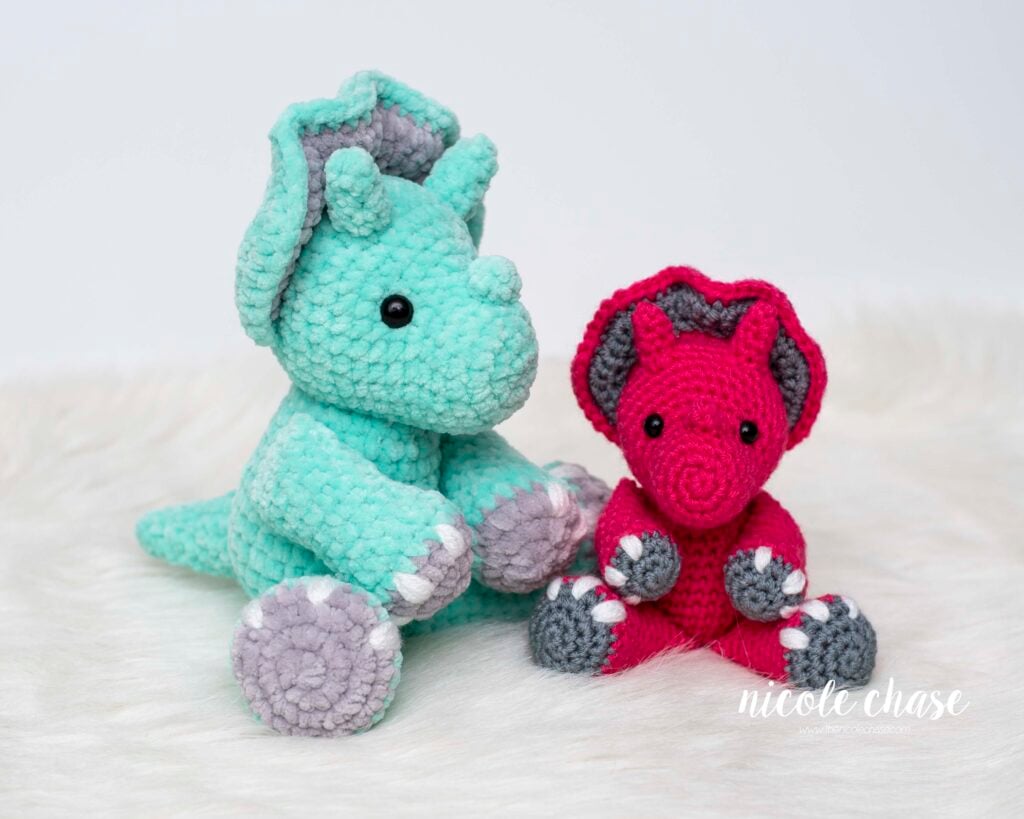
Table of Contents
I hope you enjoy this free crochet pattern available here on my blog! An ad-free, formatted PDF version of this crochet pattern is also available for purchase here:
If you like this free mini triceratops crochet pattern, be sure to check out all of my other crochet dinosaur patterns here.
Be sure to add this Mini Tanner the Triceratops crochet pattern to your project queue on Ravelry.
Pin this mini triceratops pattern on Pinterest.
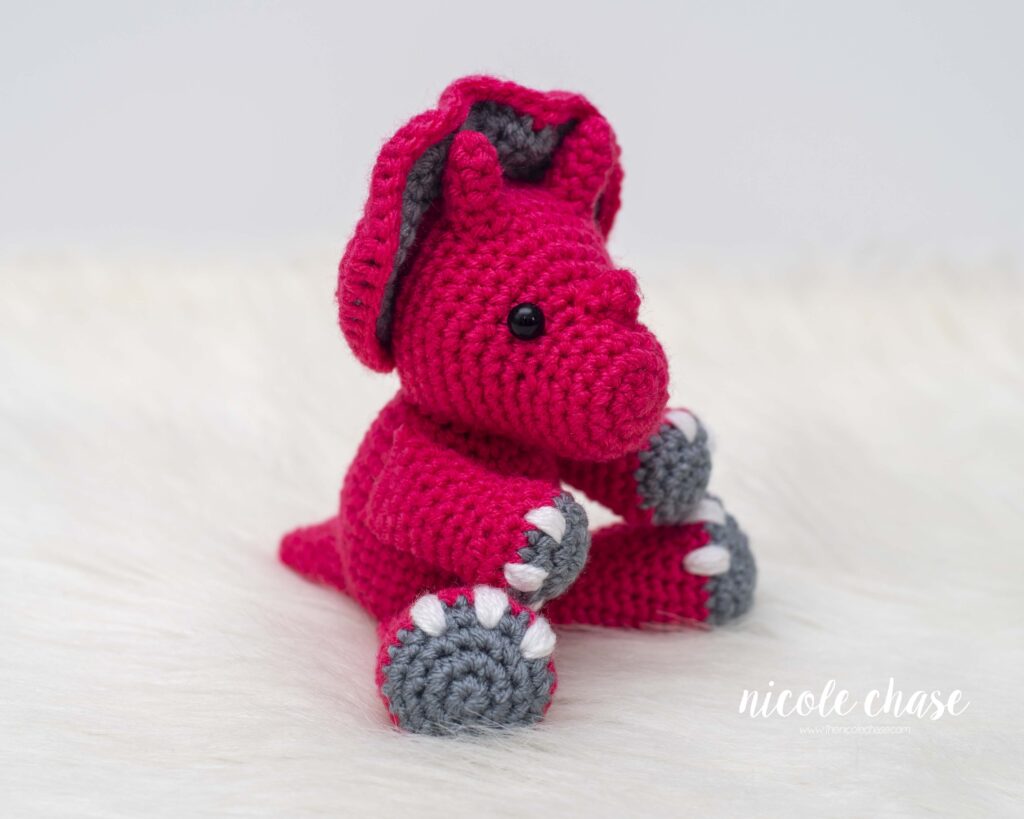
I would classify this small triceratops crochet pattern as “advanced beginner”. It would be helpful to have had some experience with amigurumi before creating this project.
Free Crochet Pattern for Mini Tanner the Triceratops

Pattern Specifics
Measurements: Approximately 6” tall (sitting) or 8” tall (standing)
Gauge: Not necessary for this pattern; see notes
Hook Size: 4.0mm (G) crochet hook
Other Tools: tapestry needle, stitch markers, scissors
Yarn Weight: Medium (4) Worsted Weight
Yarn Used: WeCrochet/Knit Picks Brava Worsted
Yardage: color A (pink): 100 yds, color B (gray): 18 yds, color C (white): 4 yds
Other Materials: poly-fil stuffing, 9mm safety eyes
Stitch Abbreviations
st = stitch
sl st = slip stitch
ch = chain
SC = single crochet
SC2tog = single crochet 2 stitches together (invisible decrease is recommended)
FSC = foundation single crochet
Special Stitches
SC2tog (using invisible decrease method): Insert hook into front loop of the first stitch. Insert hook into front loop of second stitch. Yarn over. Draw through the first two loops on hook. Yarn over. Draw through both loops on hook.
Notes
- Checking your gauge is not required for this pattern. Use a hook that is smaller than the size recommended for your yarn weight. This will ensure that your stuffing will not show through the stitches.
- All pieces, with the exception of the frill, are worked in the round. Use a stitch marker to indicate the beginning of each round.
- Invisible decreases are recommended. Please see “Special Stitches”.
- Safety eyes and noses pose a choking risk for babies; therefore, if making this toy for a baby, I recommend using yarn, felt, or embroidered details.
- Body, head, legs, arms, tail, and horns require stuffing. Stuff each piece as you work to ensure the piece is completely filled. Do not add stuffing to the frill.
- See tutorial photos.
Pattern
Using 4.0mm (G) crochet hook:
Body
Using color A (shown as pink):
R1: Begin with 6 SC in a magic ring. (6 sts)
R2: 2 SC in each st around. (12 sts)
R3: *2 SC in next st, 1 SC in next st. Repeat from * around. (18 sts)
R4: *2 SC in next st, 1 SC in each of the next 2 sts. Repeat from * around. (24 sts)
R5: *2 SC in next st, 1 SC in each of the next 3 sts. Repeat from * around. (30 sts)
R6-11: 1 SC in each st around. (30 sts)
R12: *SC2tog, 1 SC in each of the next 3 sts. Repeat from * around. (24 sts)
R13-15: 1 SC in each st around. (24 sts)
R16: *SC2tog, 1 SC in each of the next 2 sts. Repeat from * around. (18 sts)
Cut yarn, leaving long strand for sewing. Fasten off.
Fill with stuffing.
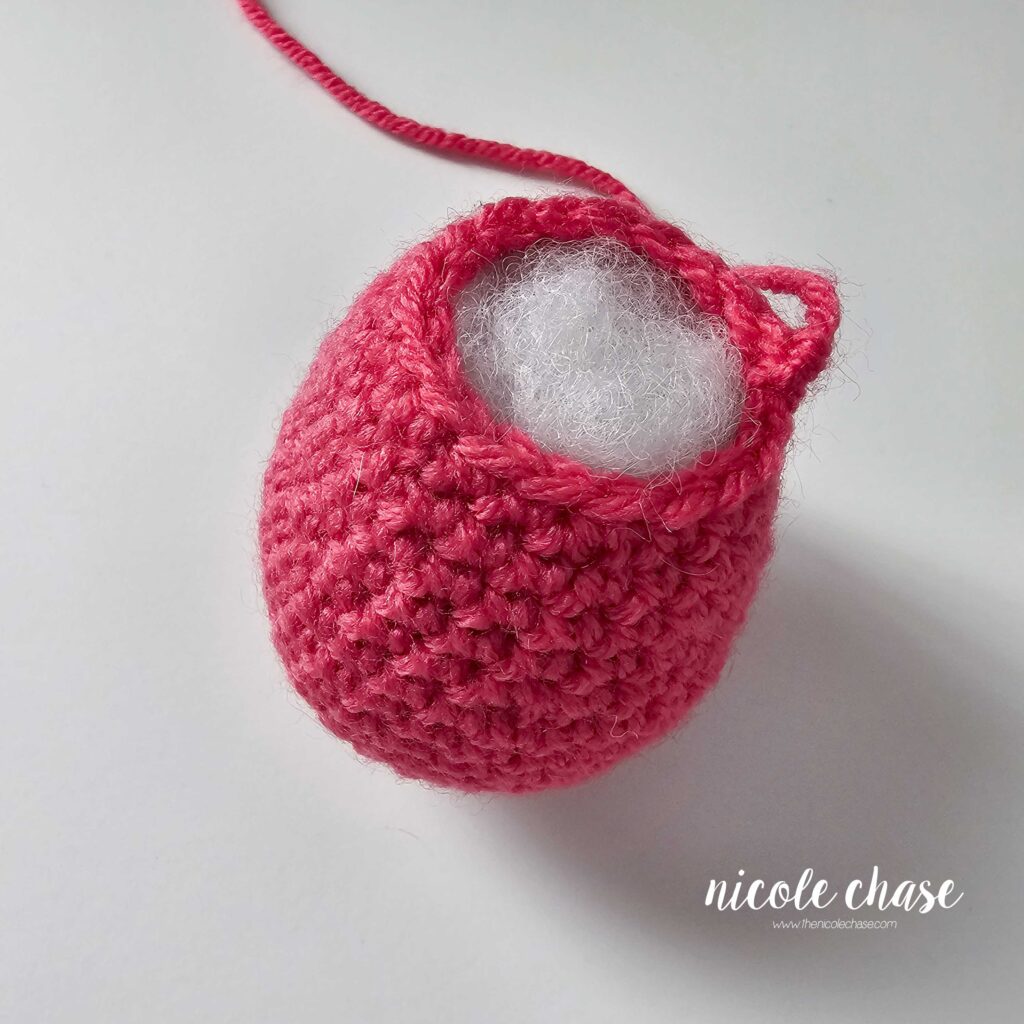
Head
Using color A (shown as pink):
R1: Begin with 6 SC in a magic ring. (6 sts)
R2: 2 SC in each st around. (12 sts)
R3: *2 SC in next st, 1 SC in next st. Repeat from * around. (18 sts)
R4-6: 1 SC in each st around. (18 sts)
R7: *2 SC in next st, 1 SC in each of the next 2 sts. Repeat from * an additional 2 times. 1 SC in each of the next 9 sts around. (21 sts)
R8: *2 SC in next st, 1 SC in each of the next 3 sts. Repeat from * an additional 2 times. 1 SC in each of the next 9 sts around. (24 sts)
R9: *2 SC in next st, 1 SC in each of the next 4 sts. Repeat from * an additional 2 times. 1 SC in each of the next 9 sts around. (27 sts)
R10: *2 SC in next st, 1 SC in each of the next 5 sts. Repeat from * an additional 2 times. 1 SC in each of the next 9 sts around. (30 sts)
R11: *2 SC in next st, 1 SC in each of the next 4 sts. Repeat from * an additional 2 times. Add a st marker to the last worked st. **2 SC in next st, 1 SC in each of the next 4 sts. Repeat from ** an additional 2 times. (36 sts)
The added st marker, and the st marker at the beginning of this round helps to indicate the front sides of the face. The first sequence of sts between the first and second st markers indicates the top of the head. The second sequence of sts between the second and first st markers indicates the bottom of the head. If using safety eyes, insert eyes between R8 and R9, with 7 sts between. You can now remove your second st marker. See tutorial photos.
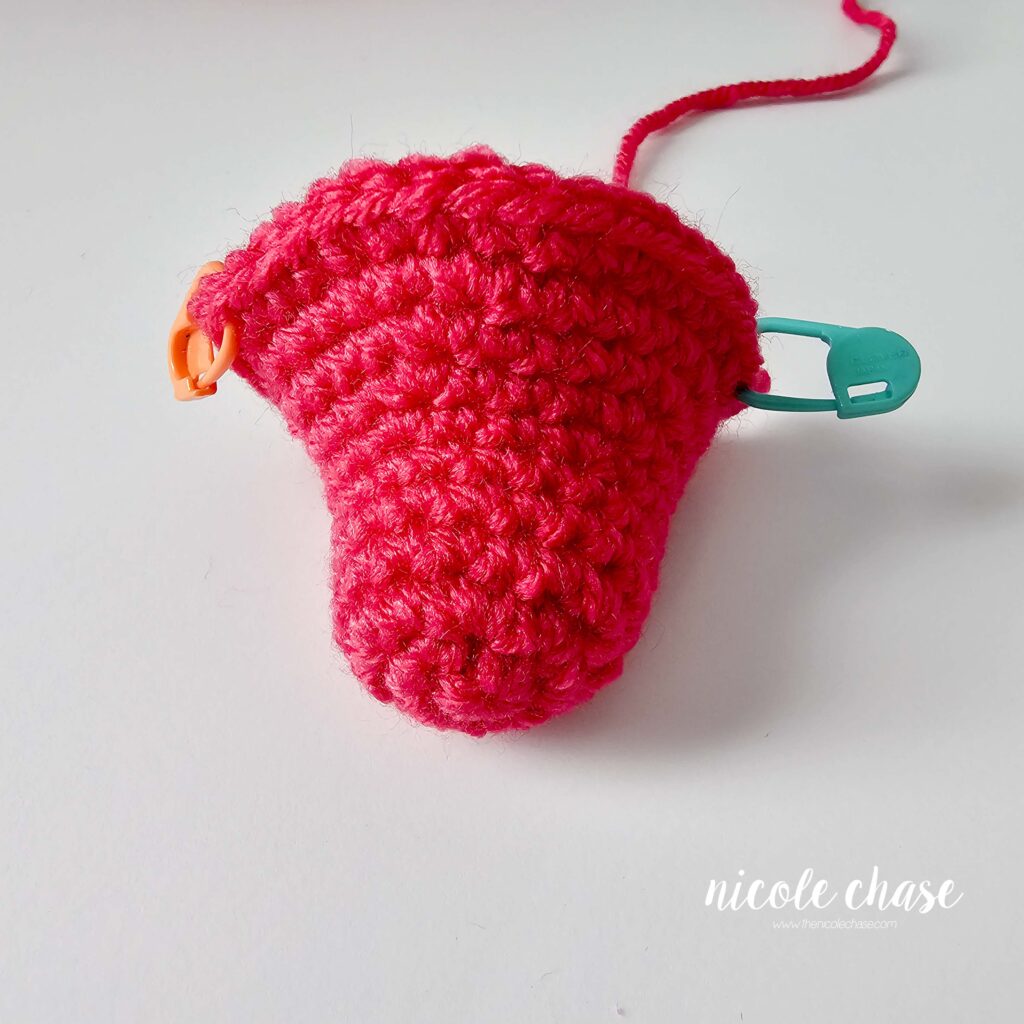
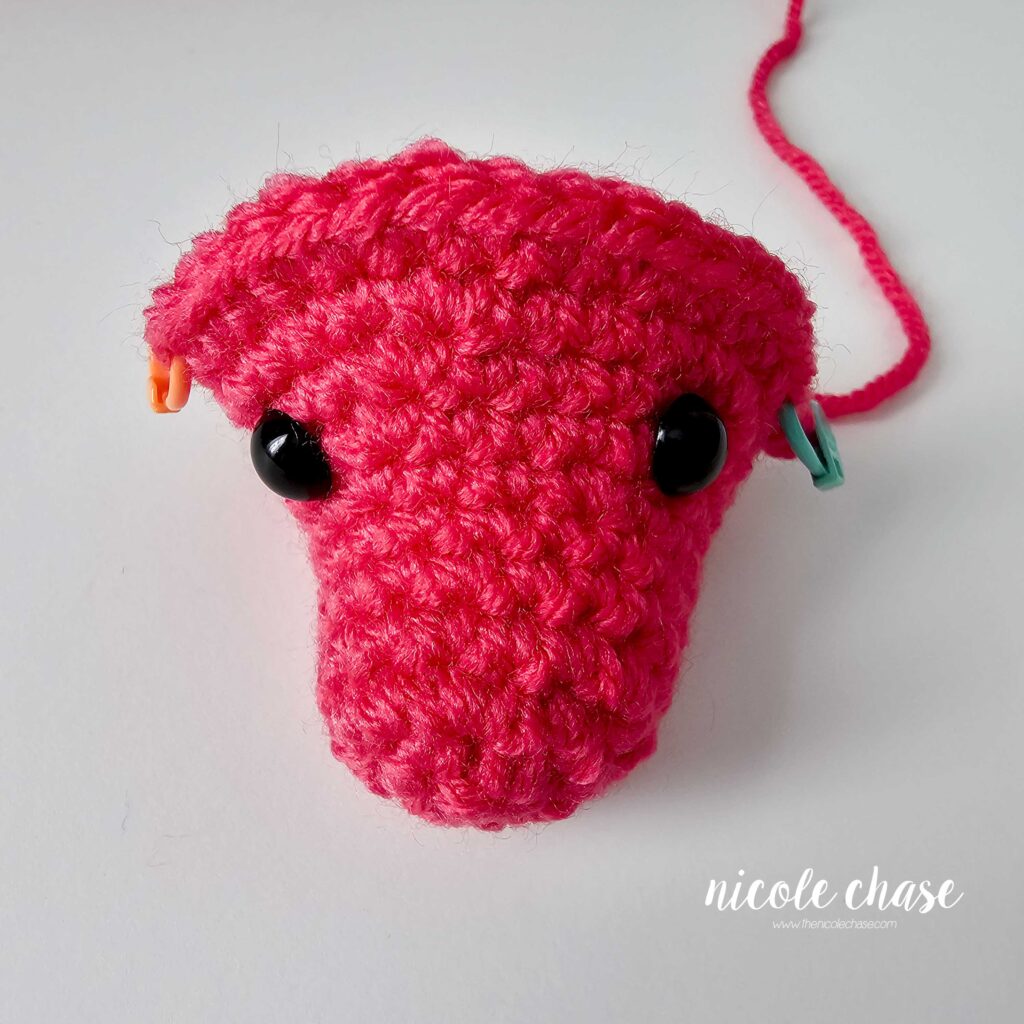
R12-15: 1 SC in each st around. (36 sts)
R16: *SC2tog, 1 SC in each of the next 4 sts. Repeat from * around. (30 sts)
R17: *SC2tog, 1 SC in each of the next 3 sts. Repeat from * around. (24 sts)
R18: 1 SC in each st around. (24 sts)
R19: *SC2tog, 1 SC in each of the next 2 sts. Repeat from * around. (18 sts)
R20: *SC2tog, 1 SC in next st. Repeat from * around. (12 sts)
Fill head with stuffing.
R21: *SC2tog. Repeat from * around. (6 sts)
Cut yarn, weave yarn in and out of remaining sts. Pull tight to close. Tie off and weave in ends.
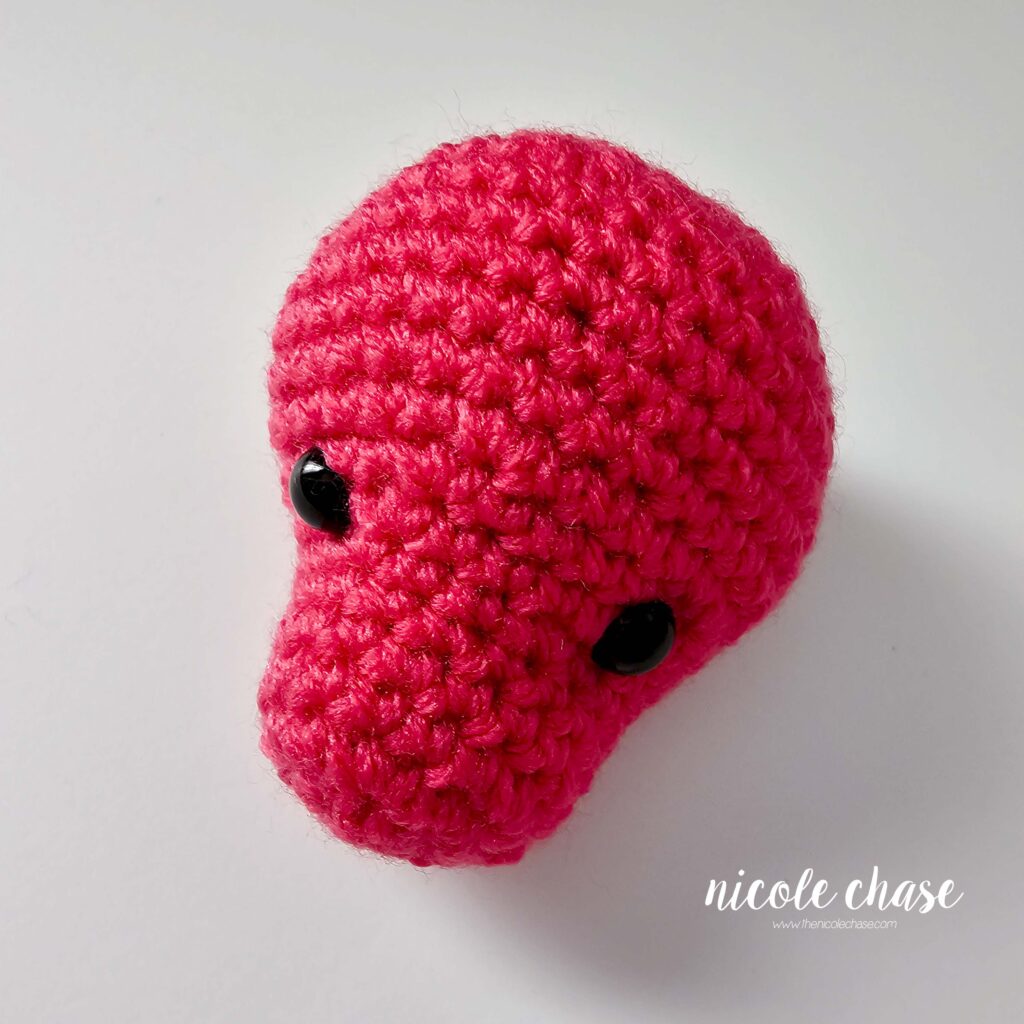
Small Horn
Using color A (shown as pink):
R1: Begin with 4 SC in a magic ring. (4 sts)
R2: 1 SC in each st around. (4 sts)
Cut yarn, leaving long strand for sewing. Fasten off.
Large Horns (make 2)
Using color A (shown as pink):
R1: Begin with 4 SC in a magic ring. (4 sts)
R2: 1 SC in each st around. (4 sts)
R3: *2 SC in next st, 1 SC in next st. Repeat from * around. (6 sts)
R4-5: 1 SC in each st around. (6 sts)
Cut yarn, leaving long strand for sewing. Fasten off.
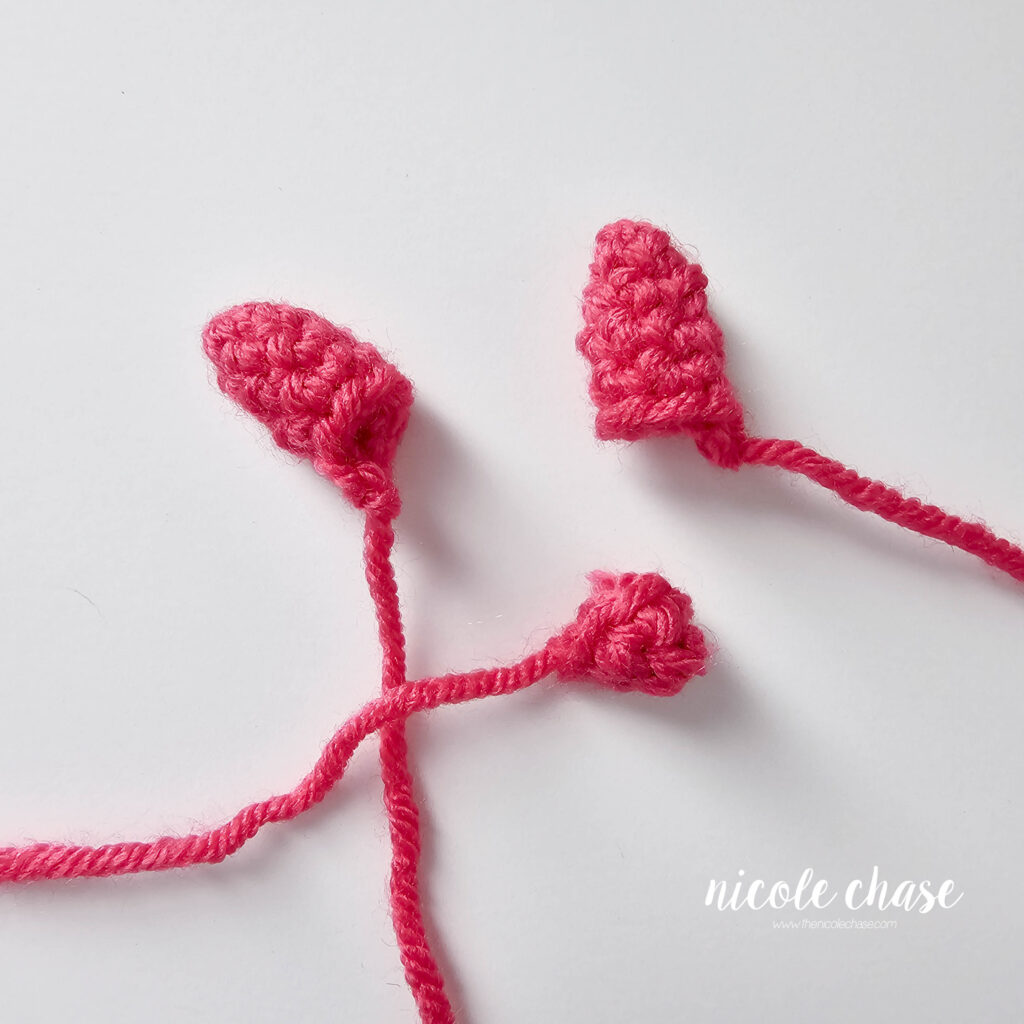
Frill Front
NOTE: When working the frill, be sure to complete the entire repeat. The repeat both starts and ends with 2SC. Therefore, when working the full sequence of stitches, followed by the same sequence of stitches, the row will look something like this: (2SC, 1SC, 2SC), (2SC, 1SC, 2SC), (2SC, 1SC, 2 SC), and so on.
*** NOTE: The foundation single crochet stitch is preferred; however, you could alternatively replace R1 with: Ch 19, SC in second ch from hook and each ch to end. (18 sts), and then proceed as written with R2.
Using color B (shown as gray):
R1: 18 FSC. (18 sts)
R2: Ch 1, turn. *2 SC in next st, 1 SC in next st, 2 SC in next st. Repeat from * across. (30 sts)
R3: Ch 1, turn. *2 SC in next st, 1 SC in each of the next 3 sts, 2 SC in next st. Repeat from * across. (42 sts)
Cut yarn and fasten off.
Frill Back
Using color A (shown as pink):
R1: 18 FSC. (18 sts)
R2: Ch 1, turn. *2 SC in next st, 1 SC in next st, 2 SC in next st. Repeat from * across. (30 sts)
R3: Ch 1, turn. *2 SC in next st, 1 SC in each of the next 3 sts, 2 SC in next st. Repeat from * across. (42 sts)
R4: Ch 1, turn. Hold the Frill Front against the Frill Back. Working through each layer, SC around the entire Frill to beginning, working 1 SC in each st, and 3 SC when rounding each of the four corners. See tutorial photos.
Cut yarn, leaving long strand for sewing. Fasten off.
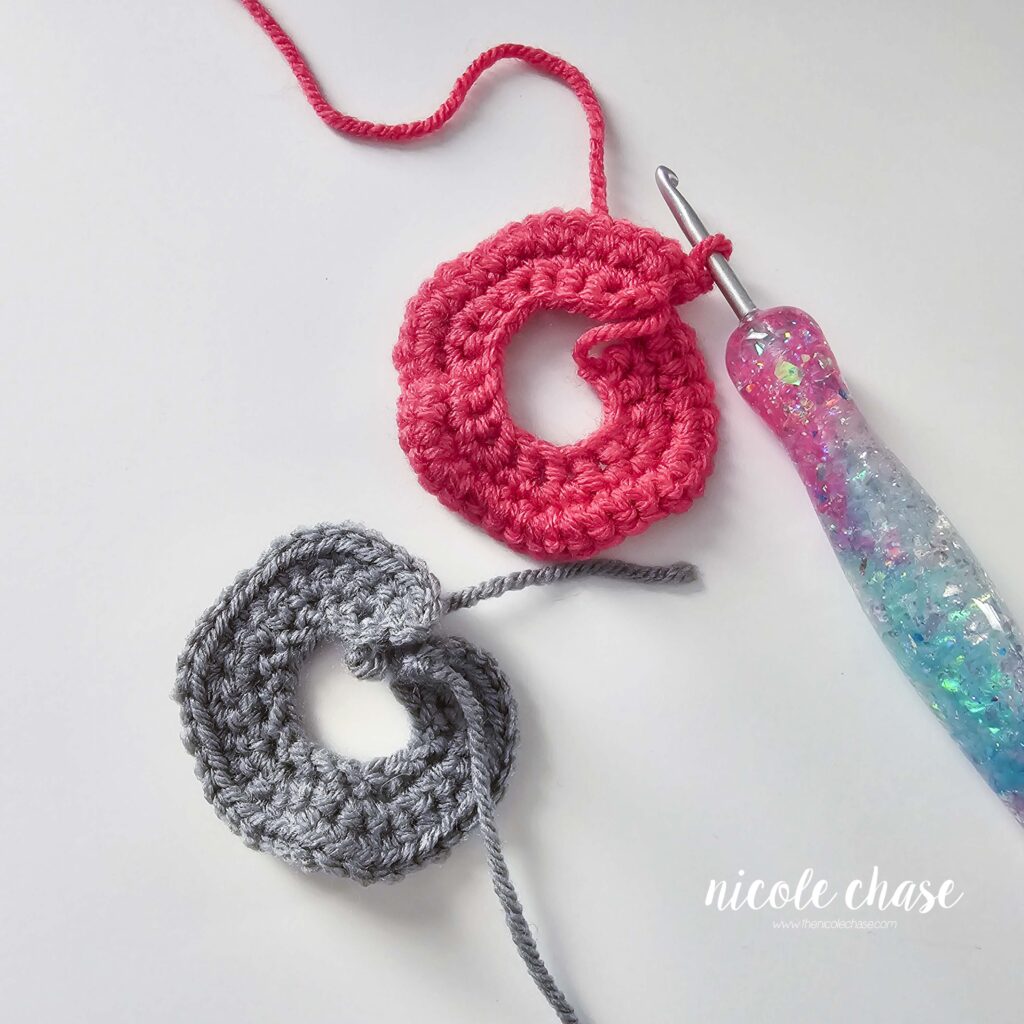
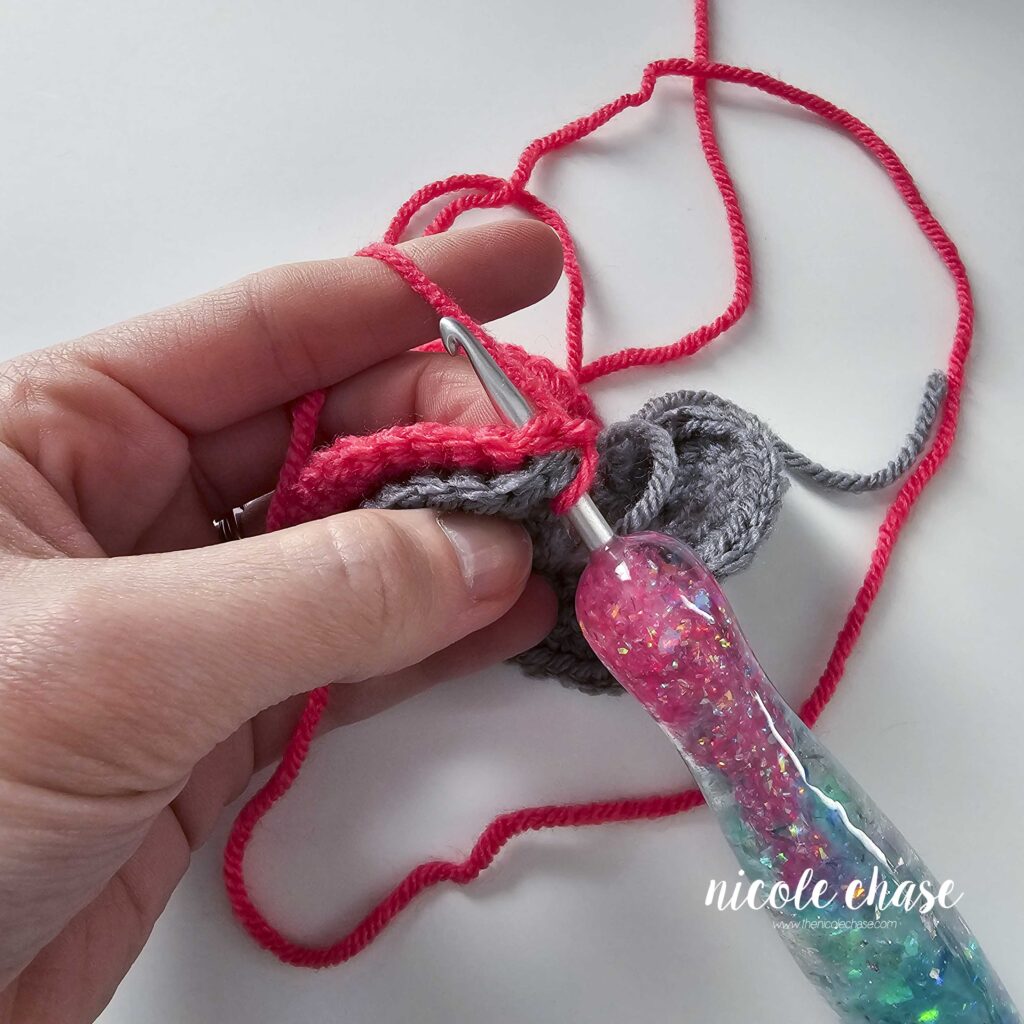
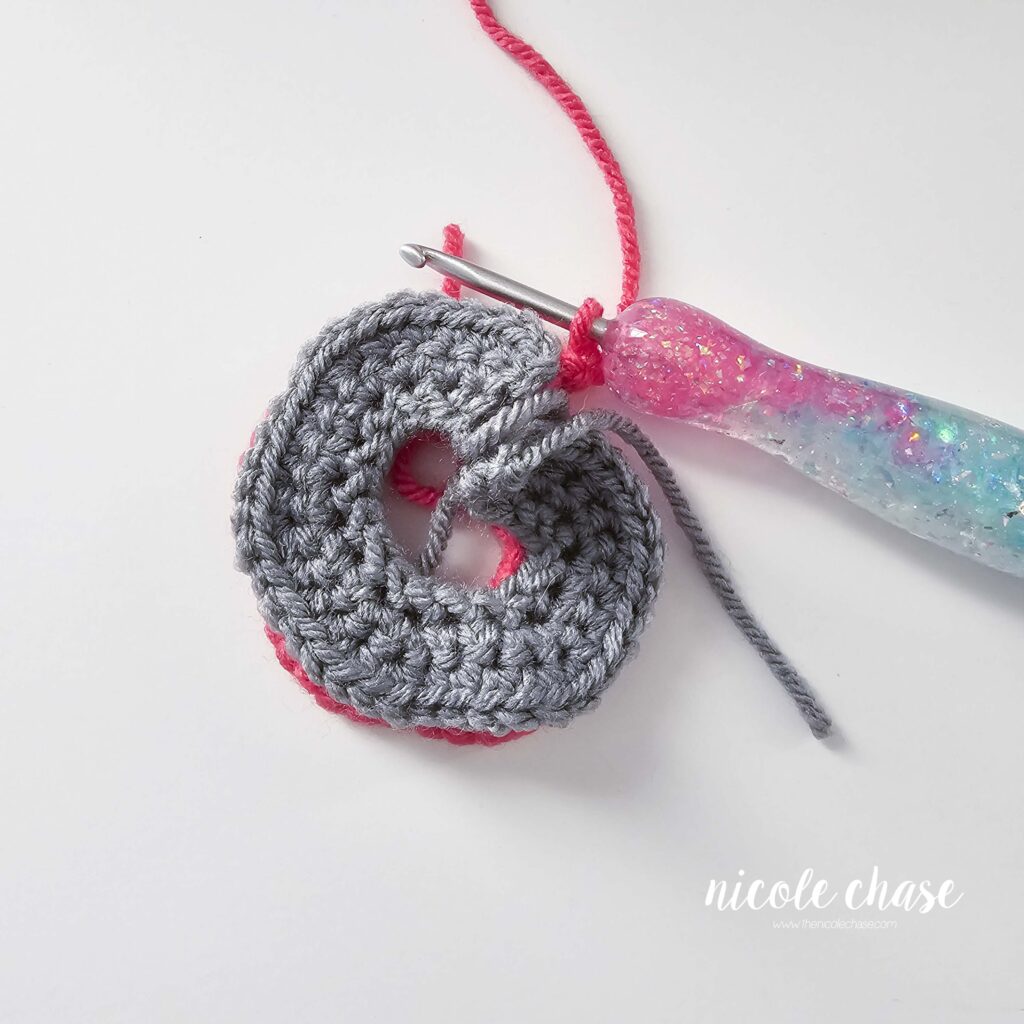
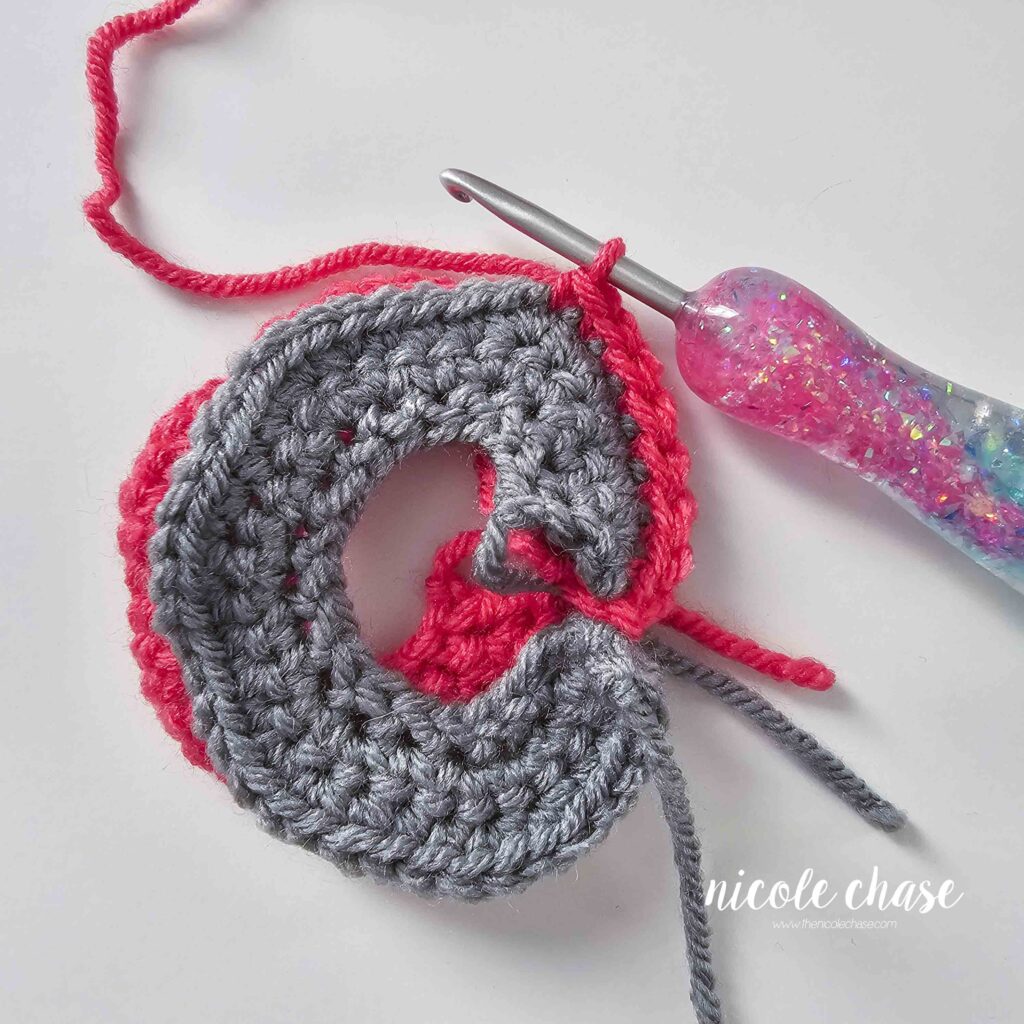
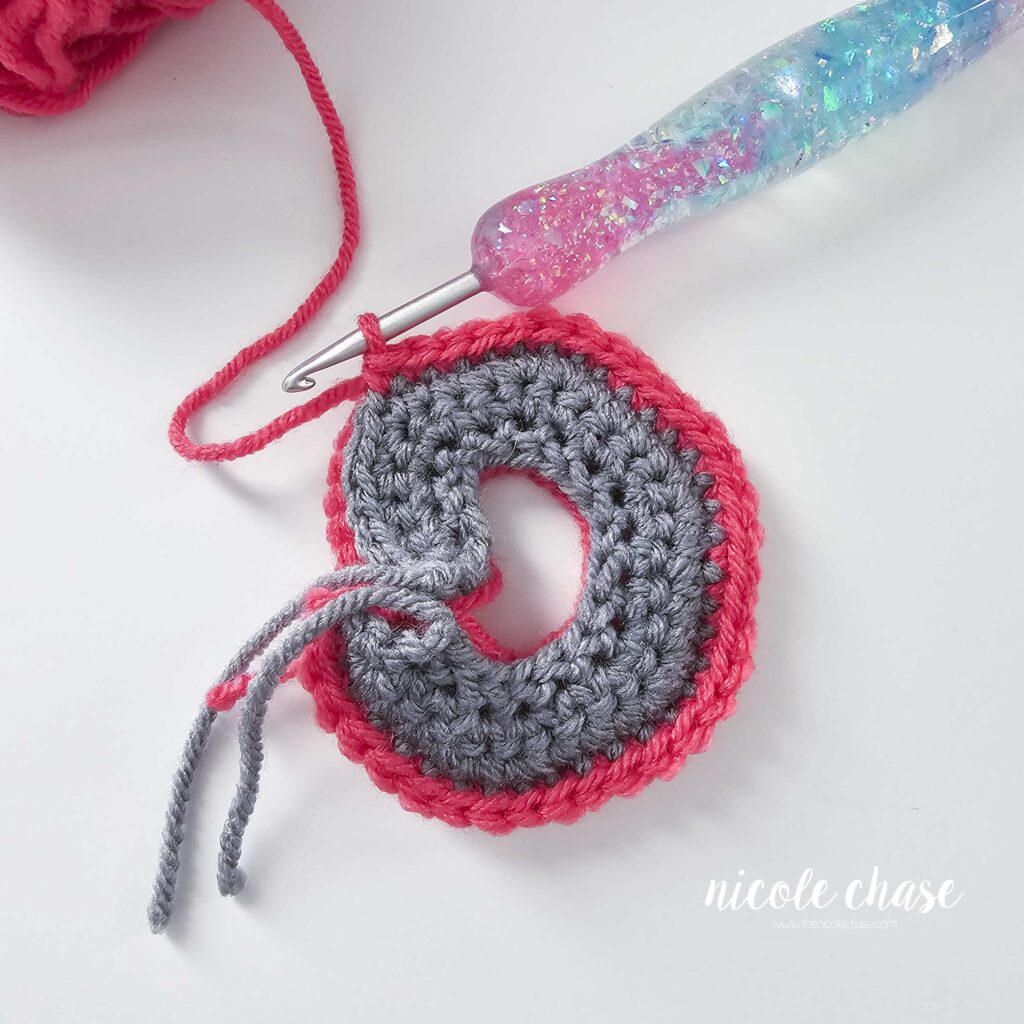
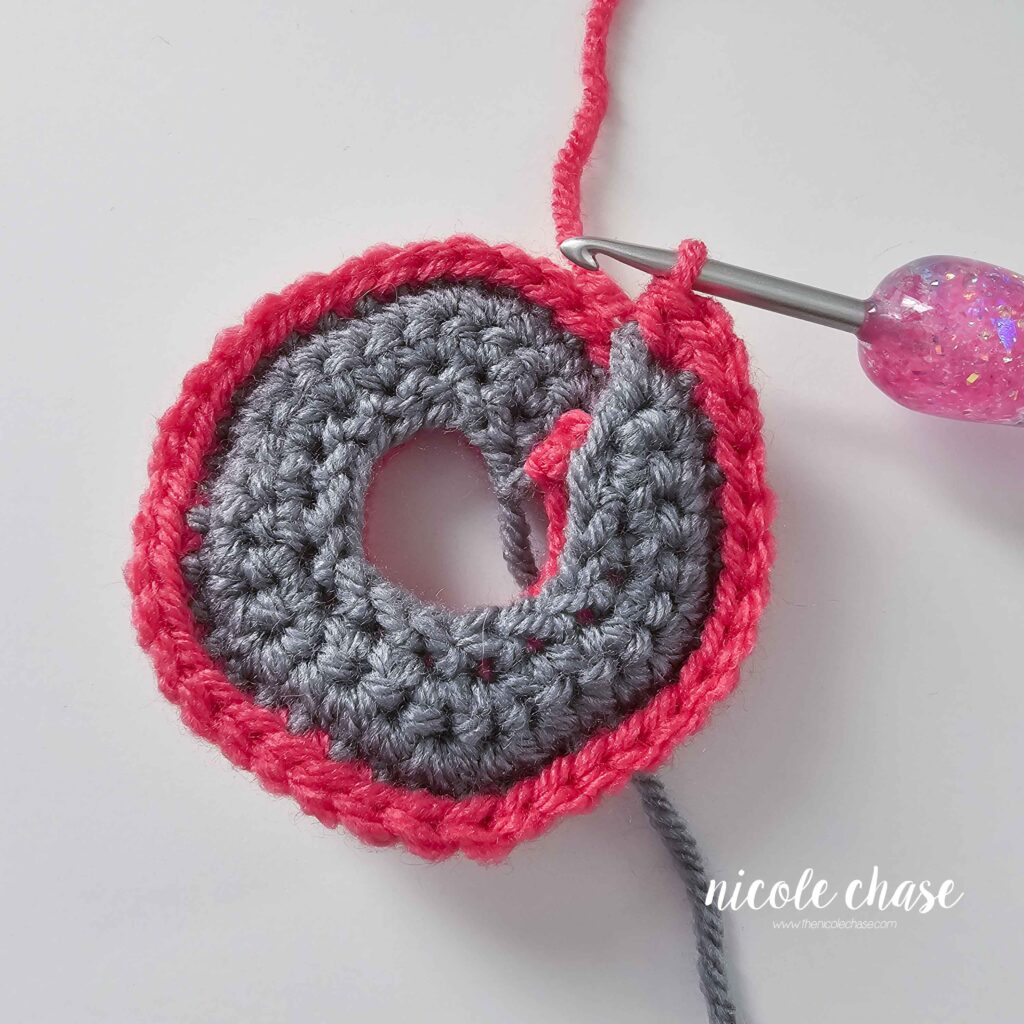
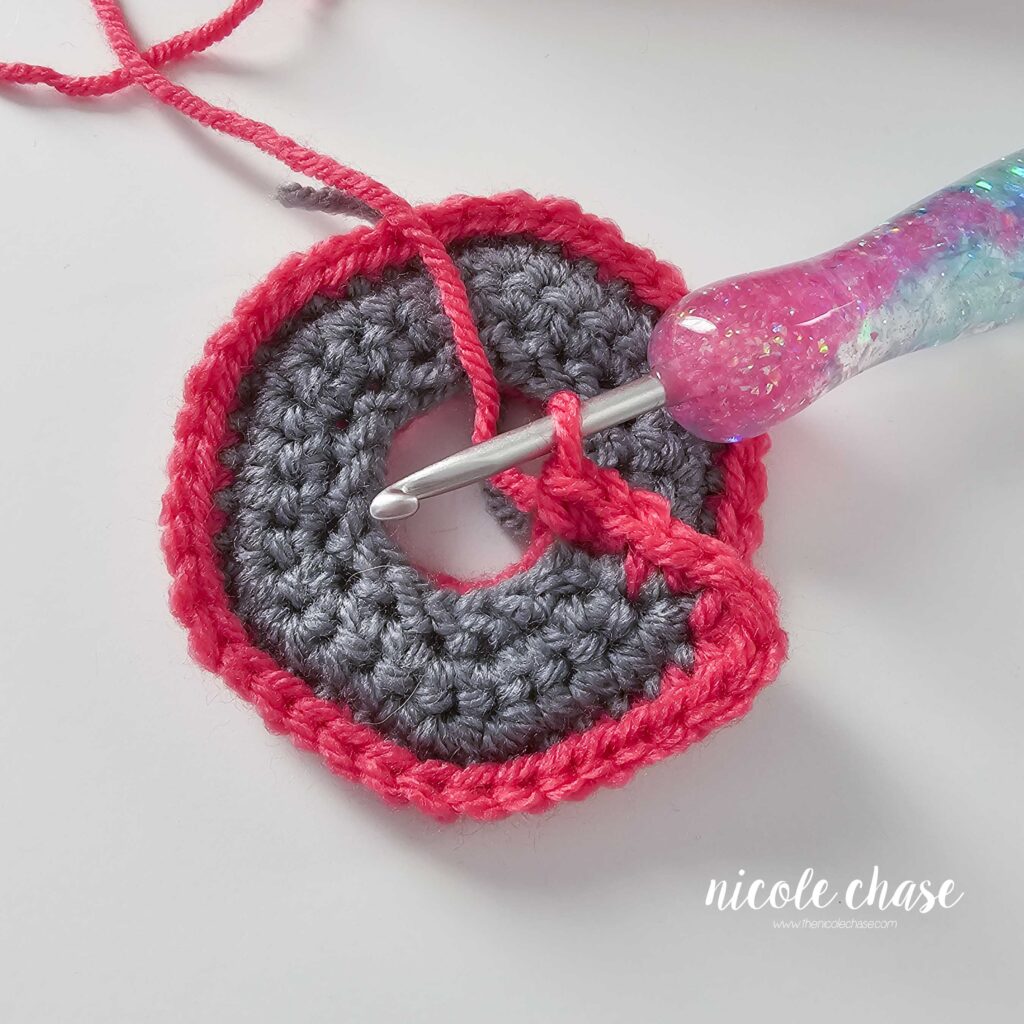
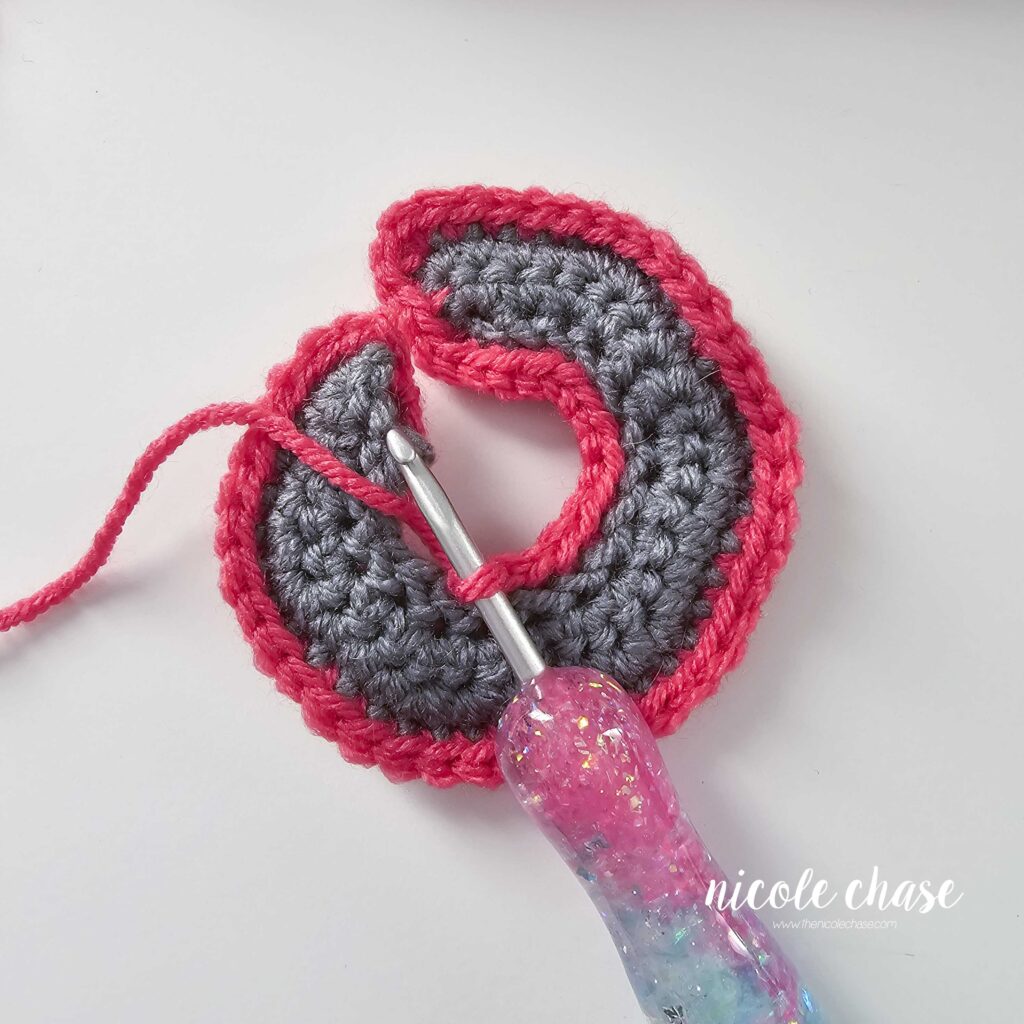
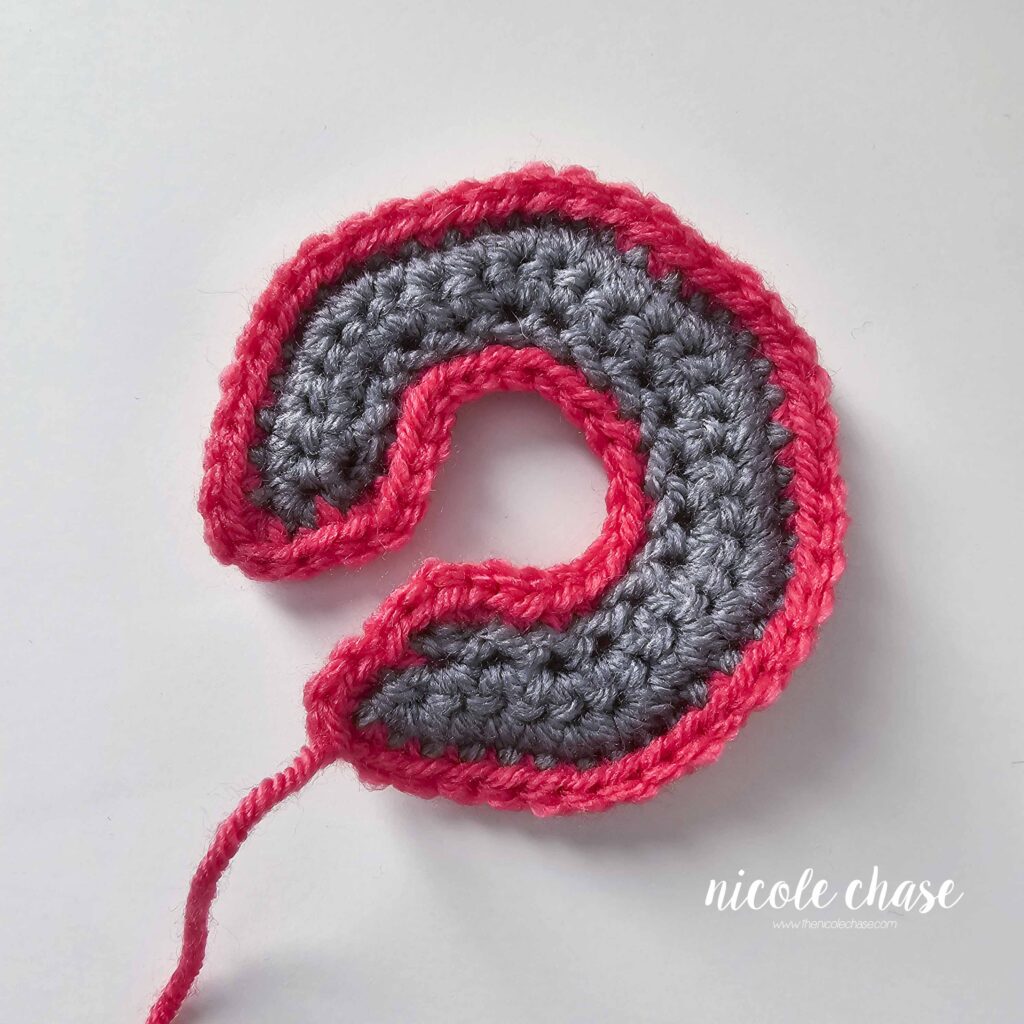
Tail
Using color A (shown as pink):
R1: Begin with 4 SC in a magic ring. (4 sts)
R2: 1 SC in each st around. (4 sts)
R3: *2 SC in next st, 1 SC in next st. Repeat from * around. (6 sts)
R4: 1 SC in each st around. (6 sts)
R5: *2 SC in next st, 1 SC in next st. Repeat from * around. (9 sts)
R6-7: 1 SC in each st around. (9 sts)
R8: *2 SC in next st, 1 SC in each of the next 2 sts. Repeat from * around. (12 sts)
R9: 1 SC in each st around. (12 sts)
R10: *2 SC in next st, 1 SC in each of the next 3 sts. Repeat from * around. (15 sts)
Cut yarn, leaving long strand for sewing. Fasten off.
Fill with stuffing.
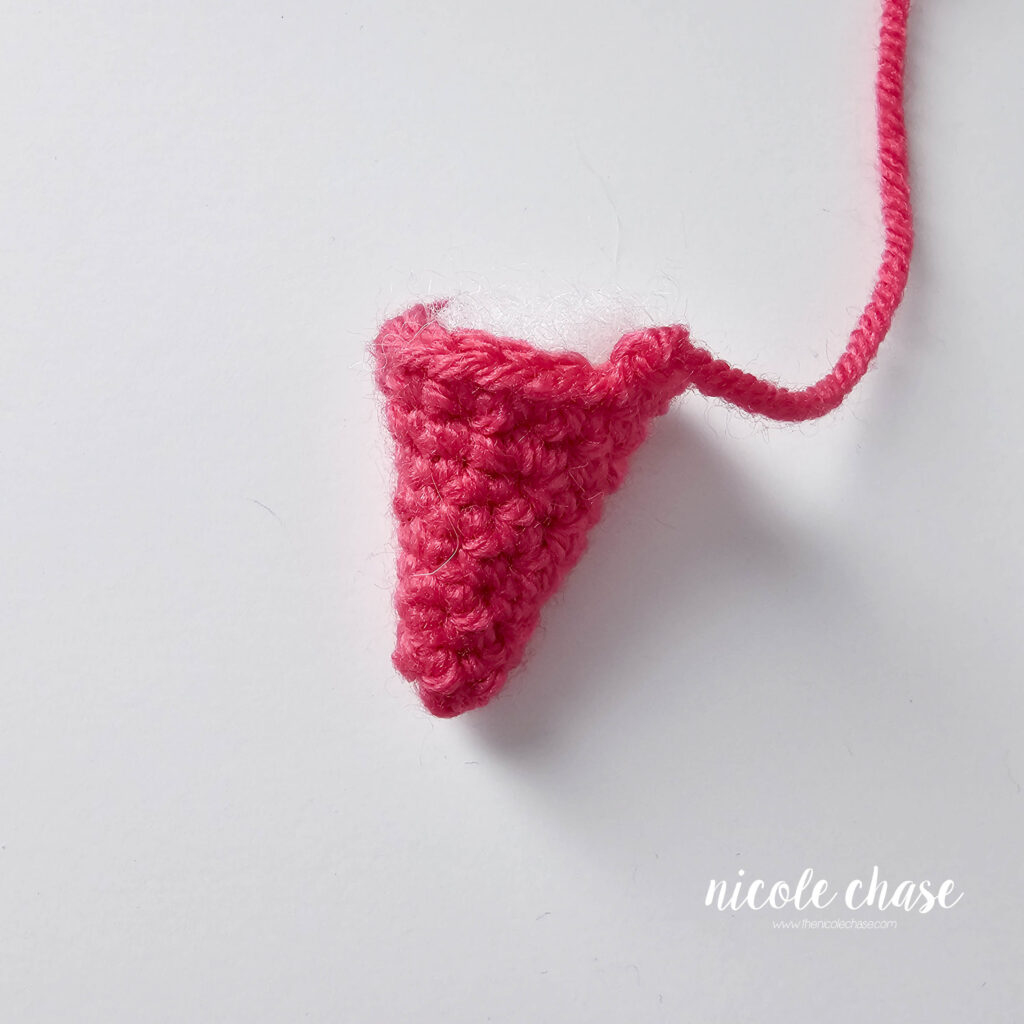
Legs (make 2)
Using color B (shown as gray):
R1: Begin with 6 SC in a magic ring. (6 sts)
R2: 2 SC in each st around. (12 sts)
R3: *2 SC in next st, 1 SC in next st. Repeat from * around. (18 sts)
R4: *2 SC in next st, 1 SC in each of the next 2 sts. Repeat from * around. (24 sts)
Using color A (shown as pink):
R5-6: 1 SC in each st around. (24 sts)
R7: *SC2tog, 1 SC in each of the next 2 sts. Repeat from * around. (18 sts)
R8-9: 1 SC in each st around. (18 sts)
R10: *SC2tog, 1 SC in each of the next 7 sts. Repeat from * around. (16 sts)
R11-15: 1 SC in each st around. (16 sts)
Fill with stuffing.
R16: Fold the leg closed. Working through both sides, 1 SC in each st across, leaving 1 unworked st on each side. See tutorial photos. (7 sts)
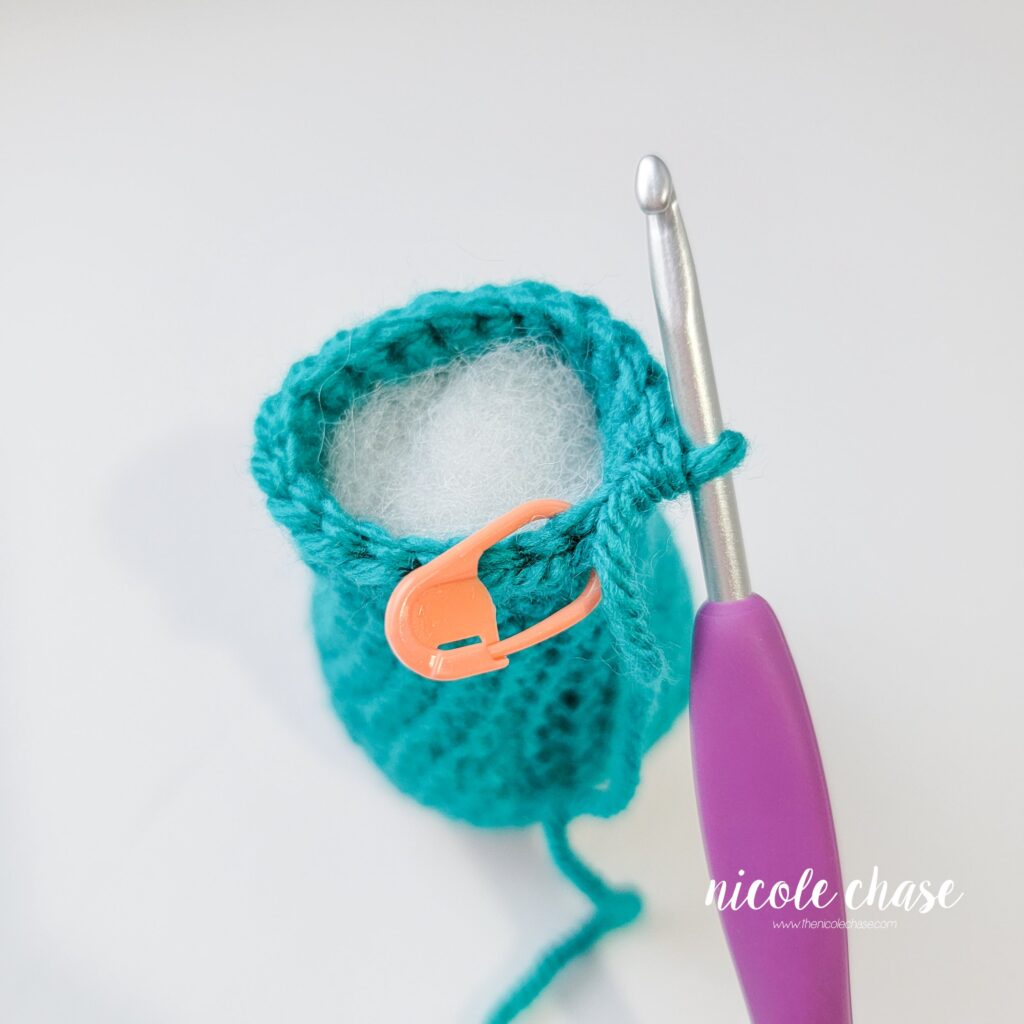
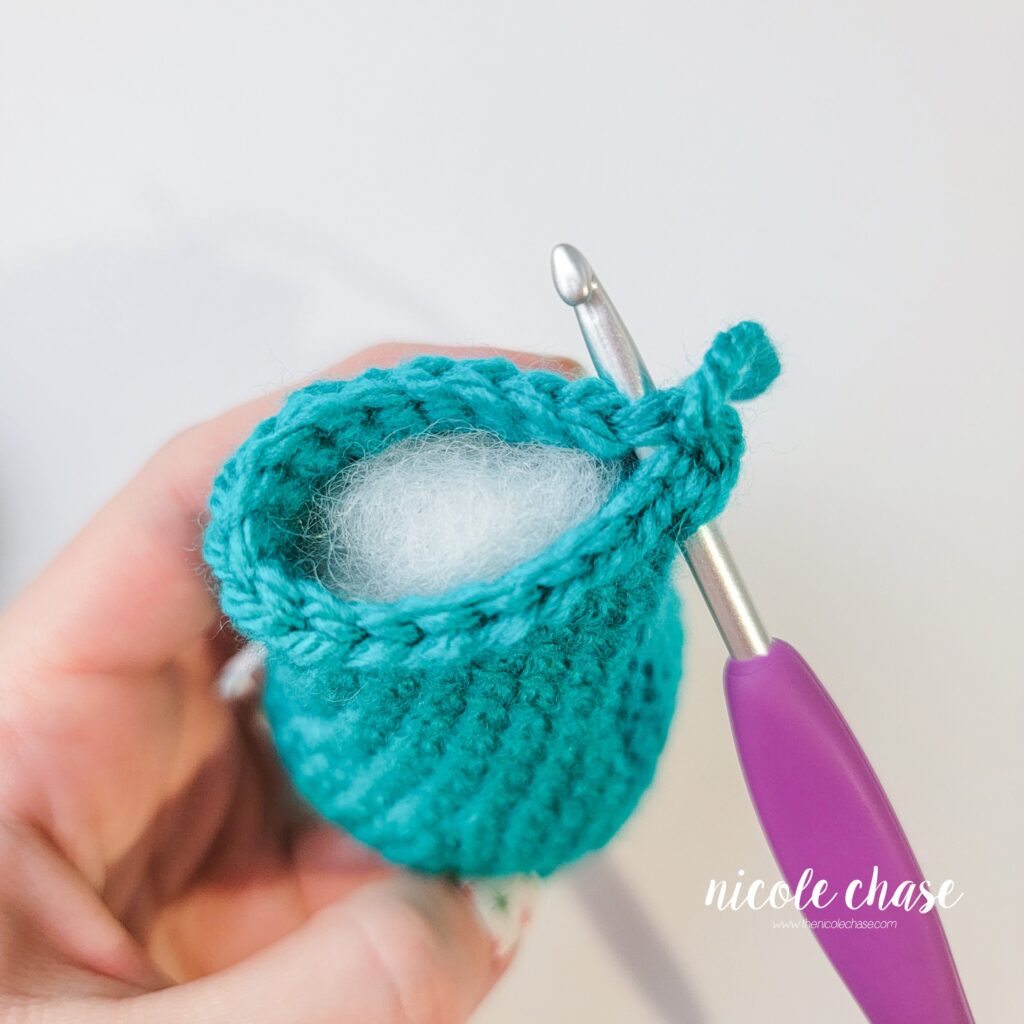
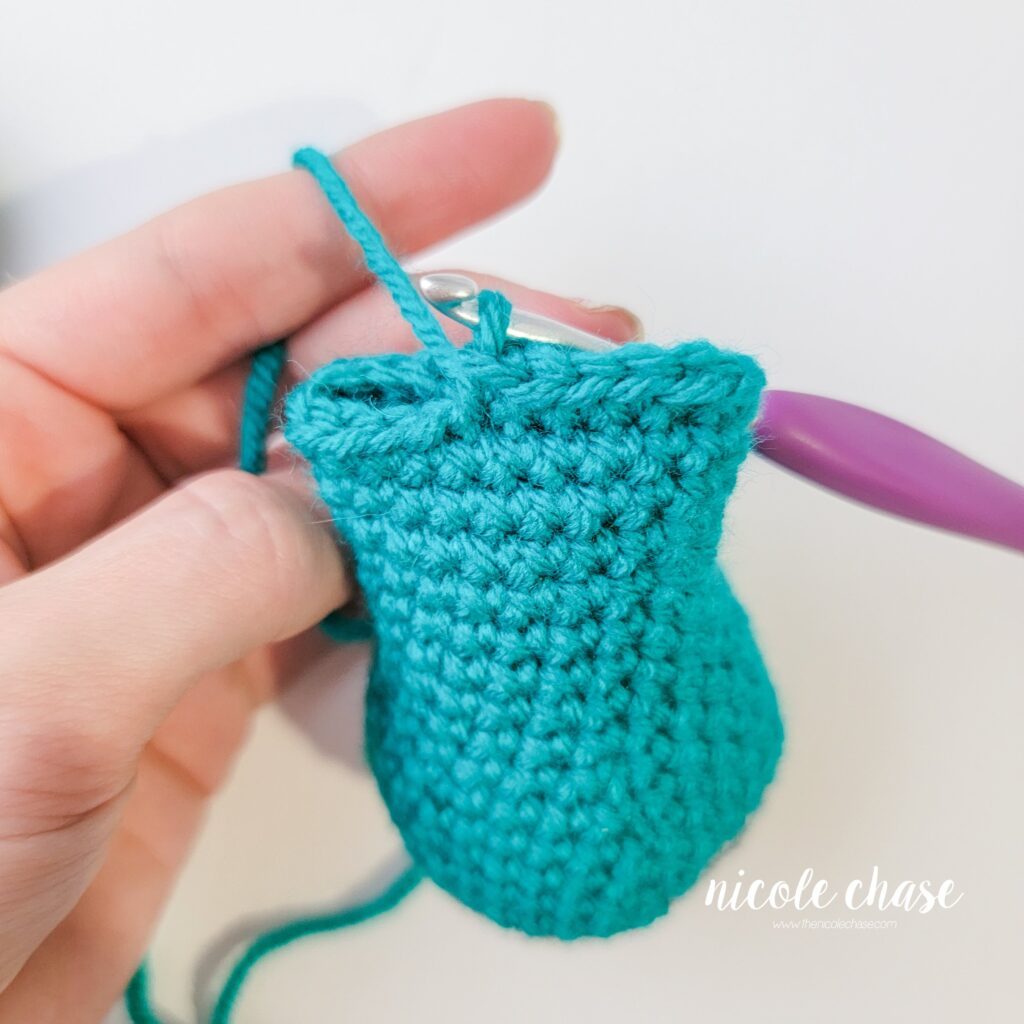
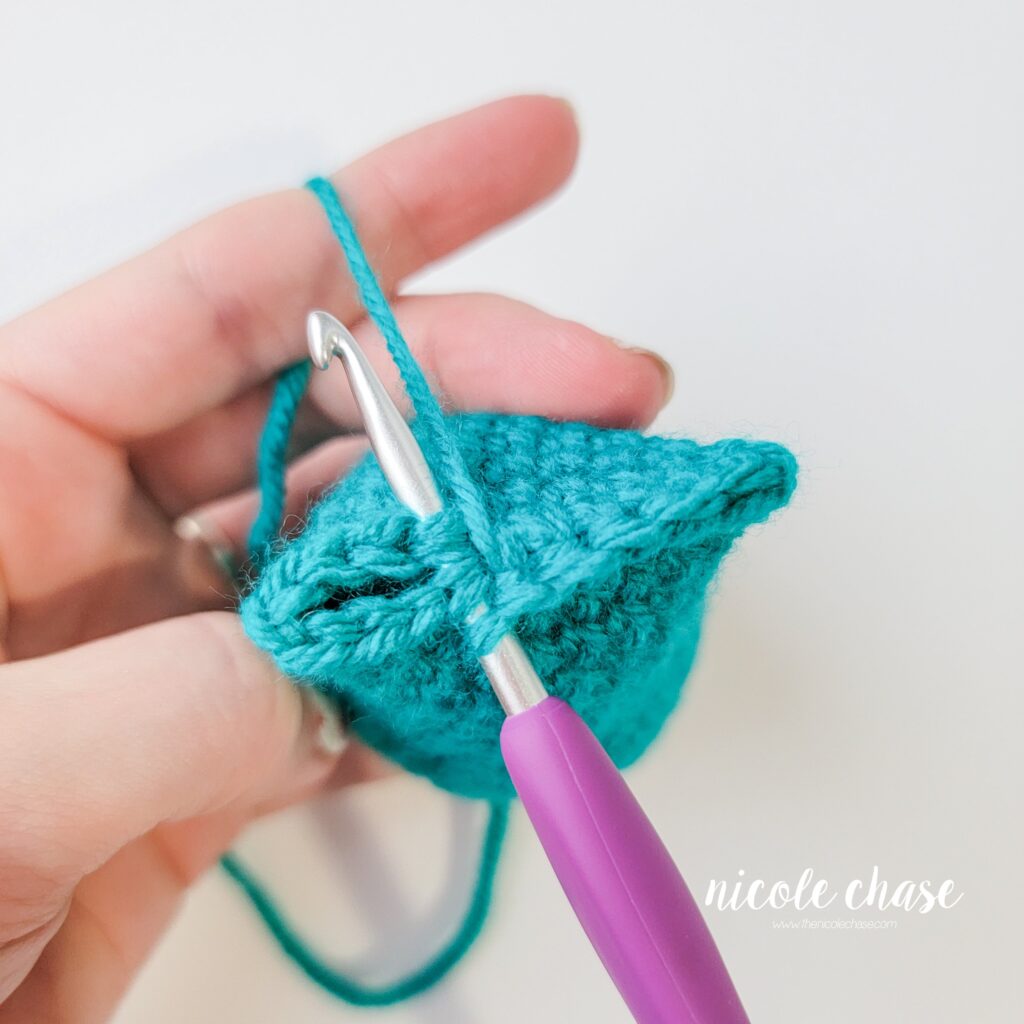
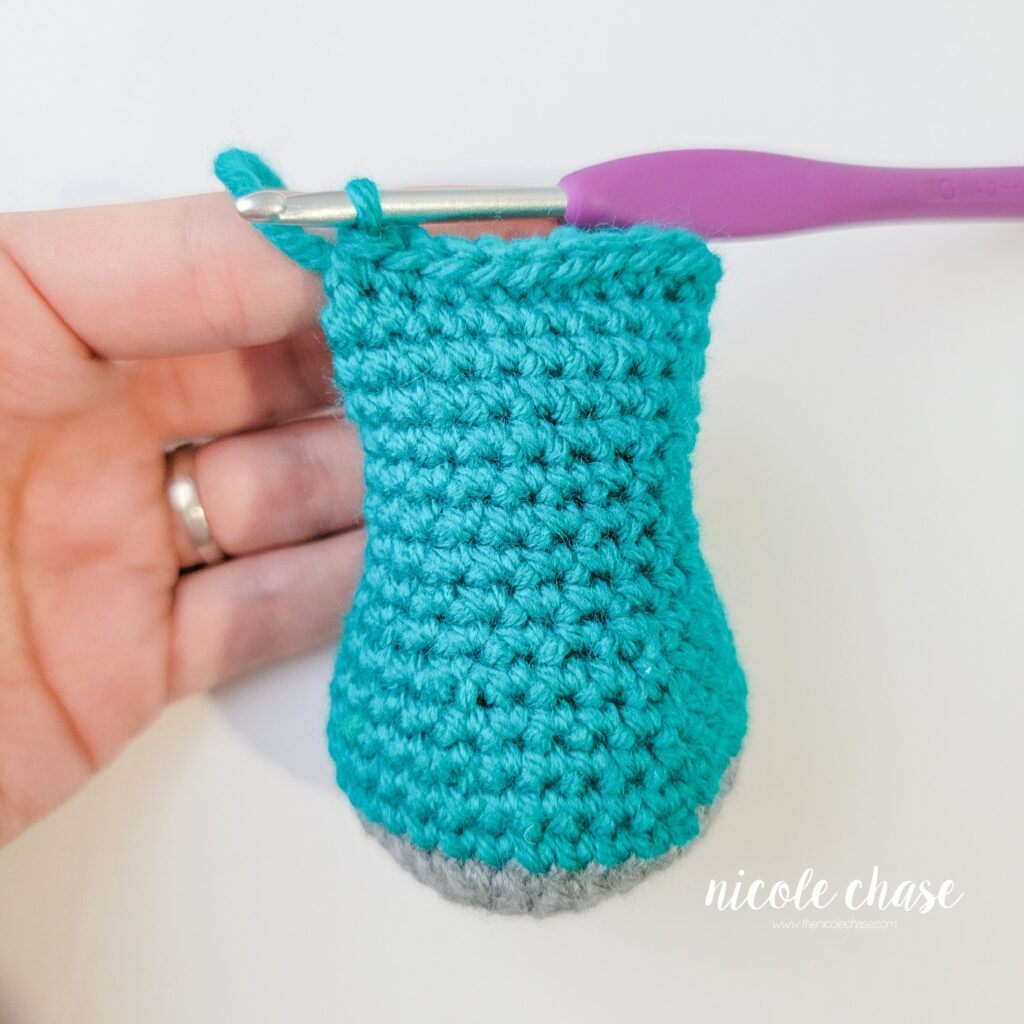
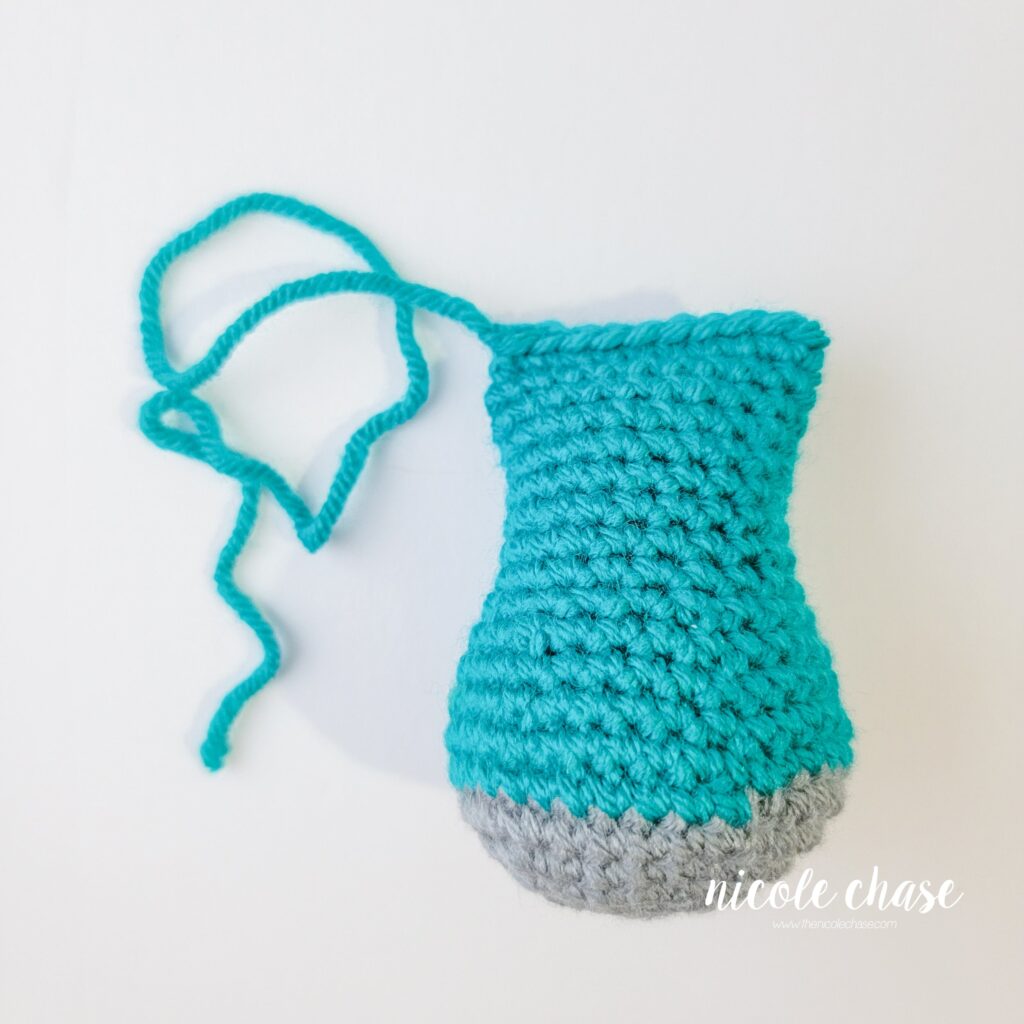
Cut yarn, leaving long strand for sewing. Fasten off.
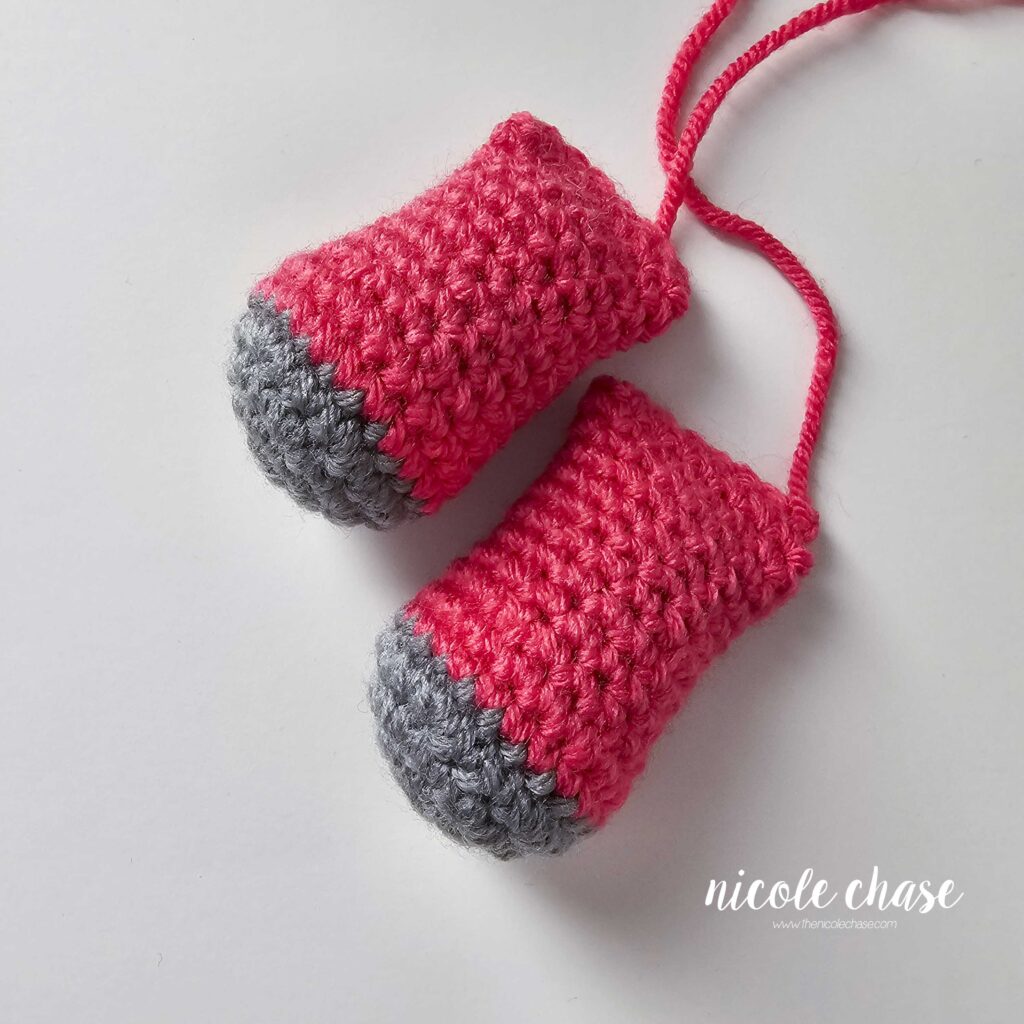
Arms (make 2)
Using color B (shown as gray):
R1: Begin with 6 SC in a magic ring. (6 sts)
R2: 2 SC in each st around. (12 sts)
R3: *2 SC in next st, 1 SC in next st. Repeat from * around. (18 sts)
Using color A (shown as pink):
R4-5: 1 SC in each st around. (18 sts)
R6: *SC2tog, 1 SC in next st. Repeat from * around. (12 sts)
R7-13: 1 SC in each st around. (12 sts)
Fill with stuffing.
R14: Fold the arm closed. Working through both sides, 1 SC in each st across, leaving 1 unworked st on each side. See tutorial photos. (5 sts)
Cut yarn, leaving long strand for sewing. Fasten off.
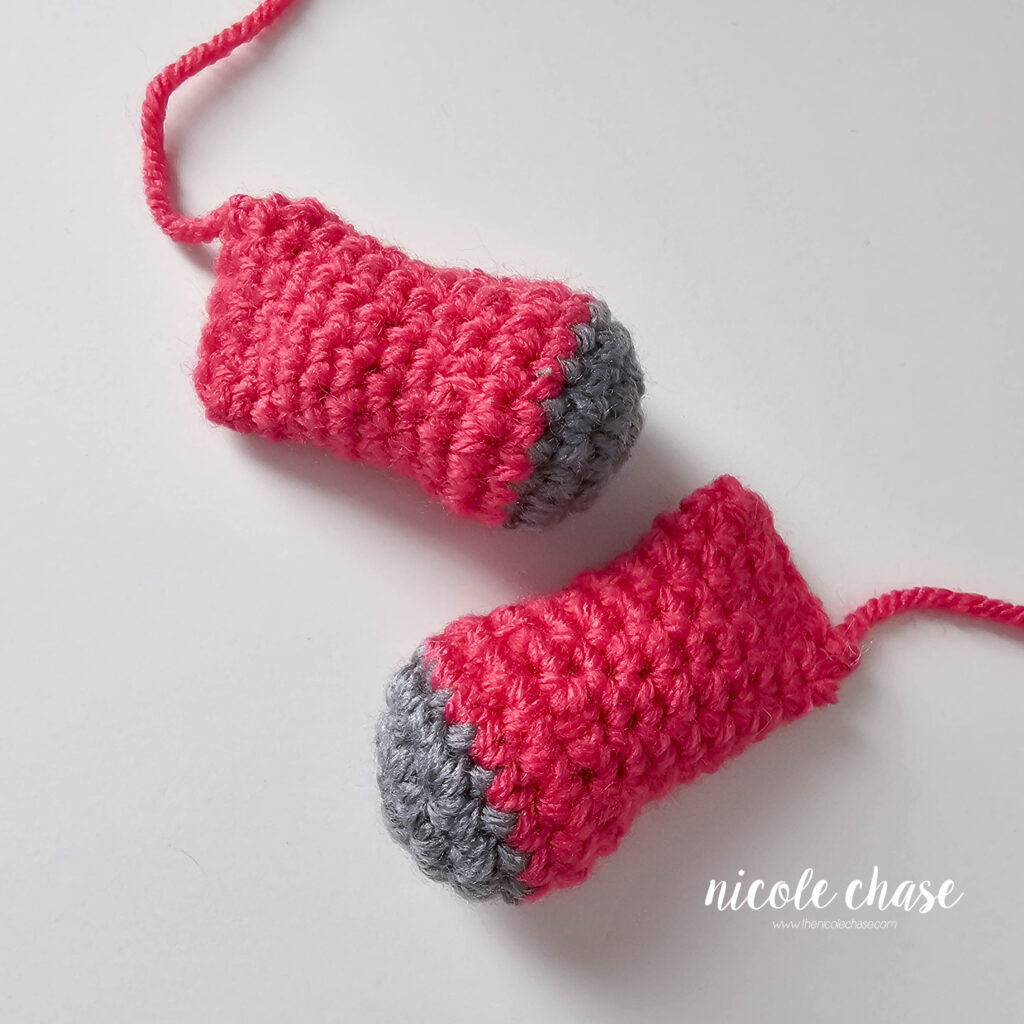
Assembly & Finishing
See tutorial photos.
Attach small horn over R4-5, on the top middle of snout. Attach large horns between R12-14, on the top of the head.
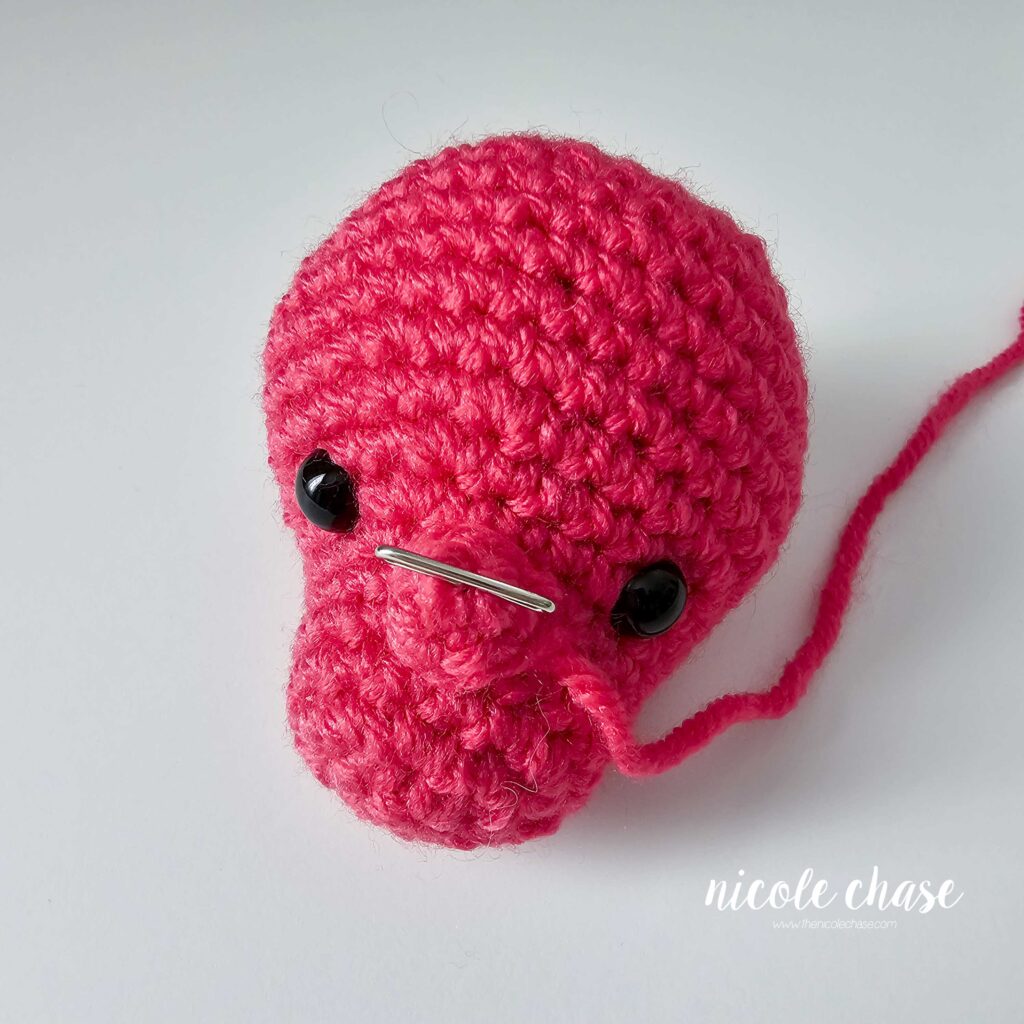
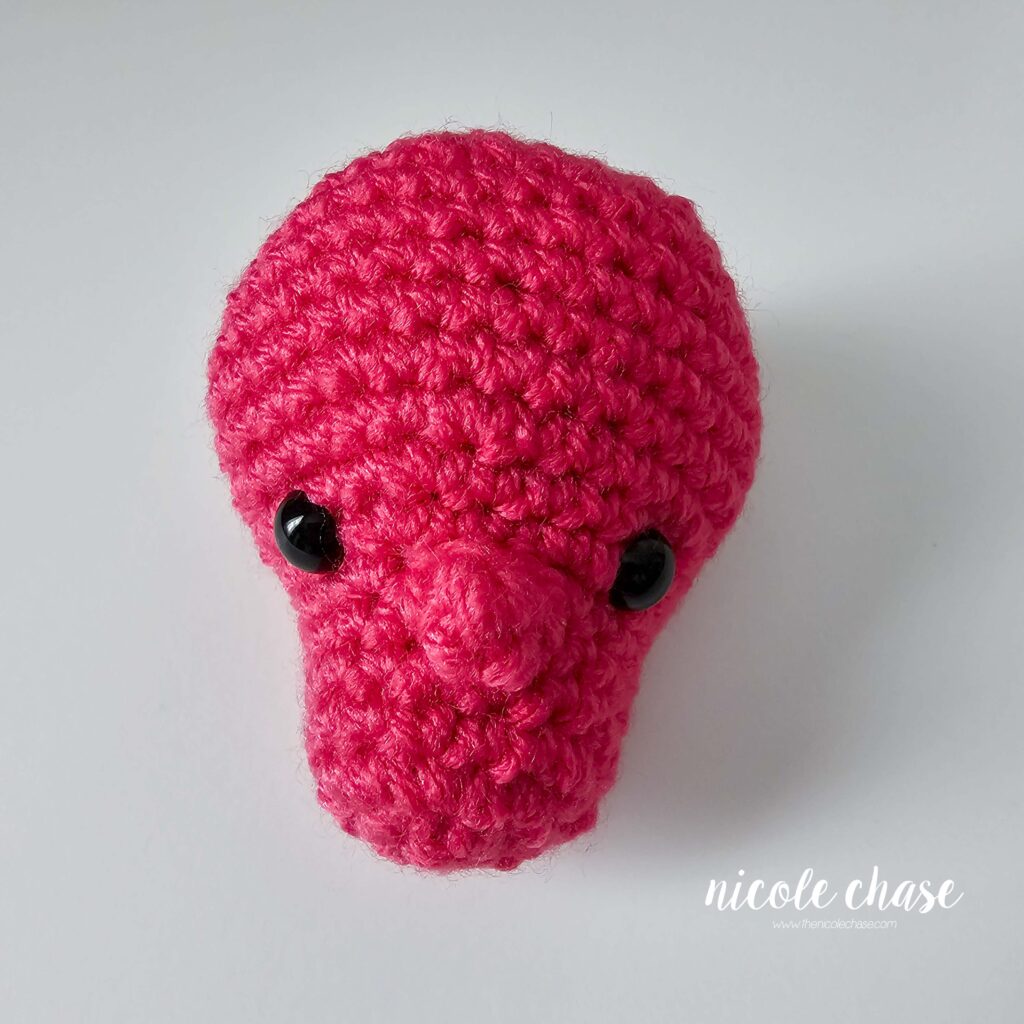
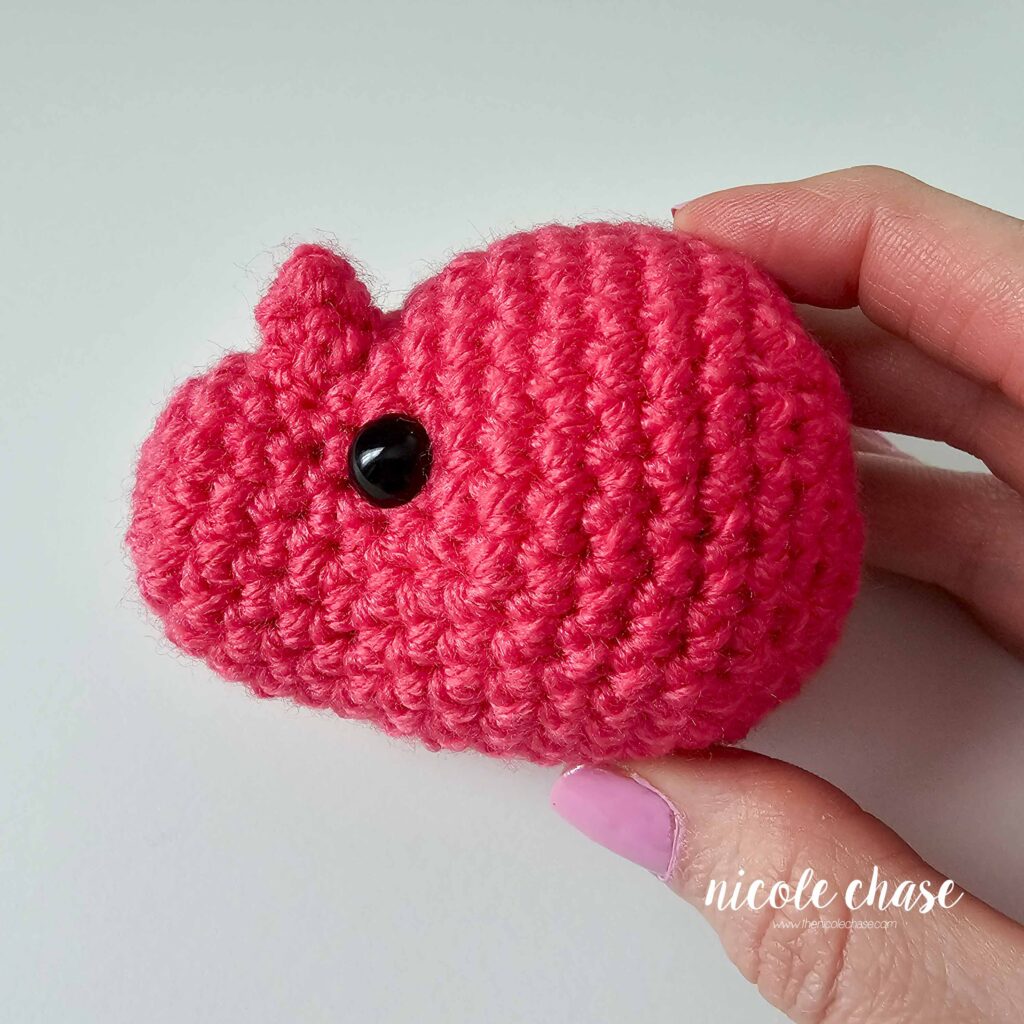
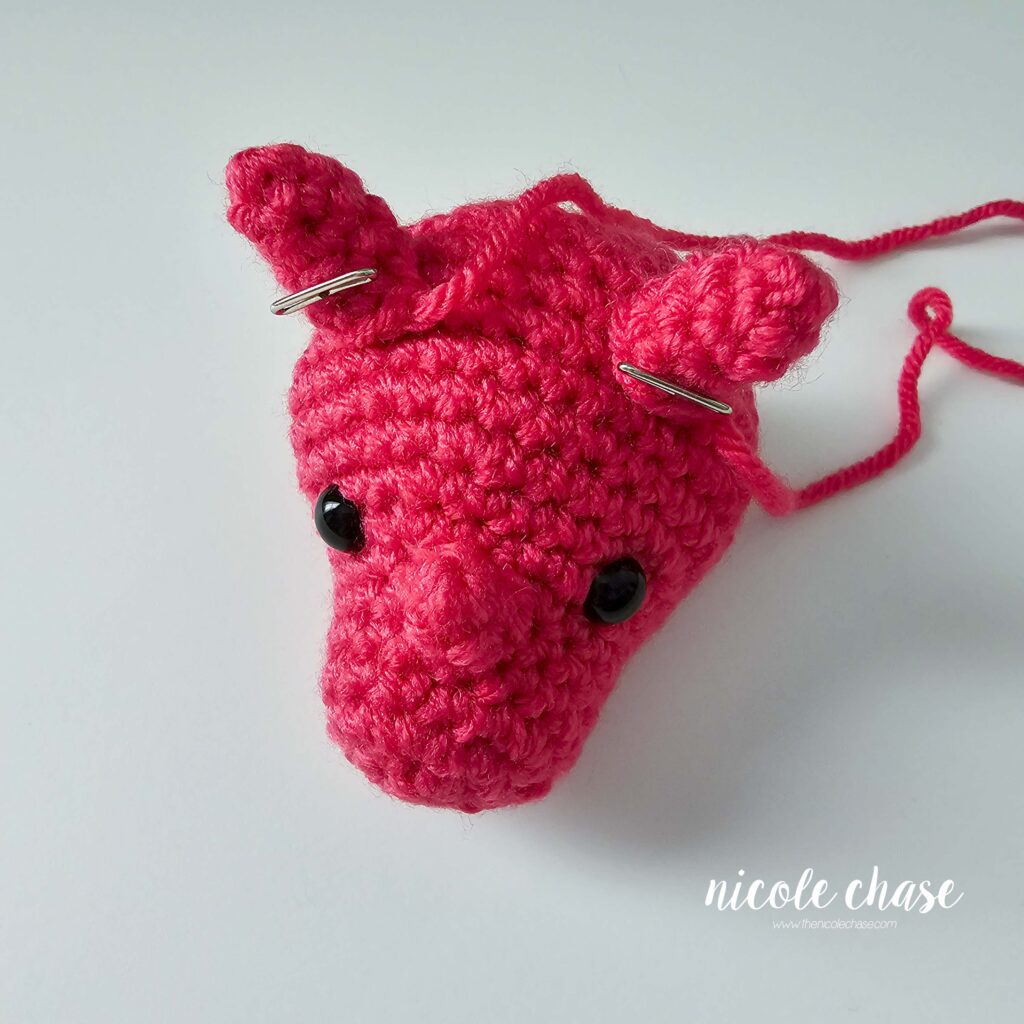
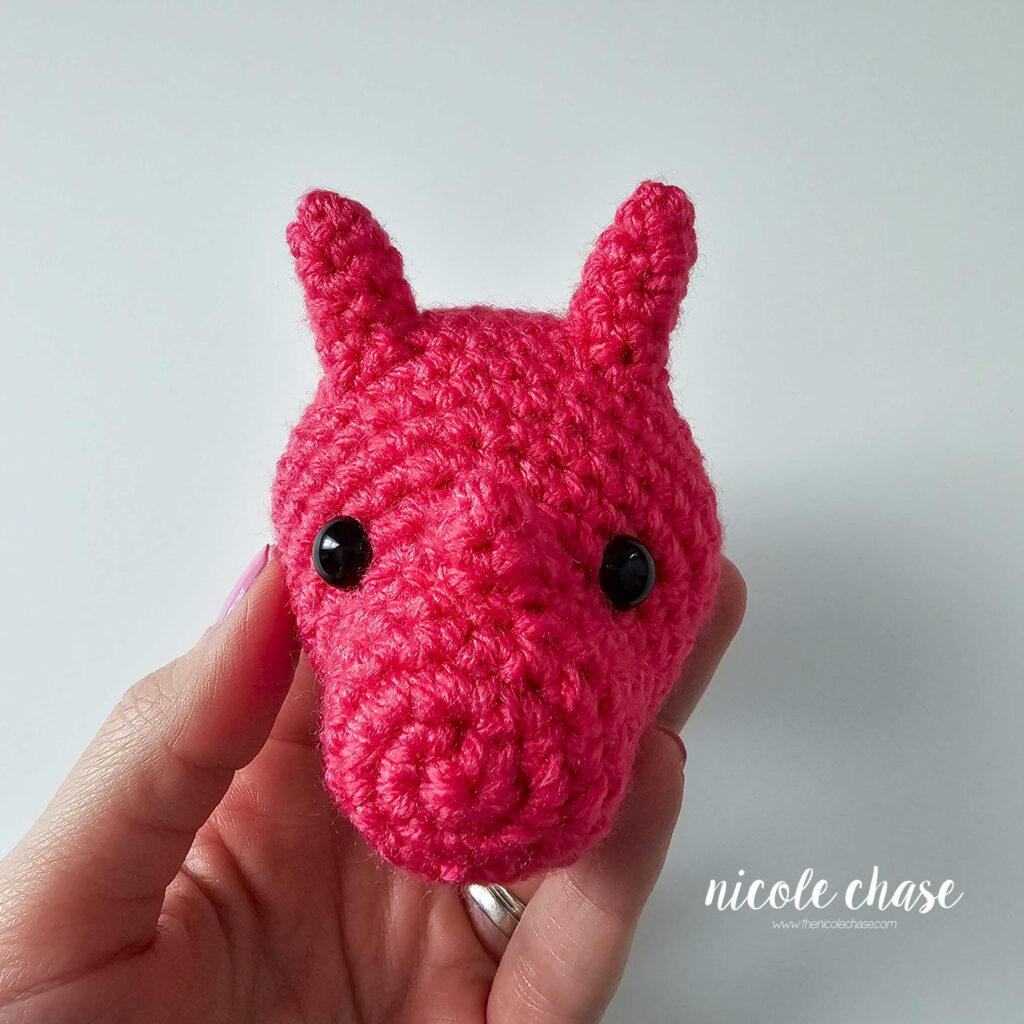
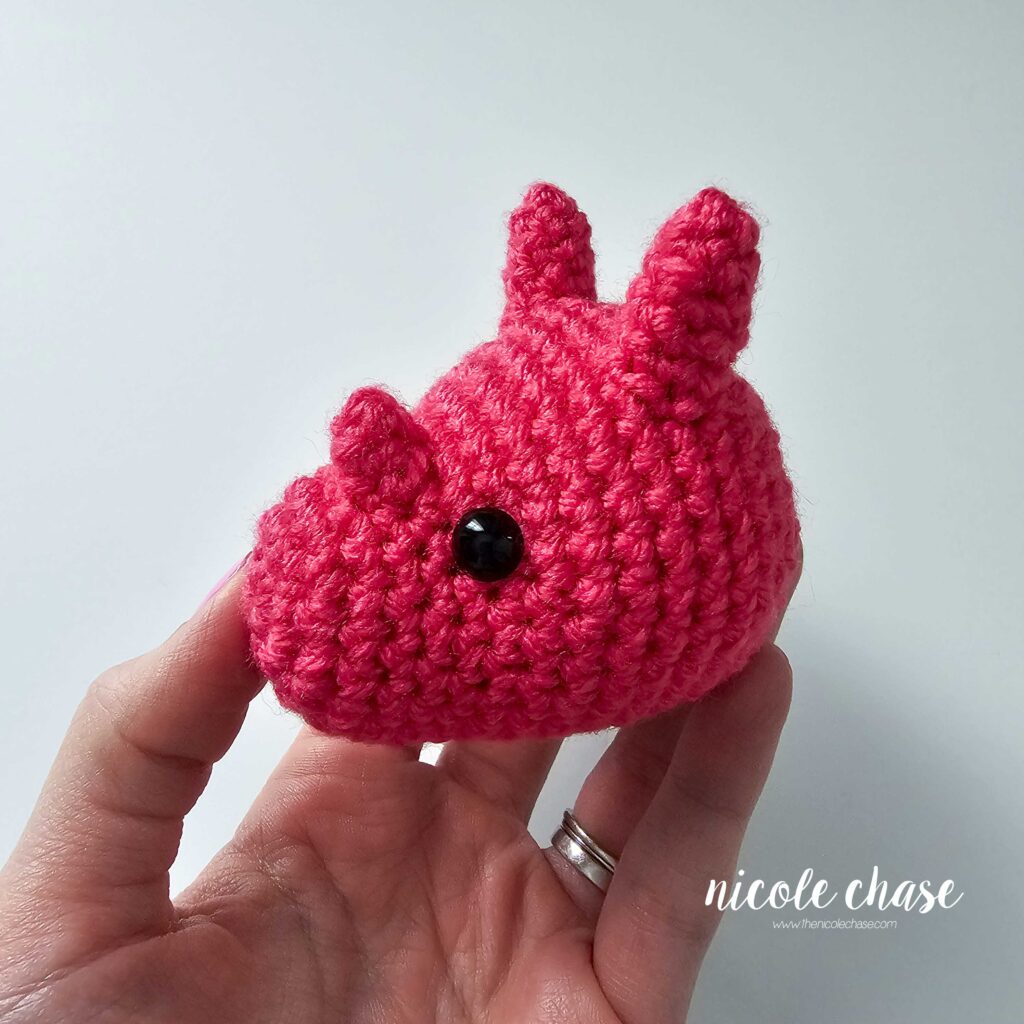
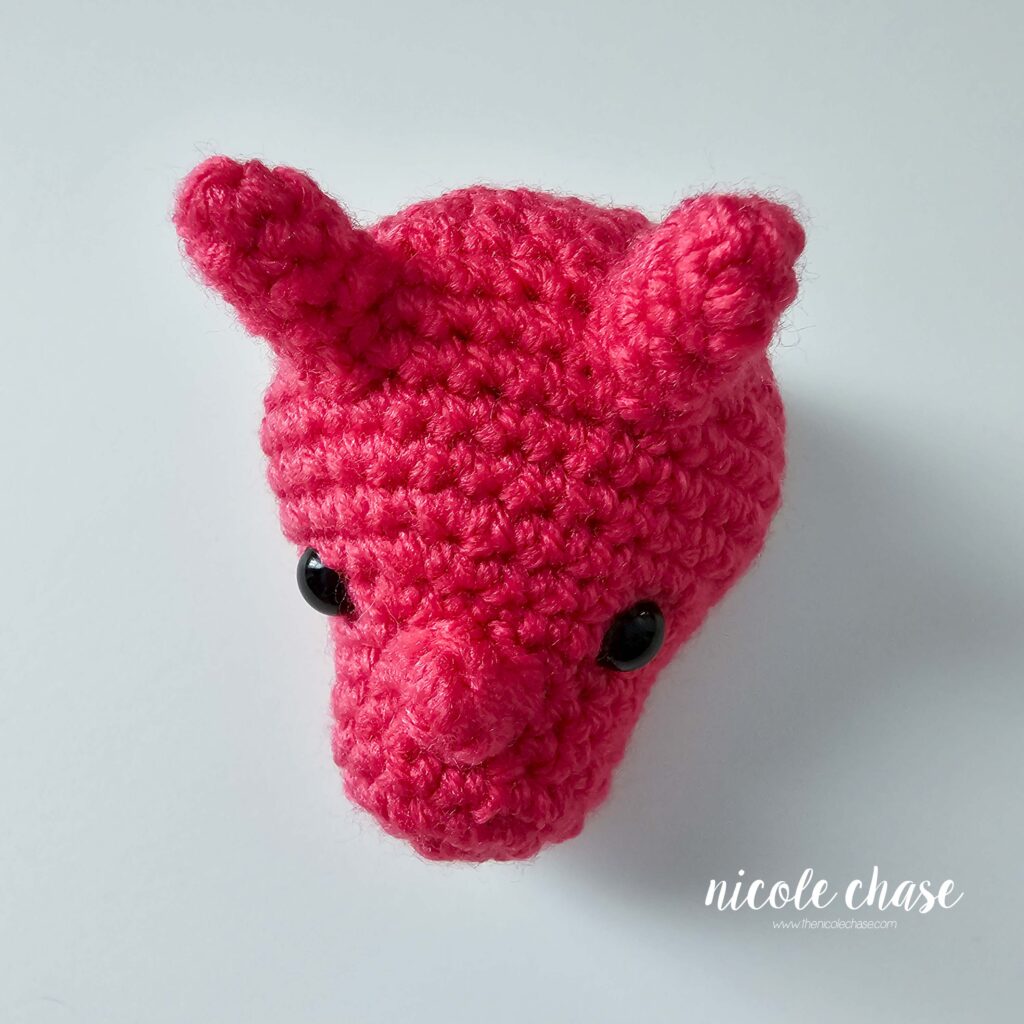
Attach frill around the head, directly behind the large horns, at approximately R15.
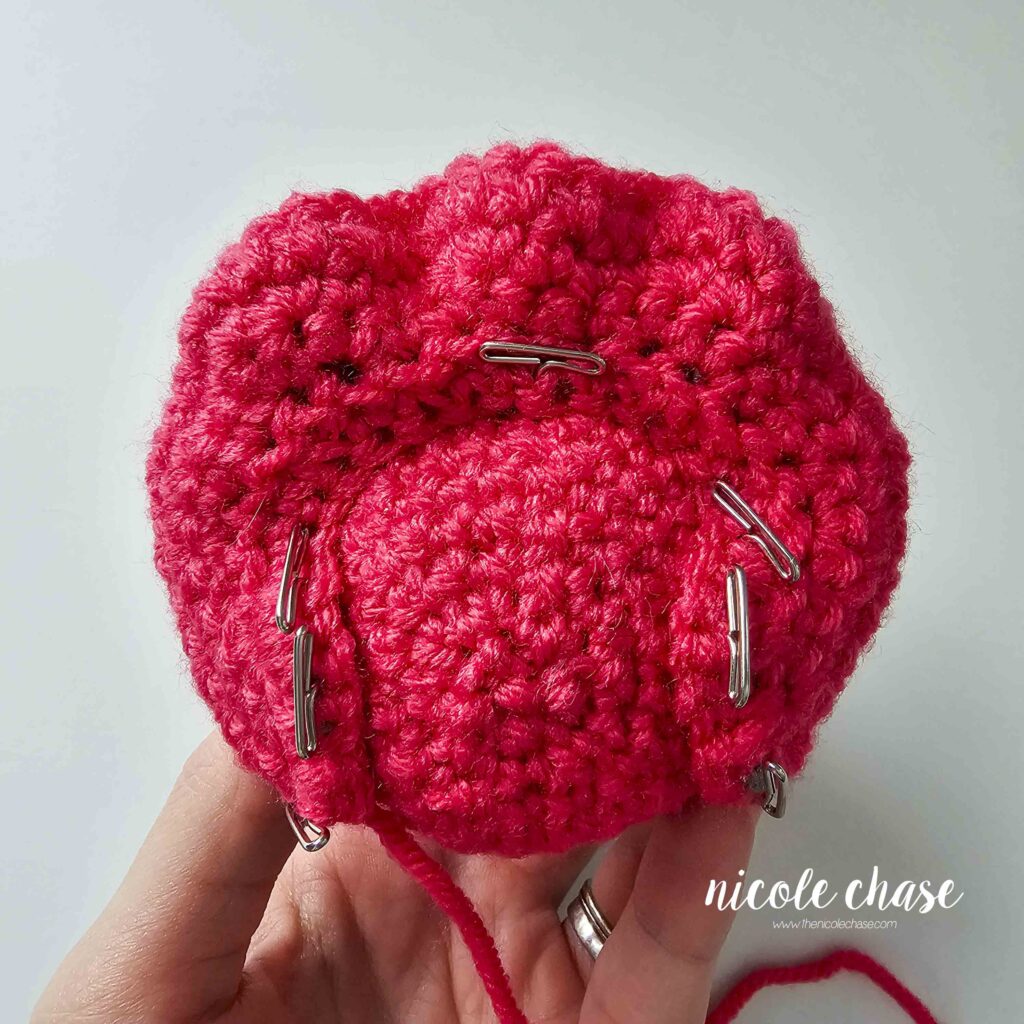
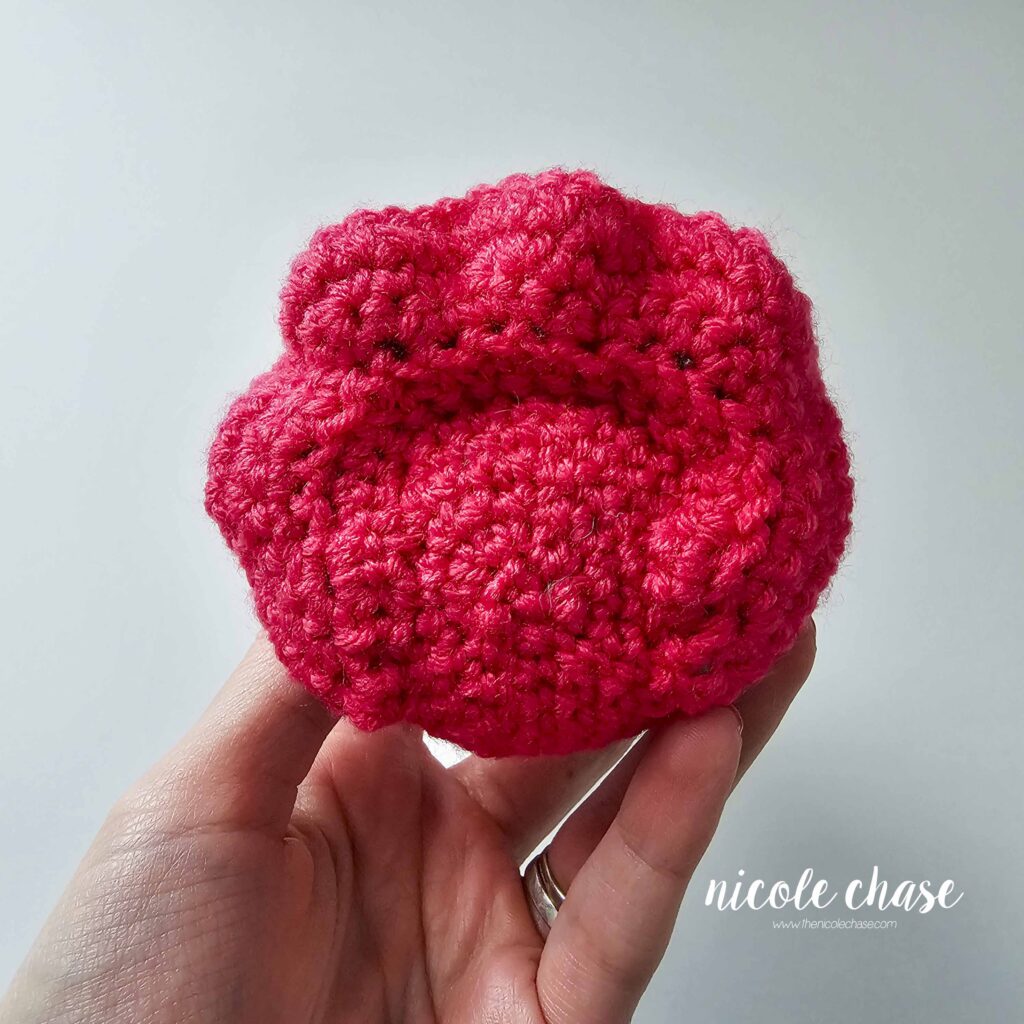
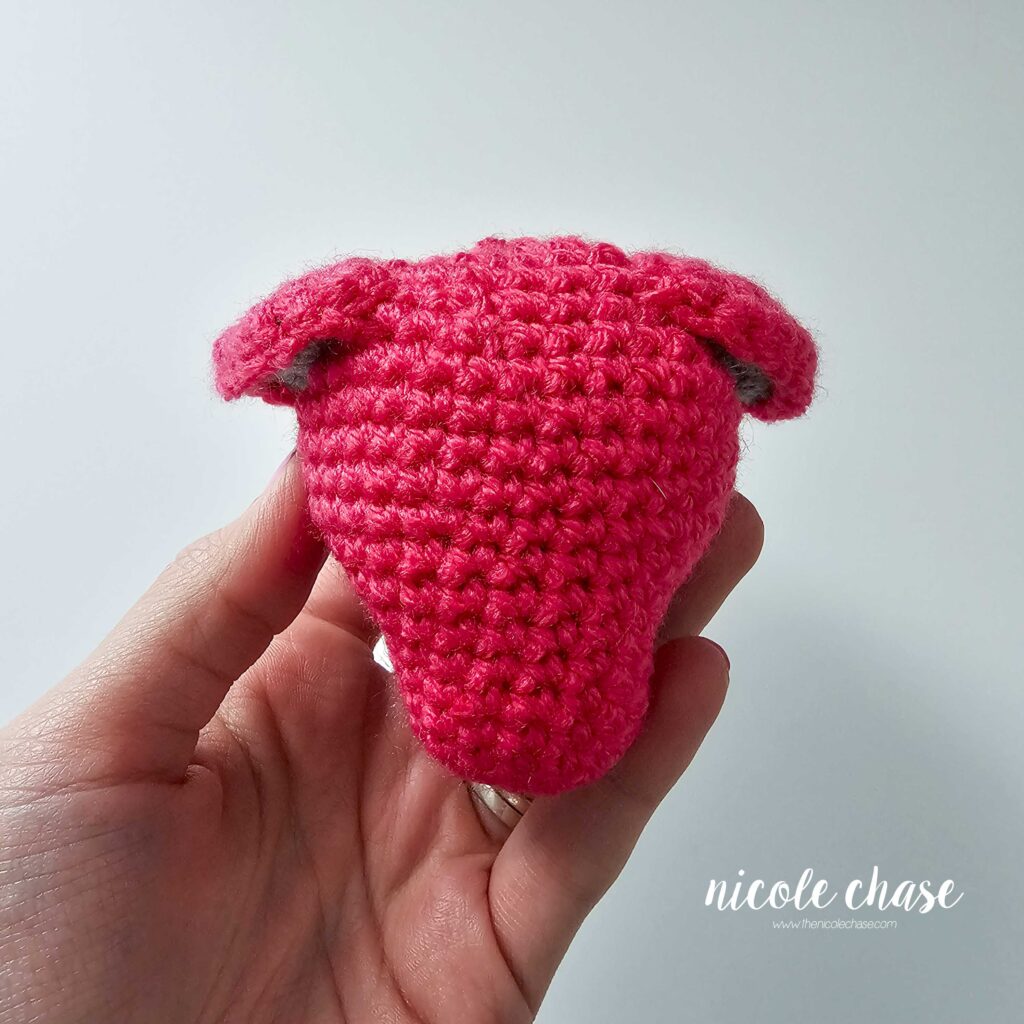
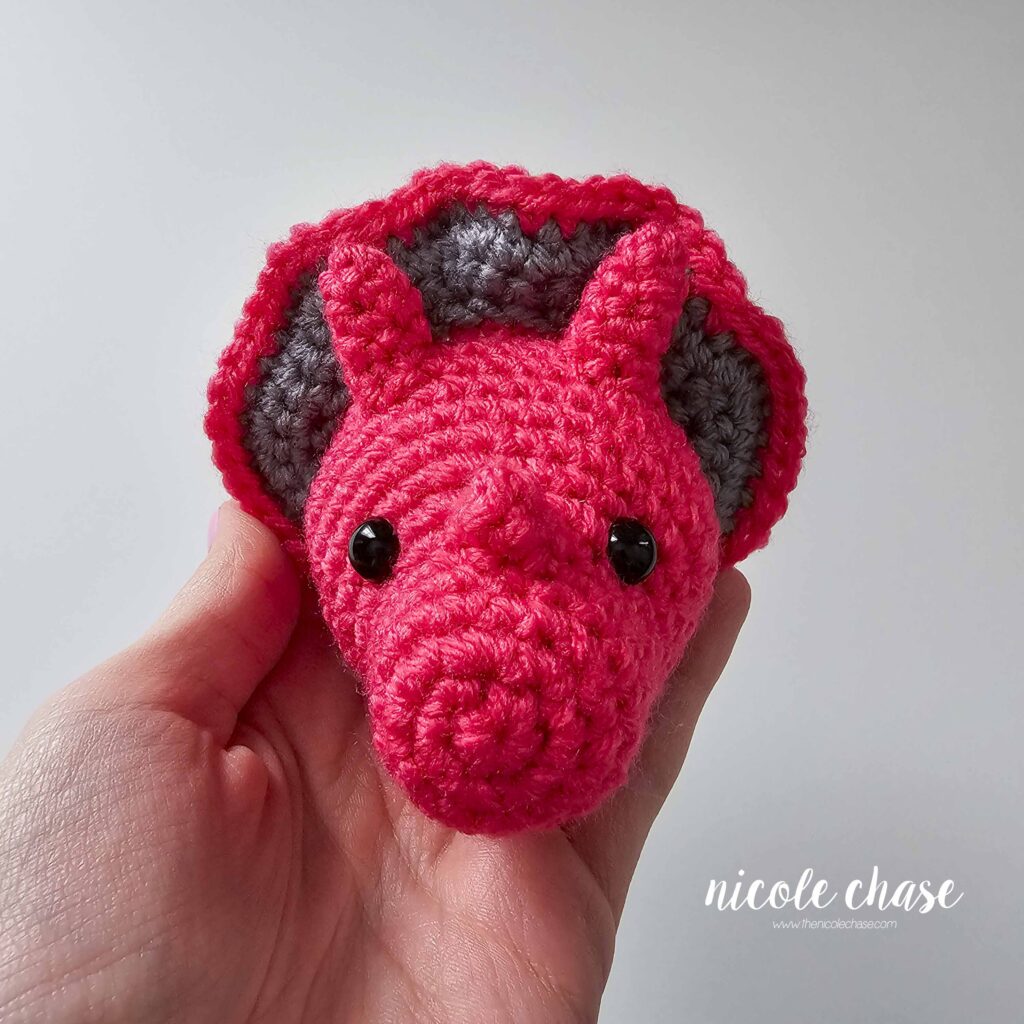
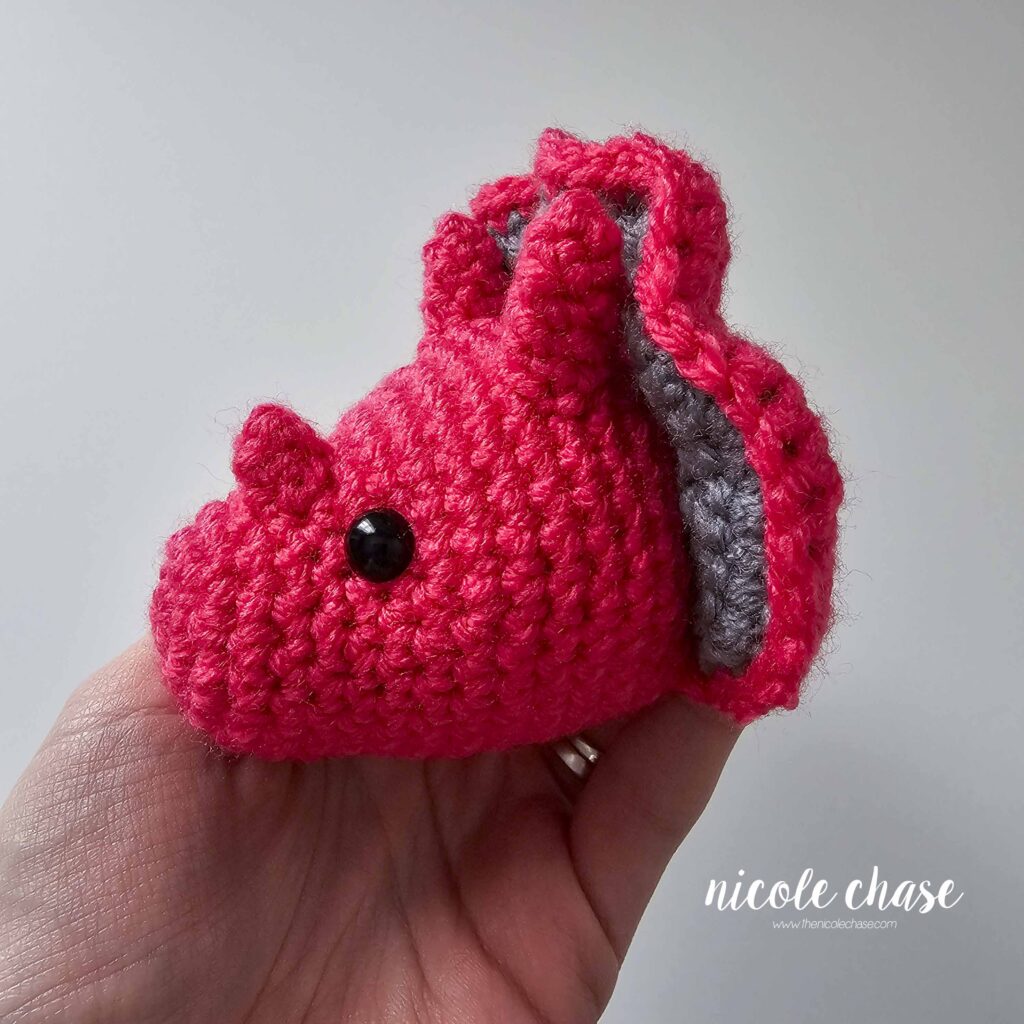
Attach head to body so that the frill is upright, in line with the body, and the nose is facing straight out; attaching body to approximately R10-16 of the bottom of the head.
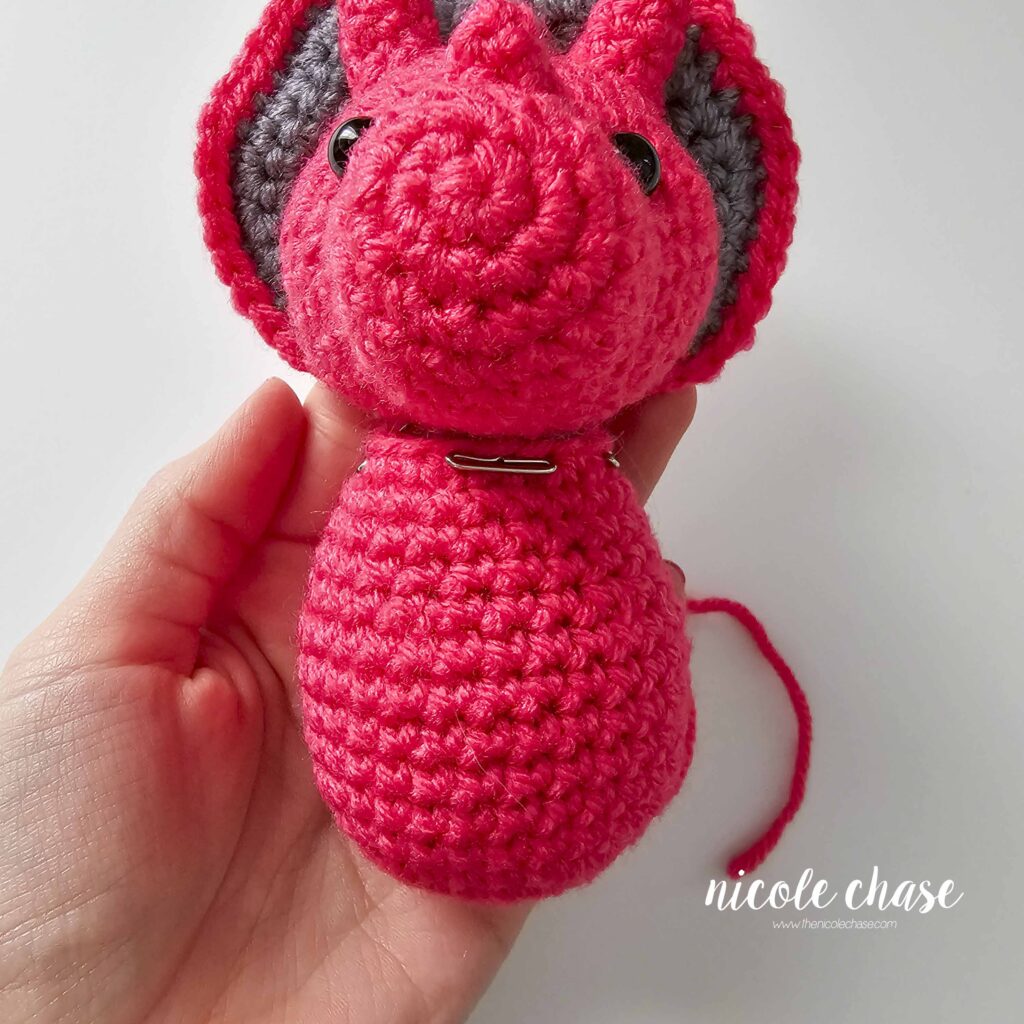
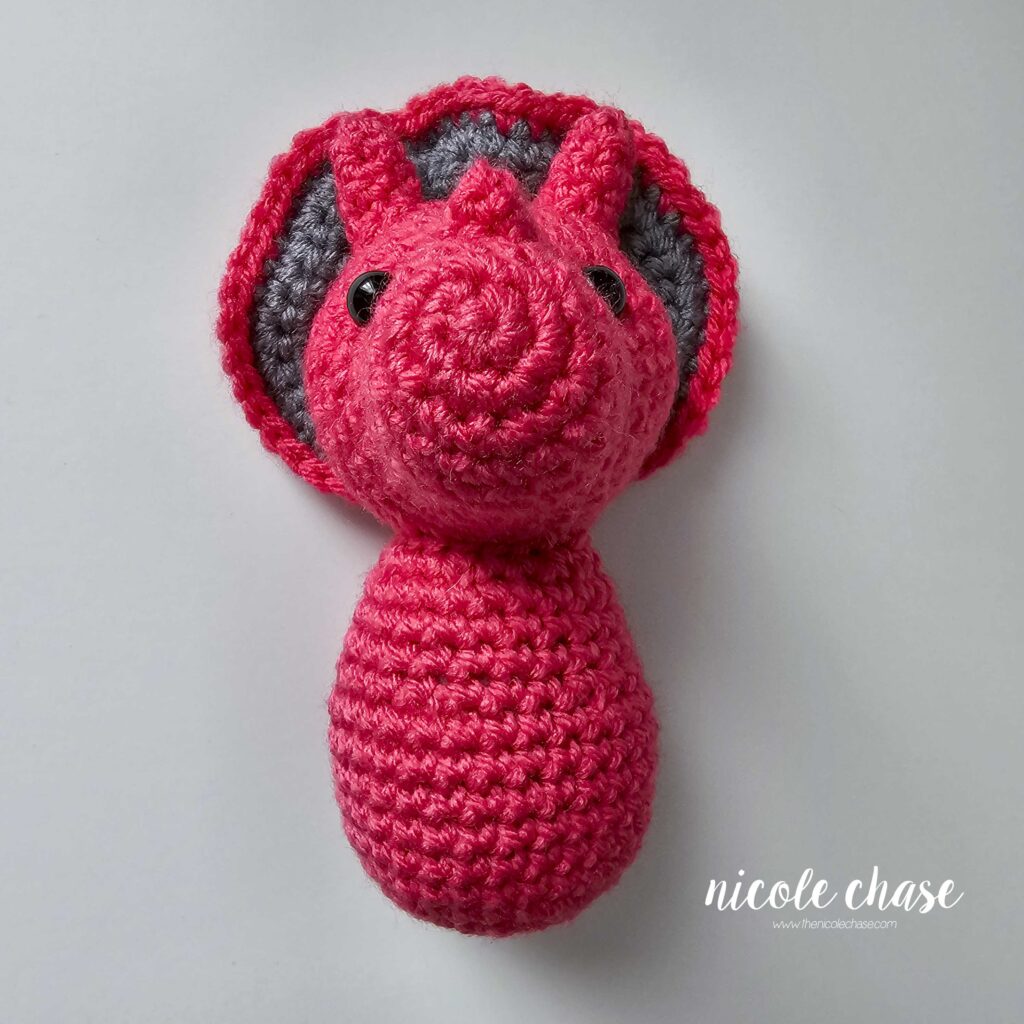
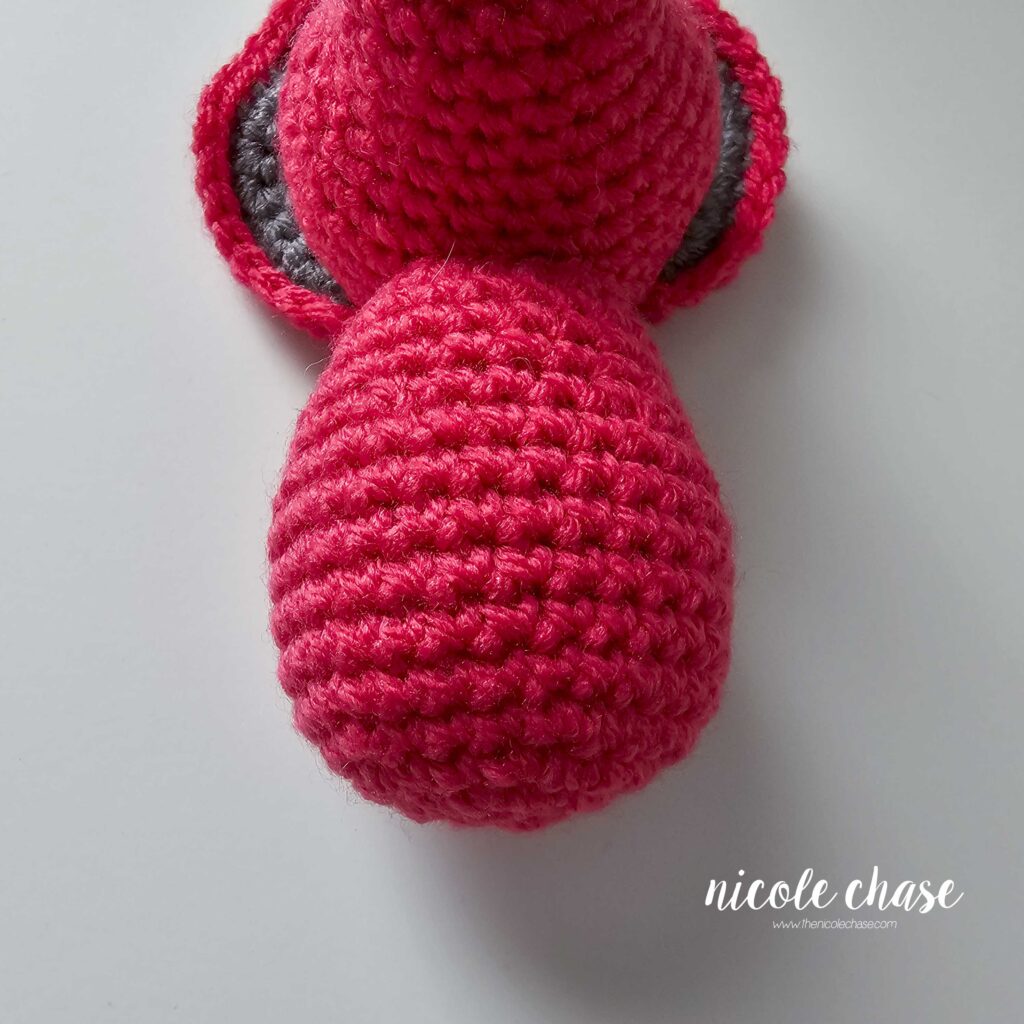
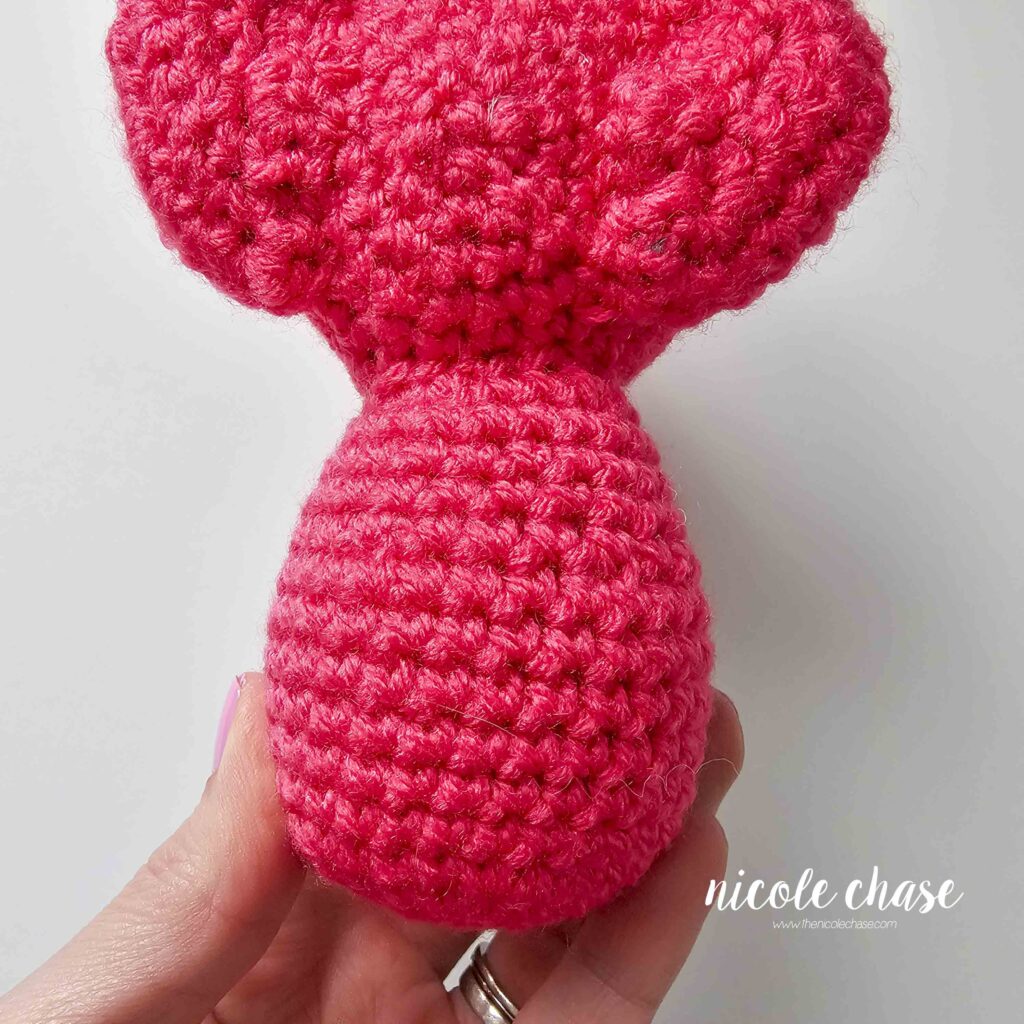
Attach legs over R5-6 of body, with each inside end of the legs touching in the middle.
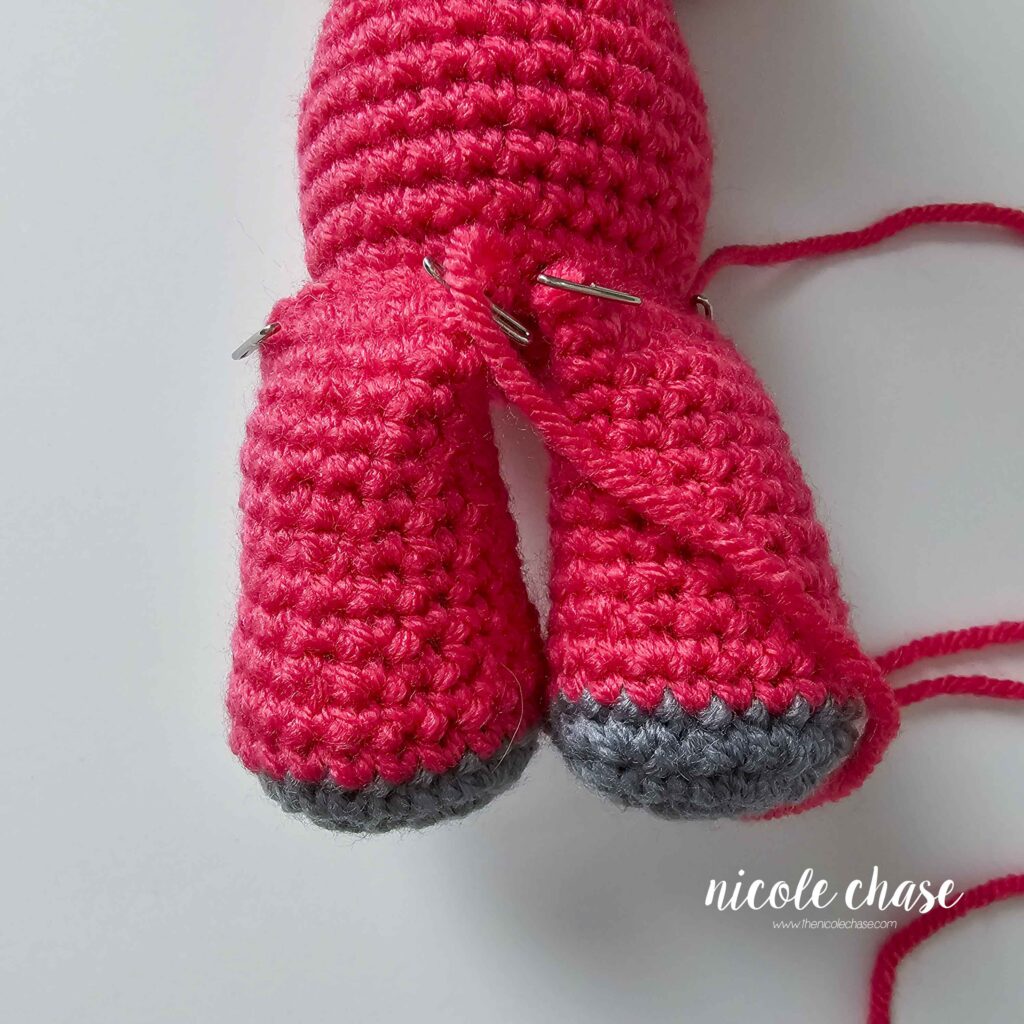
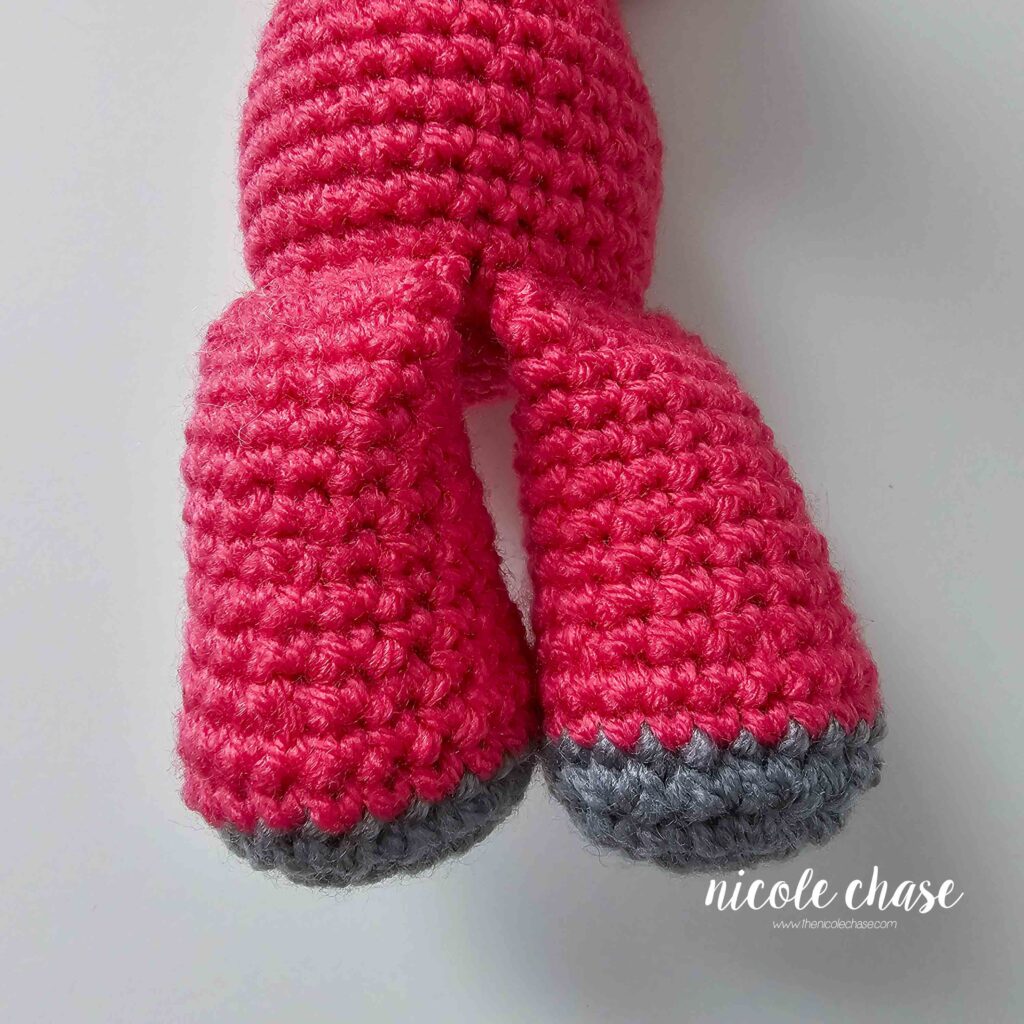
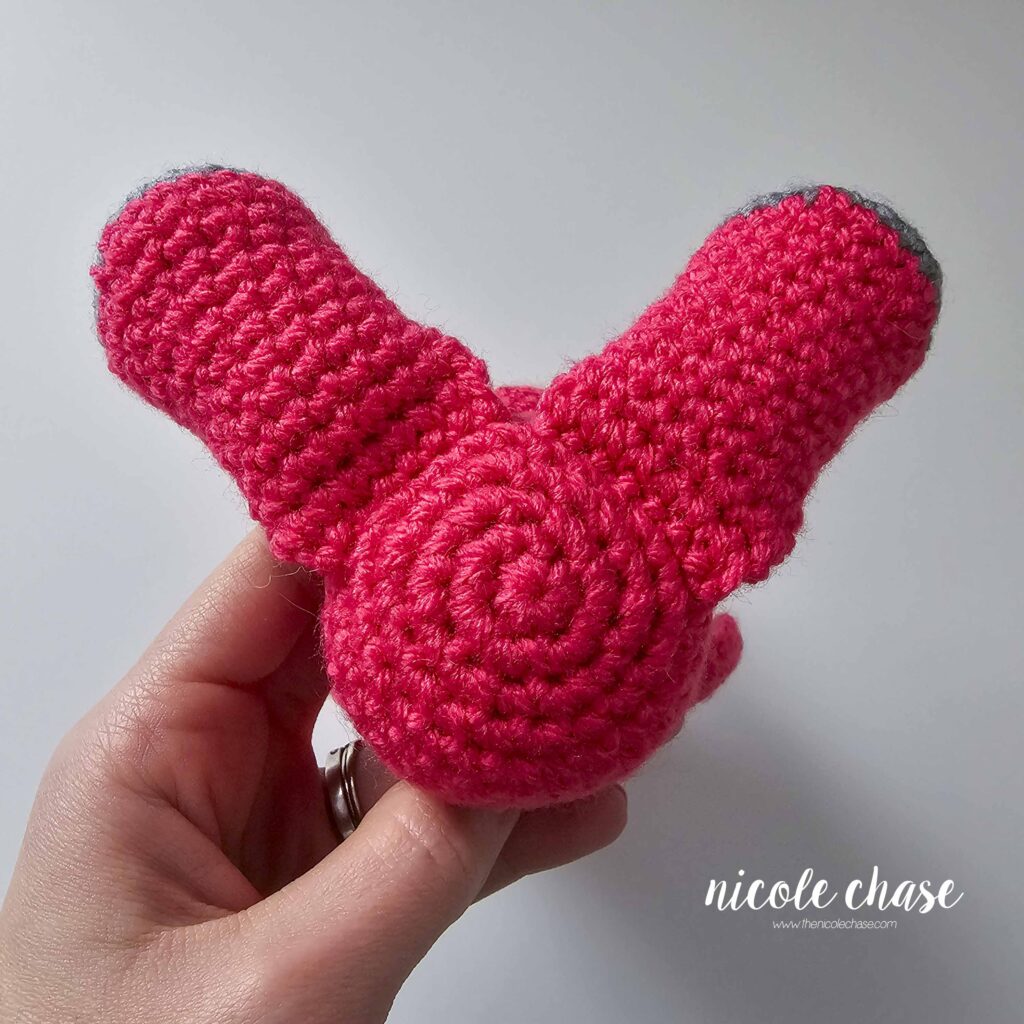
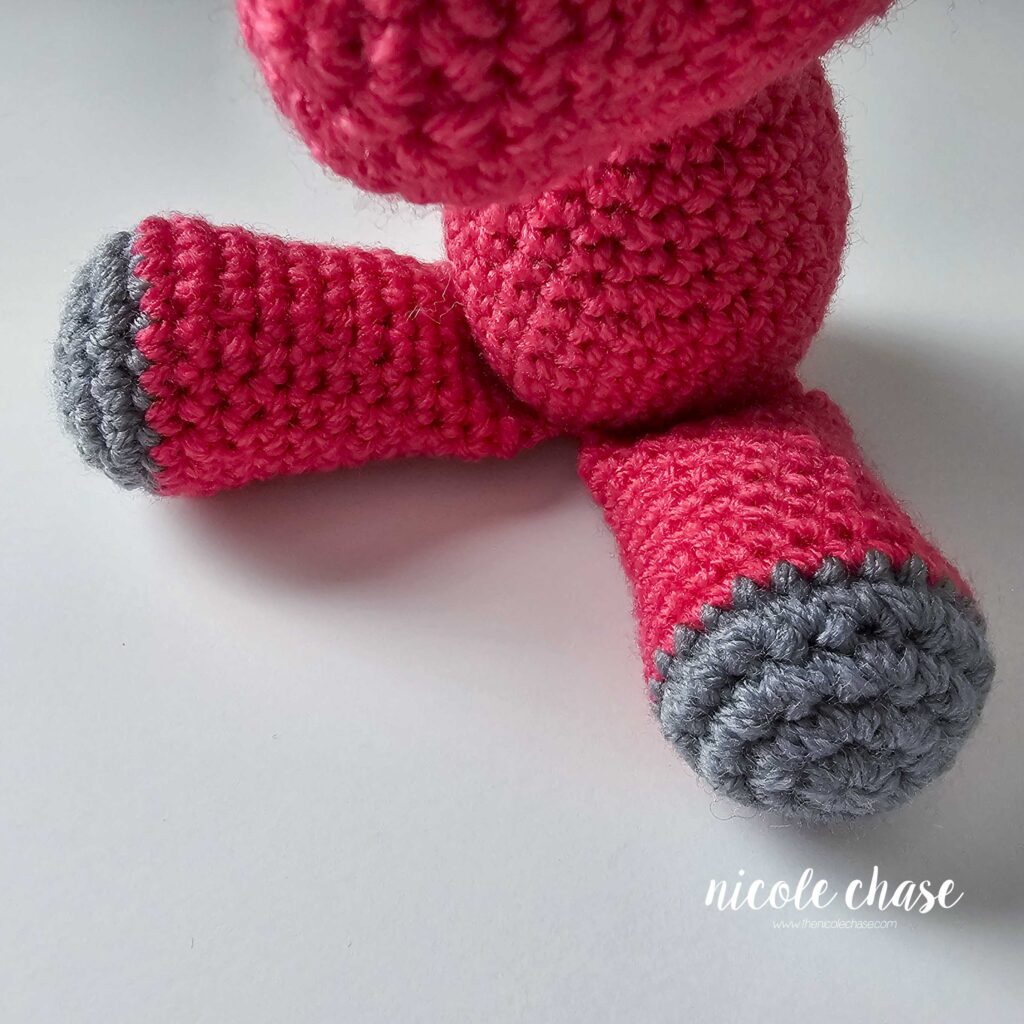
Attach arms over R11-15 on each side of the body, in line with the back of each leg. At the top of the arms, leave approximately 8 sts between each arm across the front of the body. At the bottom of the arms, leave approximately 15 sts between each arm across the front of the body.
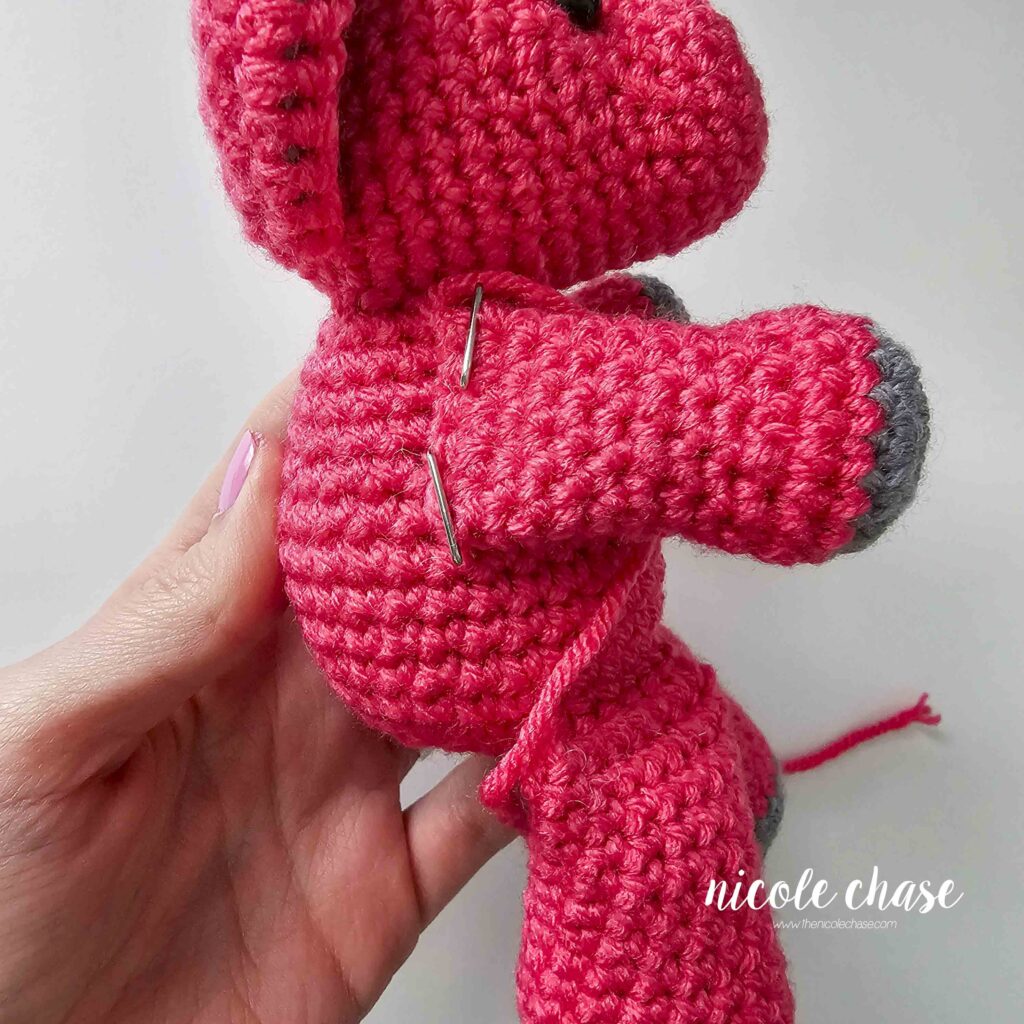
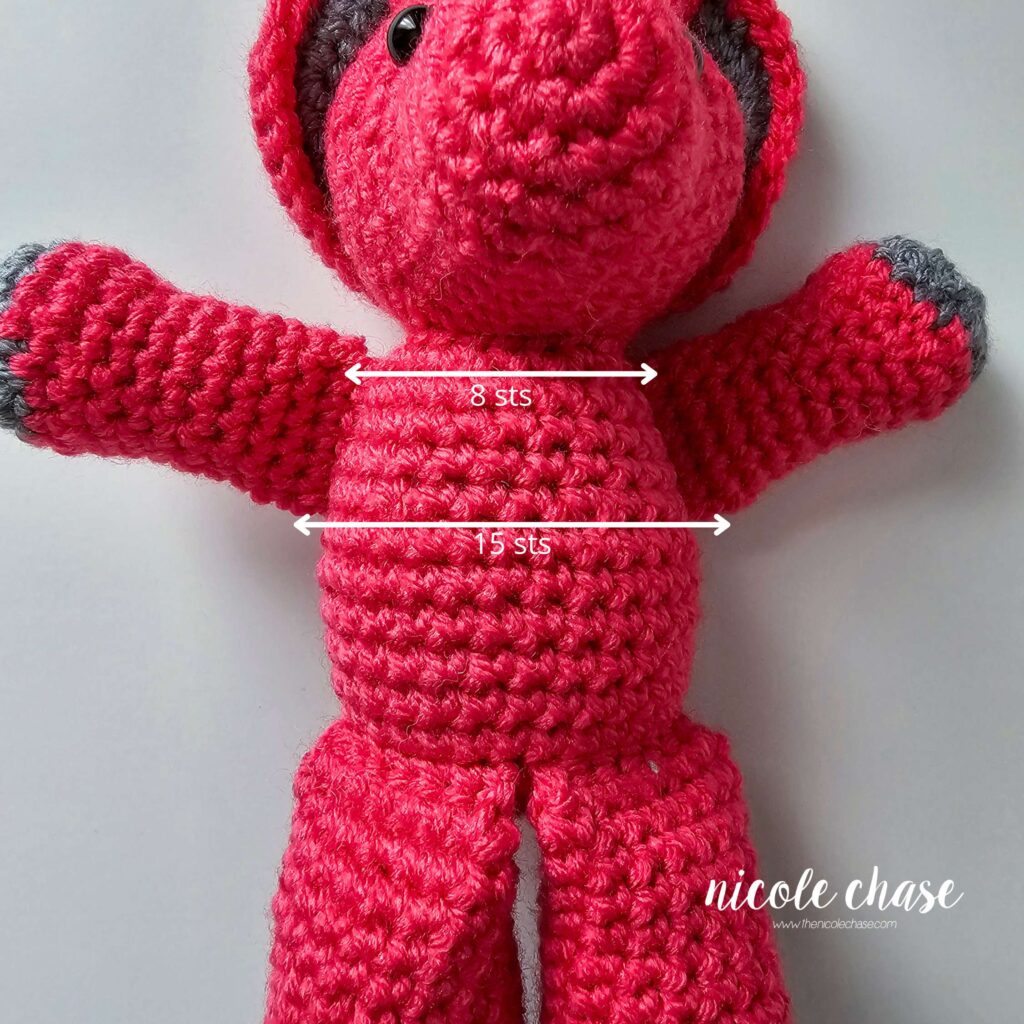
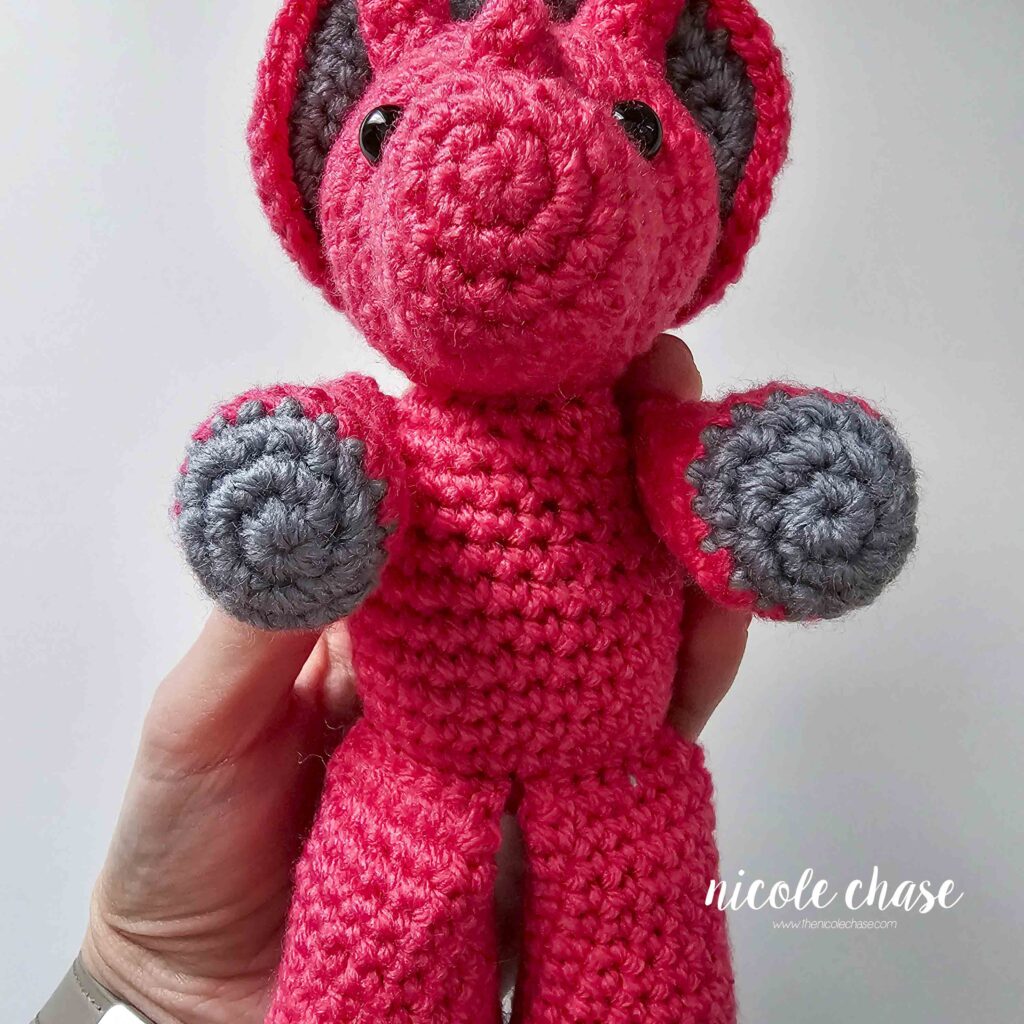
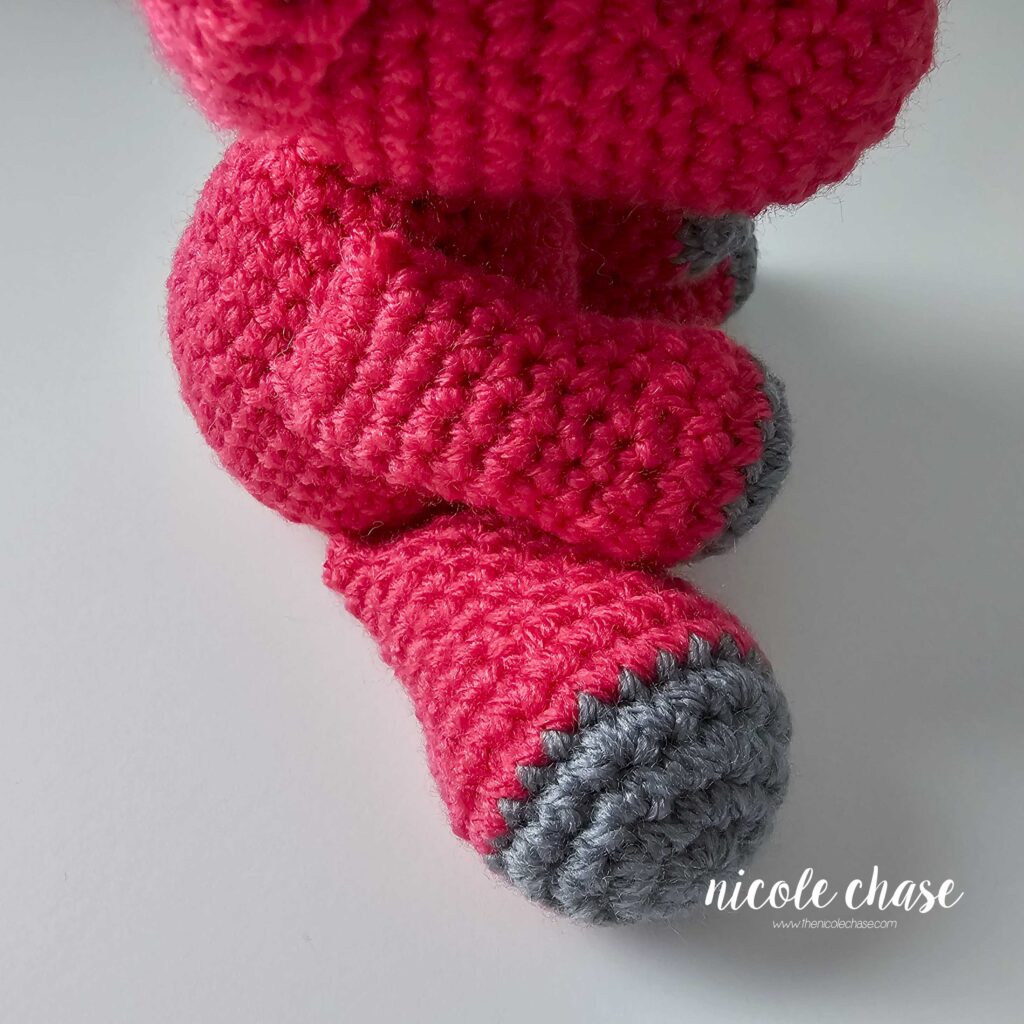
Embroider 3 nails on each leg, over R4-6, leaving about 2 sts between each nail.
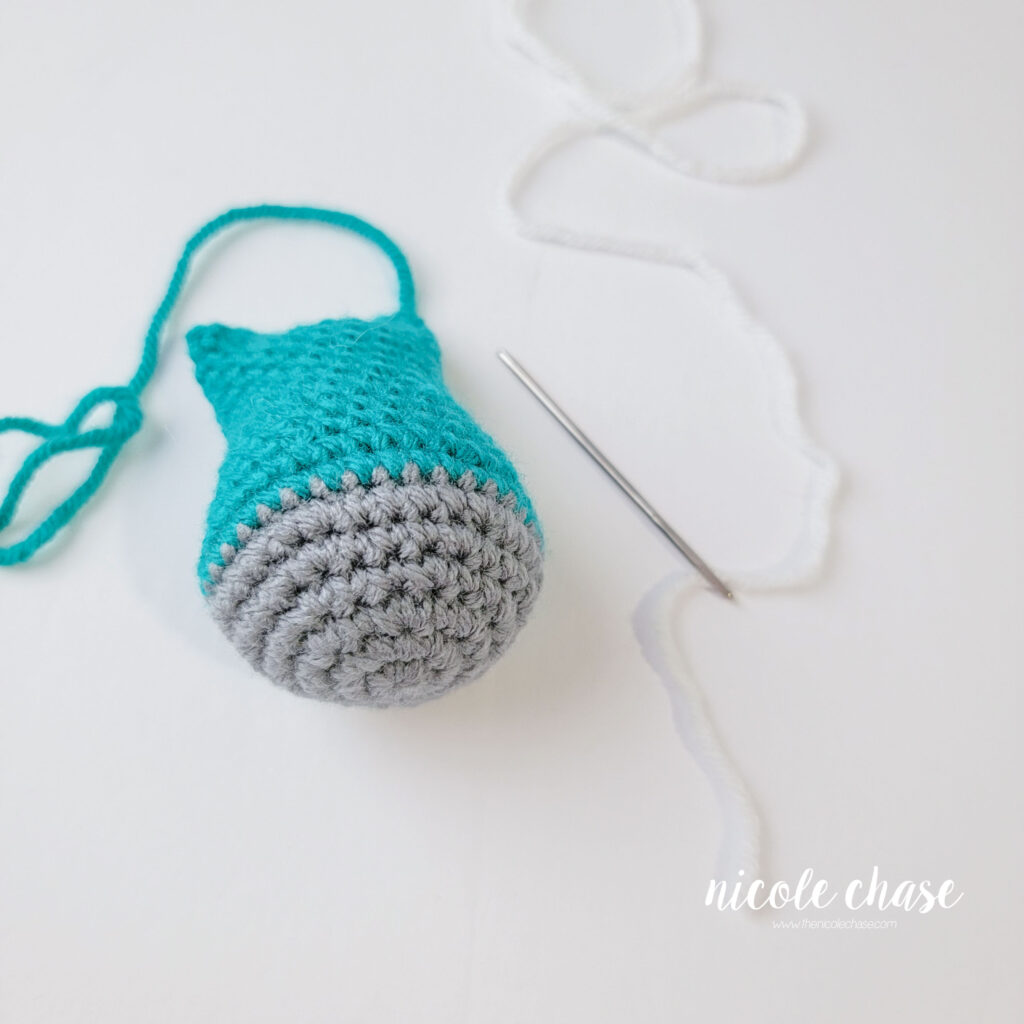
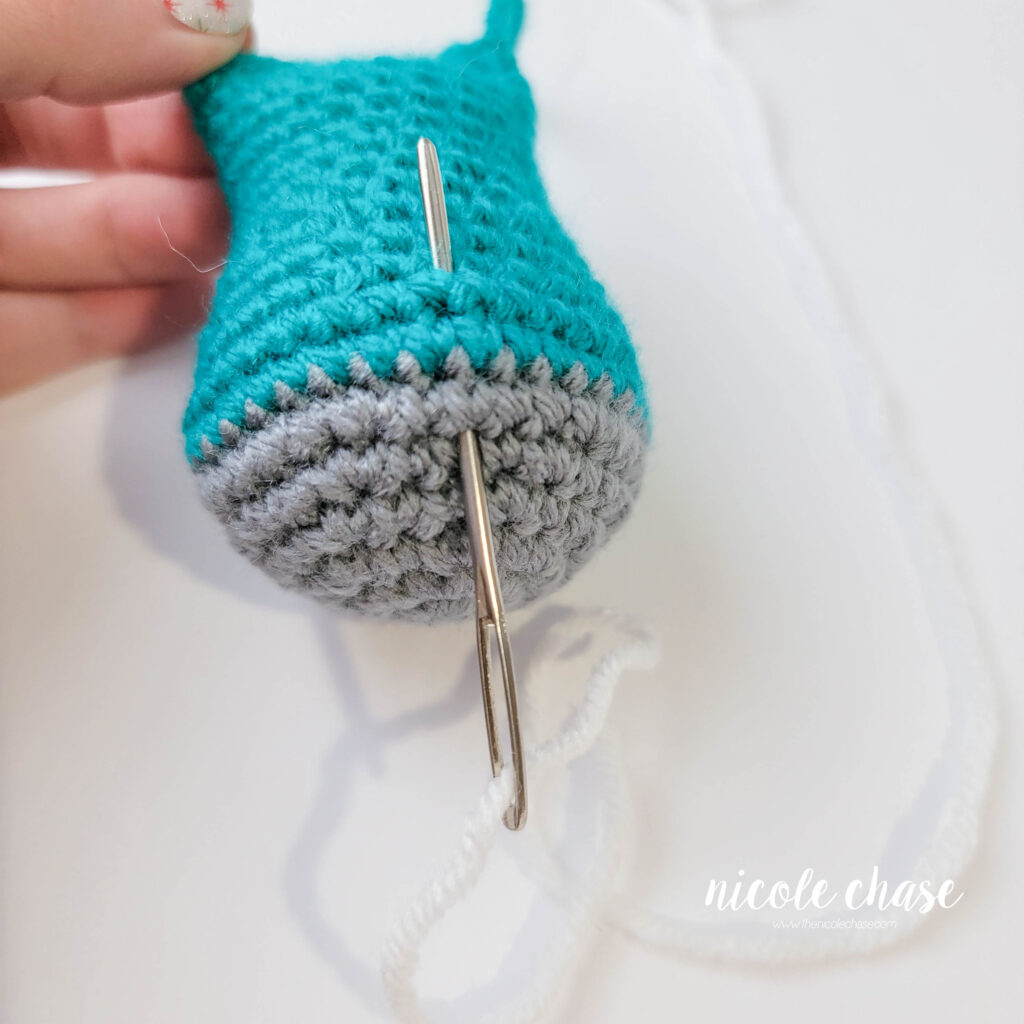
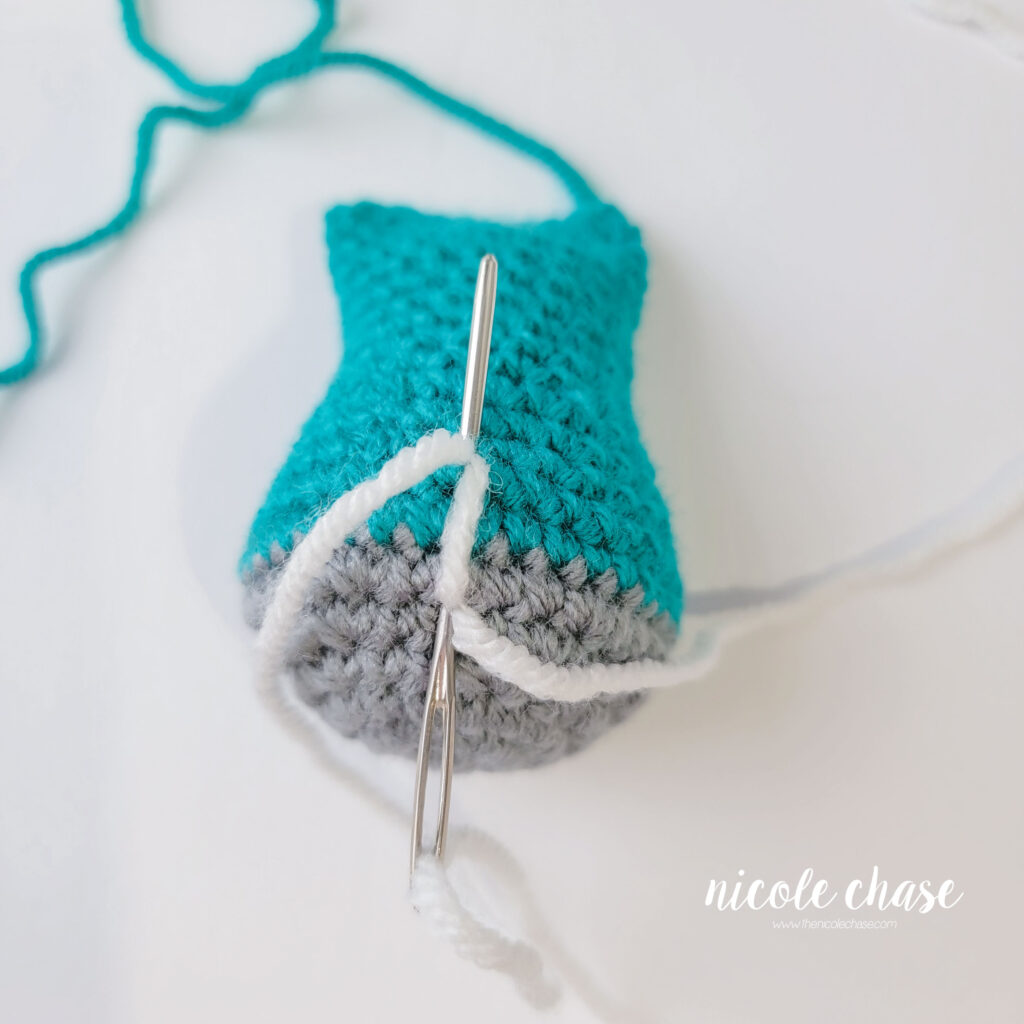
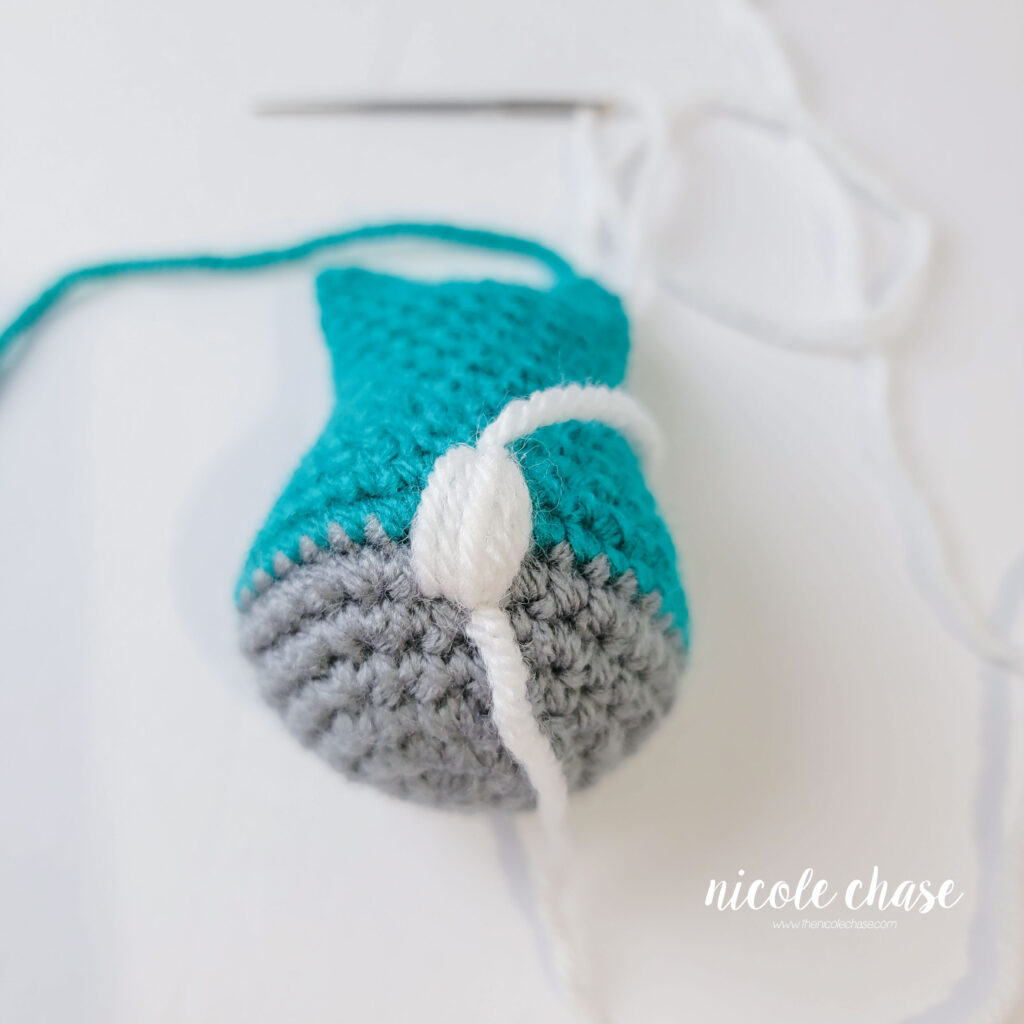
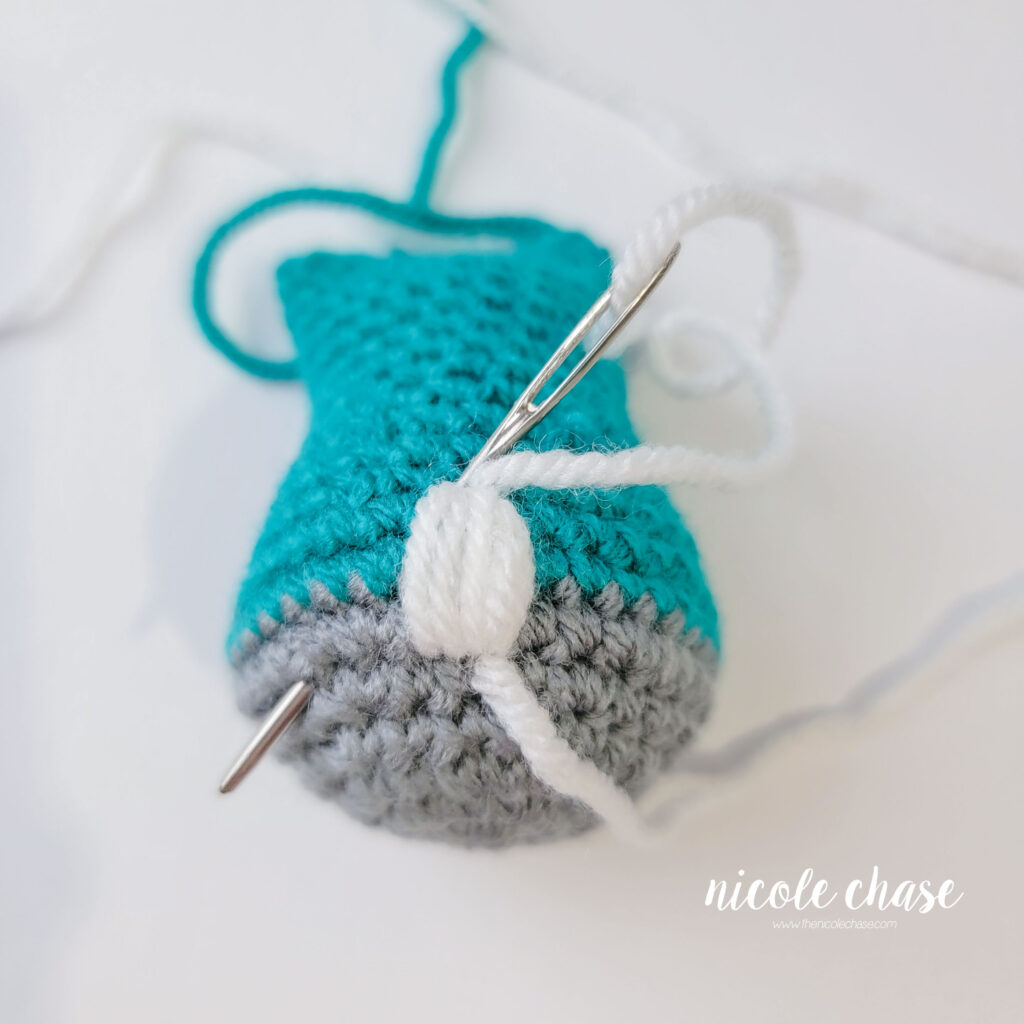
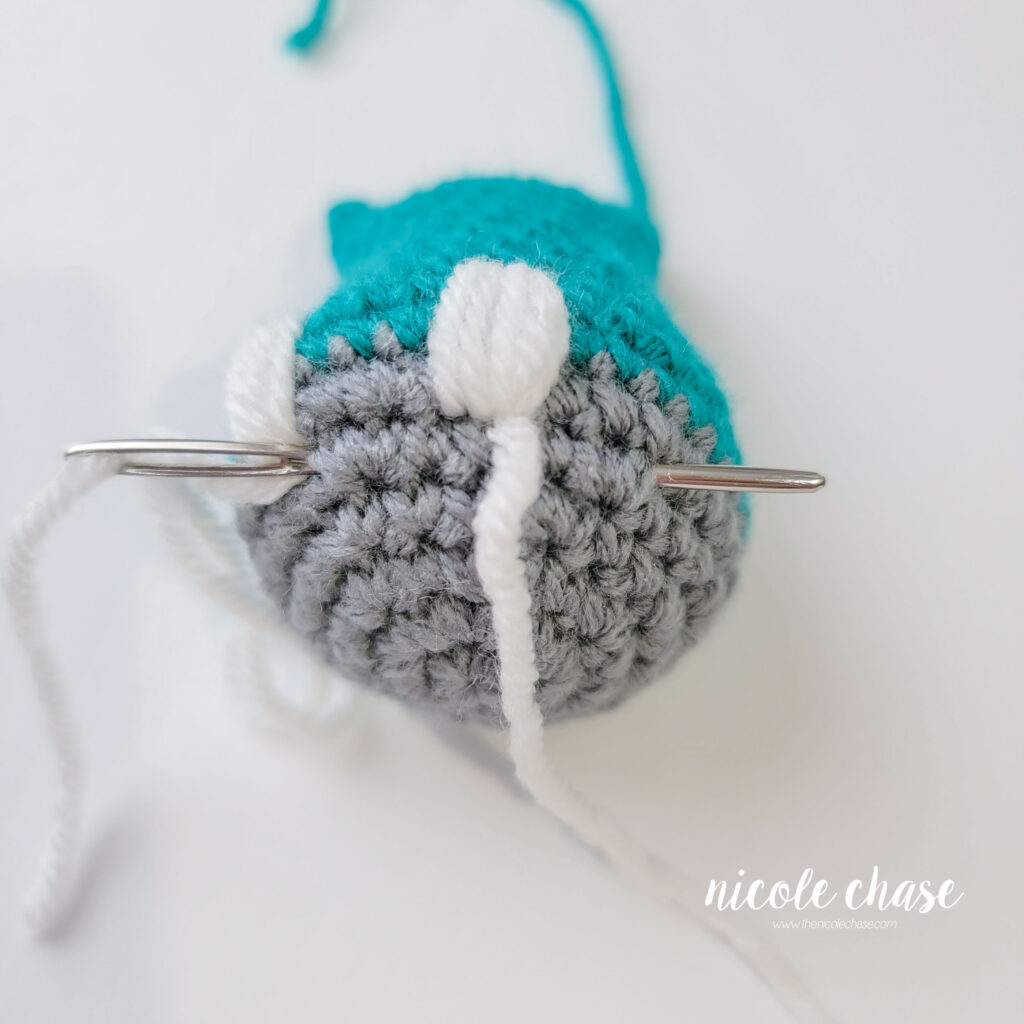
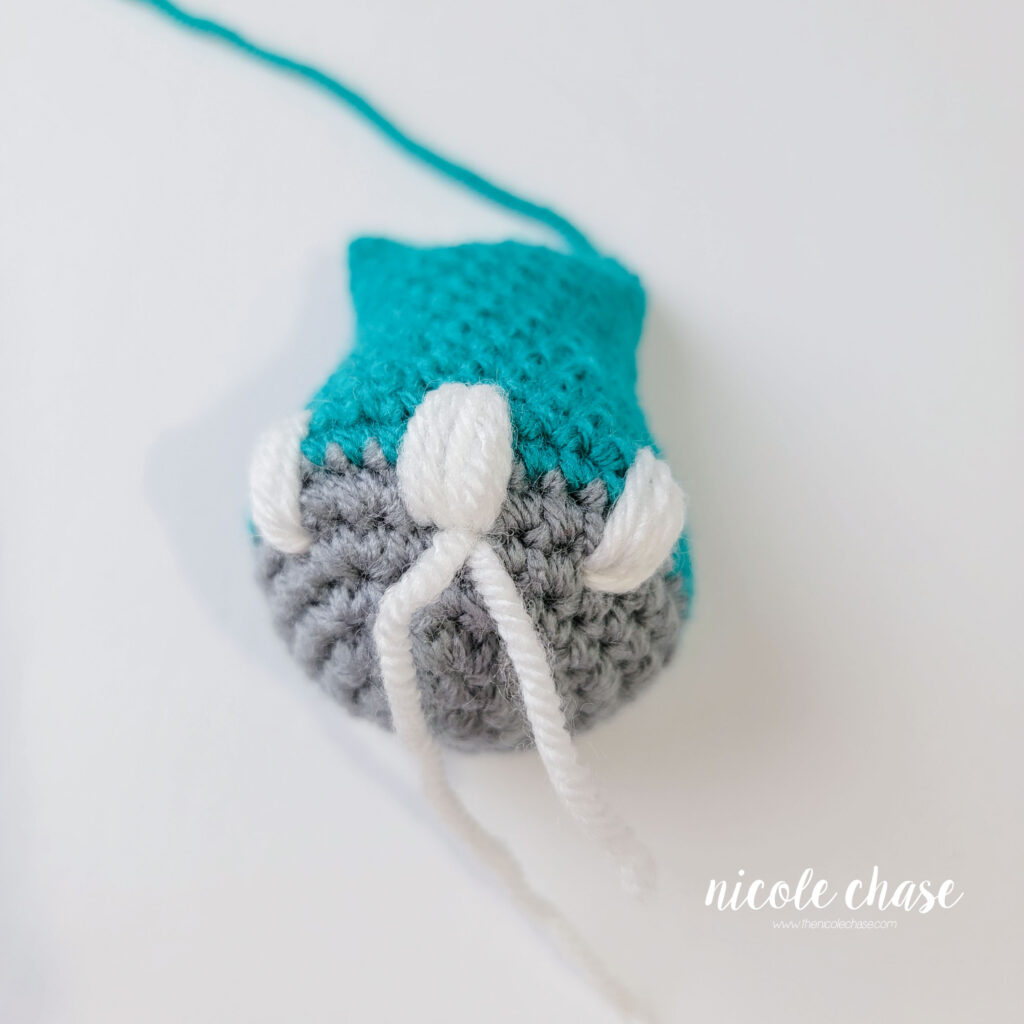
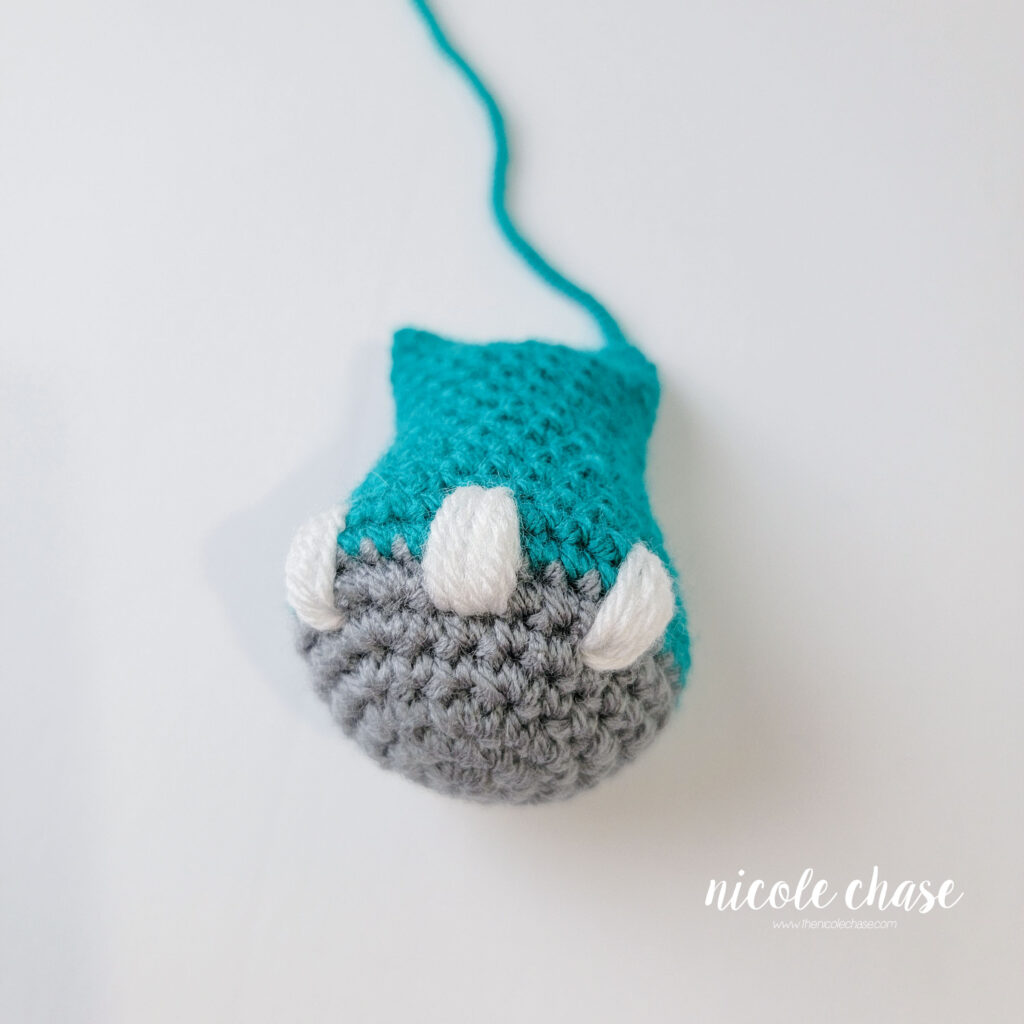
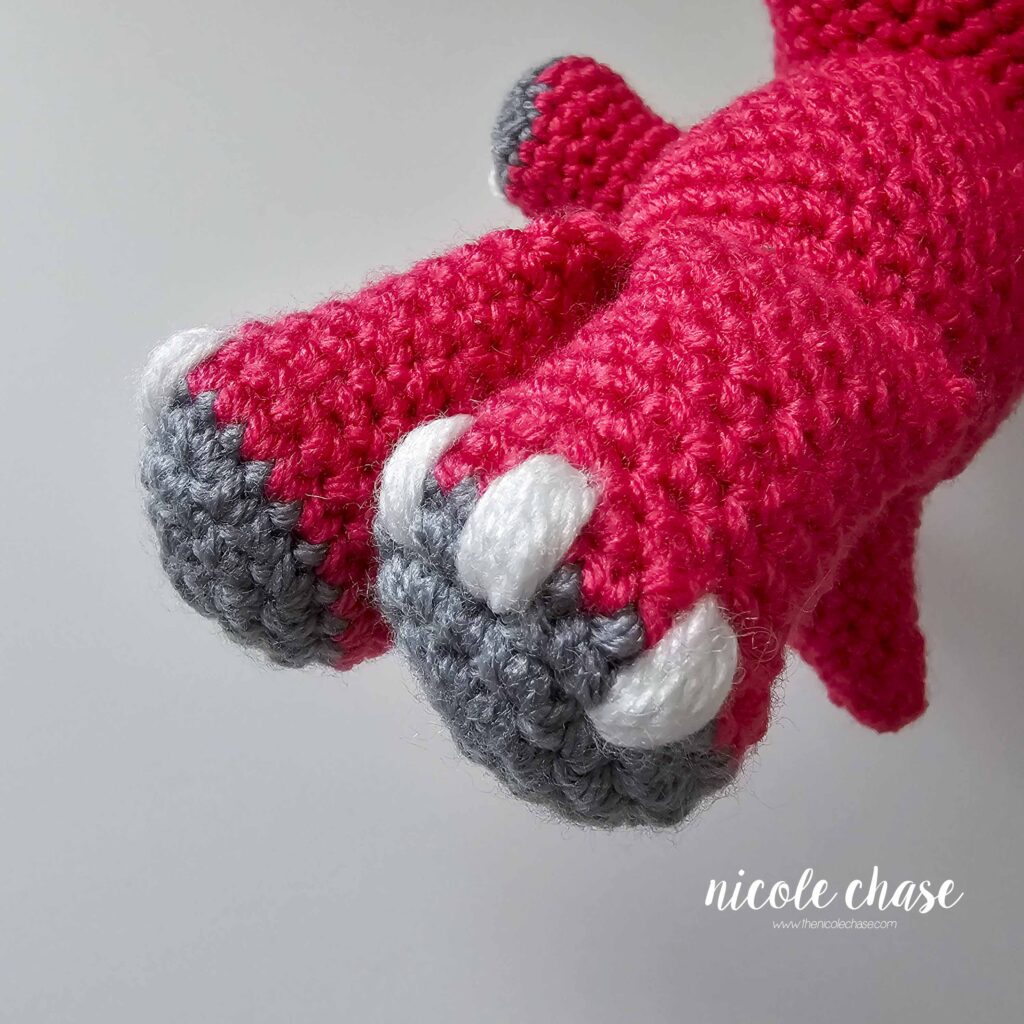
Embroider 3 nails on each arm, over R3-4, leaving about 2 sts between each nail.
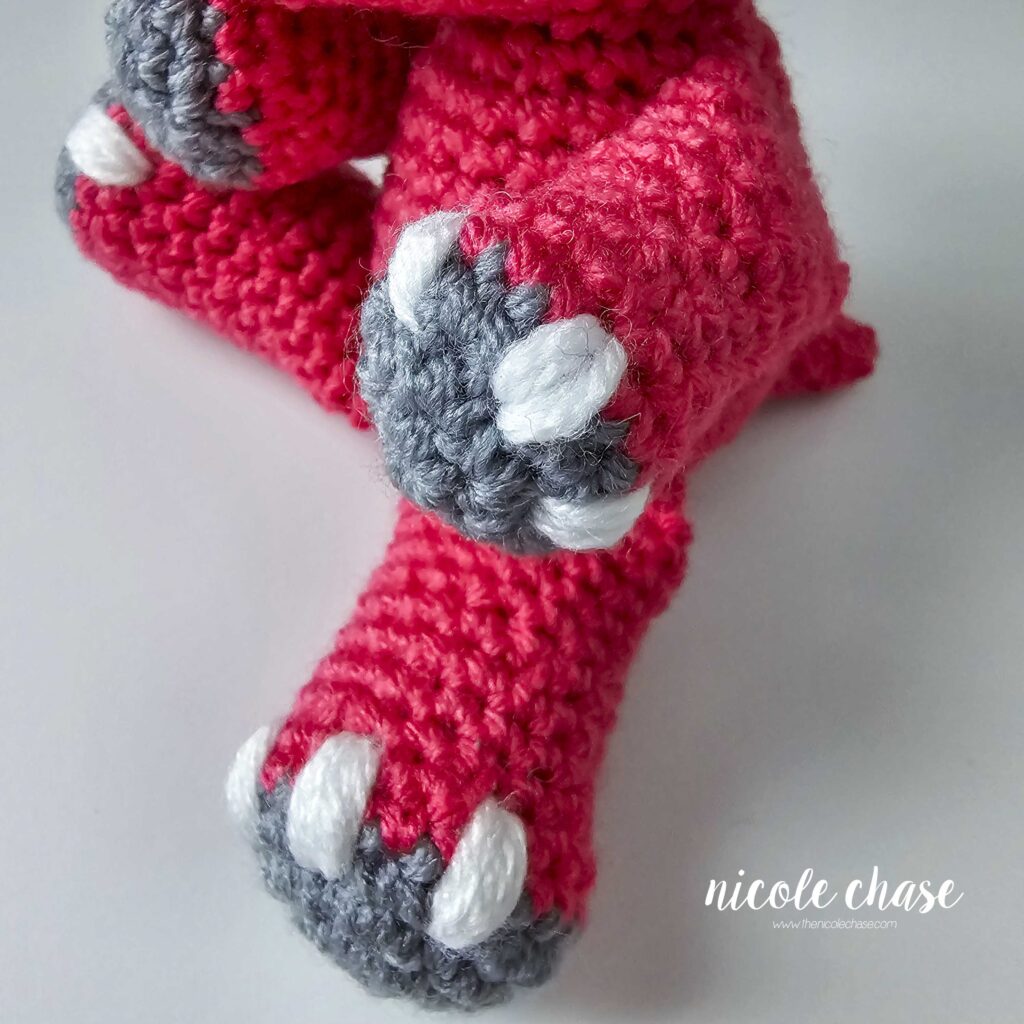
Attach tail over R4-8, on the back of the body.
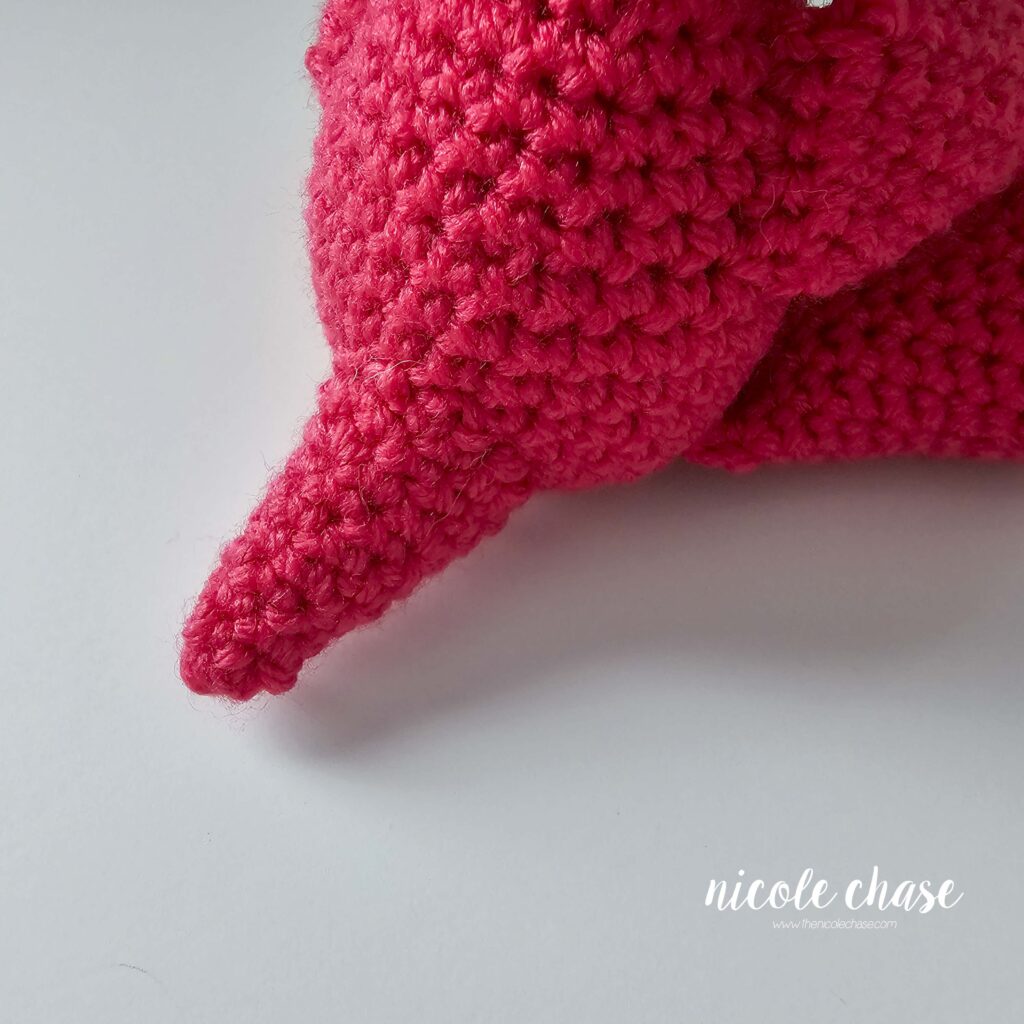
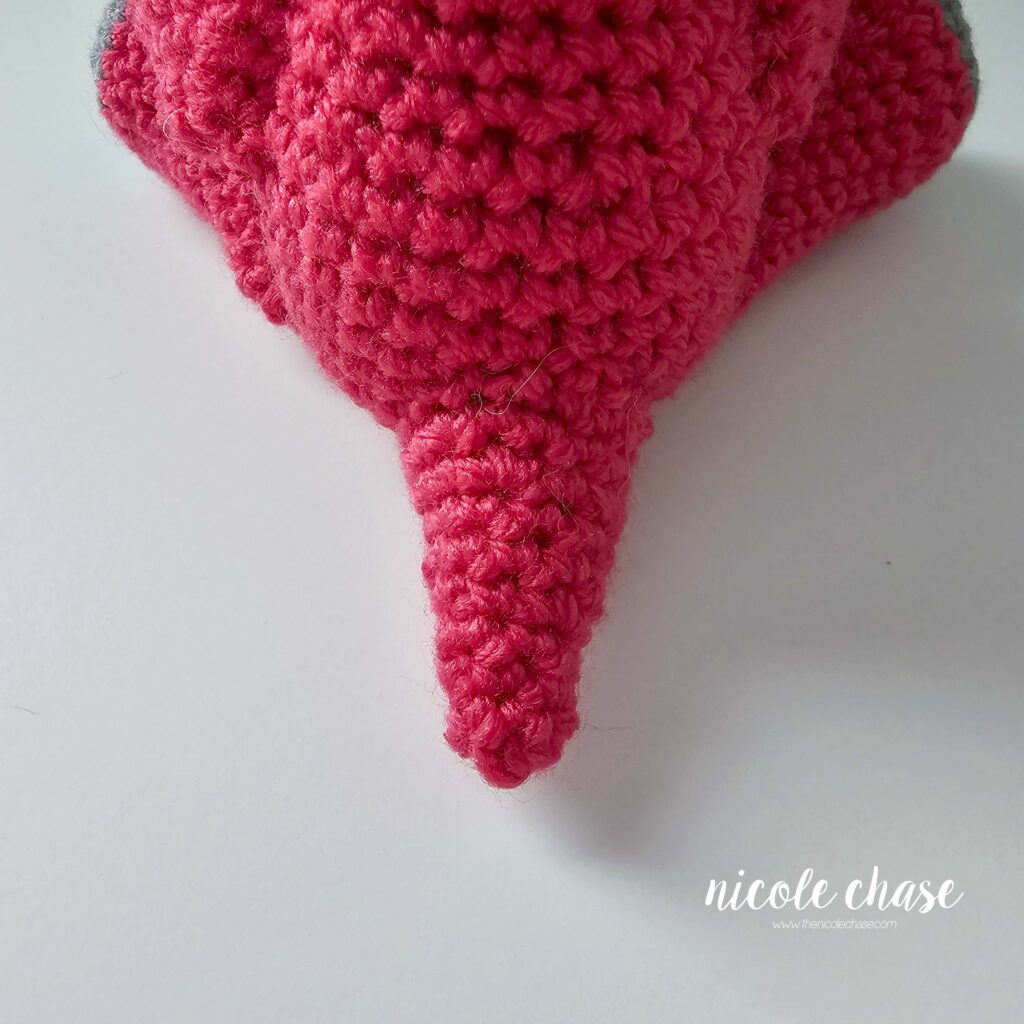
I hope you enjoyed this free Mini Tanner the Triceratops crochet pattern!
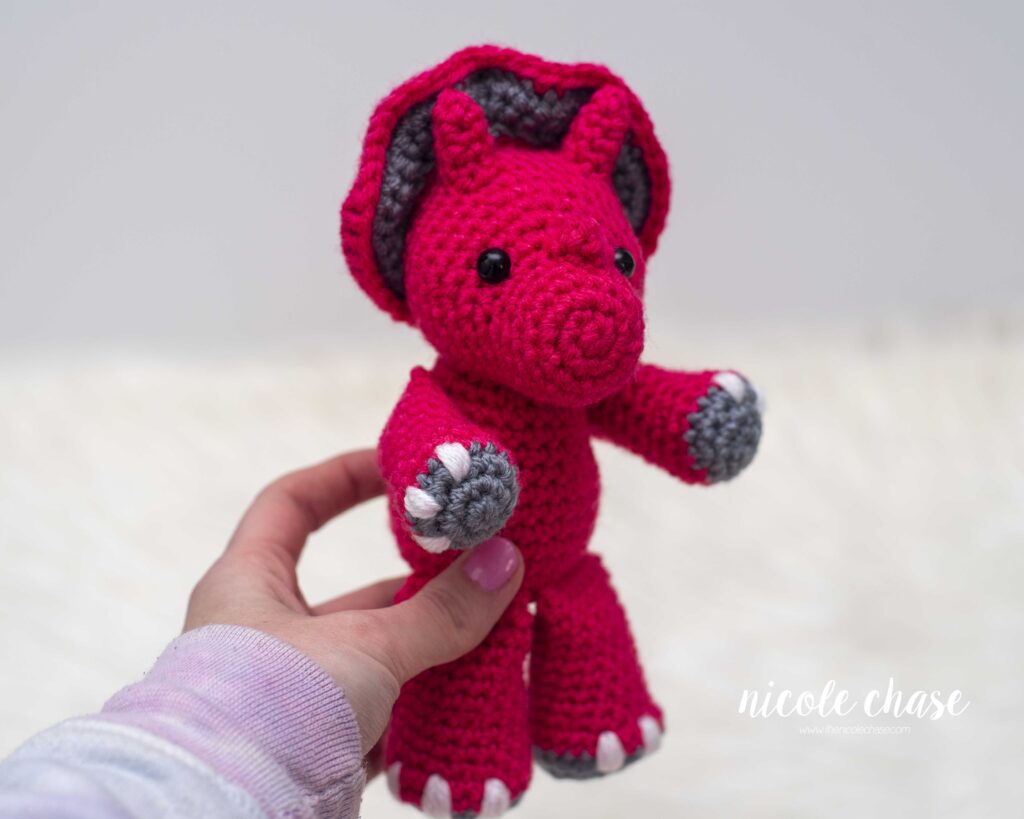
Video Tutorial for Mini Tanner the Triceratops
This video is also available on YouTube. Watch this video: Mini Tanner the Triceratops Amigurumi Crochet Tutorial on YouTube.
Ad-Free PDF Pattern for Mini Tanner the Triceratops
Amigurumi Tips & Tricks for your Mini Triceratops
- Use stitch markers to keep track of your continuous rounds when making this free mini triceratops crochet pattern.
- Use pins to hold the pieces of your crochet triceratops when sewing to keep your pieces in their desired placement.
- This list of amigurumi tips and tricks are great to follow for your crochet triceratops and all your other amigurumi projects.
Alterations for the Small Triceratops Crochet Pattern
- Use this free strawberry modification with this small triceratops crochet pattern to make a strawberry crochet triceratops!
- Make a candy corn crochet triceratops version of Mini Tanner with this free pattern modification to this mini triceratops crochet pattern and other dino patterns.
- For a Christmas themed version of this crochet triceratops dinosaur, check out the Christmas tree cake dinosaur pattern modification!
- For a larger crochet triceratops, check out the free crochet pattern for the original Tanner the Triceratops.
- Use a plush yarn like Parfait Chunky to create a larger amigurumi dinosaur with this free crochet triceratops pattern. Pro Tip: Learn more about choosing the right hook size when switching between different yarn weights!

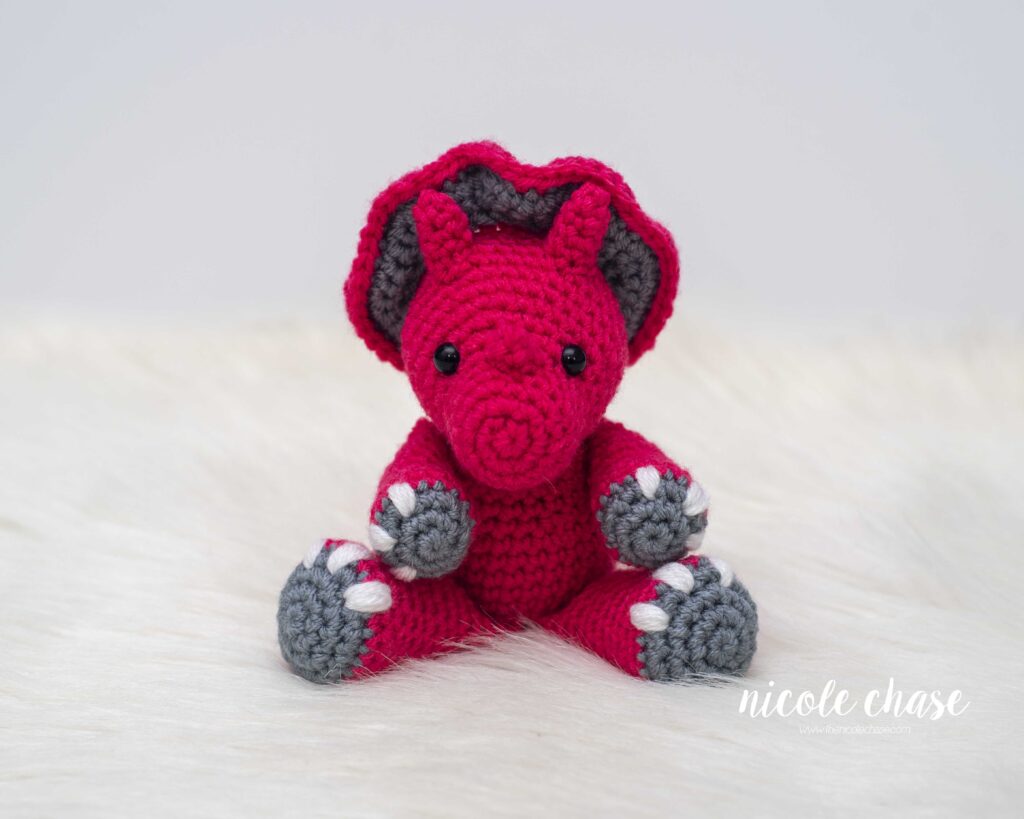
More Free Dinosaur Crochet Patterns
I hope that you enjoyed this free mini crochet triceratops pattern! If you love dinosaurs as much as I do, and want to crochet more amigurumi dinosaurs, check out my full collection of dinosaur crochet patterns. You may especially enjoy some of my other mini dinosaur crochet patterns; here are a few of my favorites:
- Small Stygimoloch Crochet Pattern
- Small Parasaurolophus Crochet Pattern
- Small Pterosaur Crochet Pattern
Want more animal inspiration? Find this pattern in my ultimate list of free crochet animal patterns!
First published April 2021.
I hope you enjoyed this pattern! If you make it, leave me a comment below.
Want to see more from me? Be sure to subscribe to my email newsletter so that you never miss a pattern!
Follow along with me on Instagram for daily updates and a behind the scenes look at my designs.
I’d love to see what you make with this tutorial! Don’t forget to share your finished work with me: on social media by tagging me @thenicolechase, in your Ravelry projects, or post over in my Facebook group!
Thanks for stopping by! Happy crafting!
Nicole
PATTERN COPYRIGHT © 2025 NICOLE CHASE. ALL RIGHTS RESERVED.
PATTERN MAY NOT BE ALTERED, COPIED, REDISTRIBUTED OR SOLD AS YOUR OWN PATTERN.
YOU MAY SELL THE FINISHED PRODUCT ON A SMALL SCALE. PATTERN/DESIGN CREDIT GIVEN TO WWW.THENICOLECHASE.COM IS APPRECIATED. PERMISSION TO SELL DOES NOT INCLUDE MASS PRODUCTION. LARGE SCALE PRODUCTION IS PROHIBITED.
PHOTOGRAPHY COPYRIGHT © 2025 NICOLE CHASE. ALL RIGHTS RESERVED.
PHOTOS MAY NOT BE ALTERED, COPIED, REDISTRIBUTED OR SOLD AS YOUR OWN.
This post may contain affiliate links. If you make a purchase through links on our site, we may earn a commission.

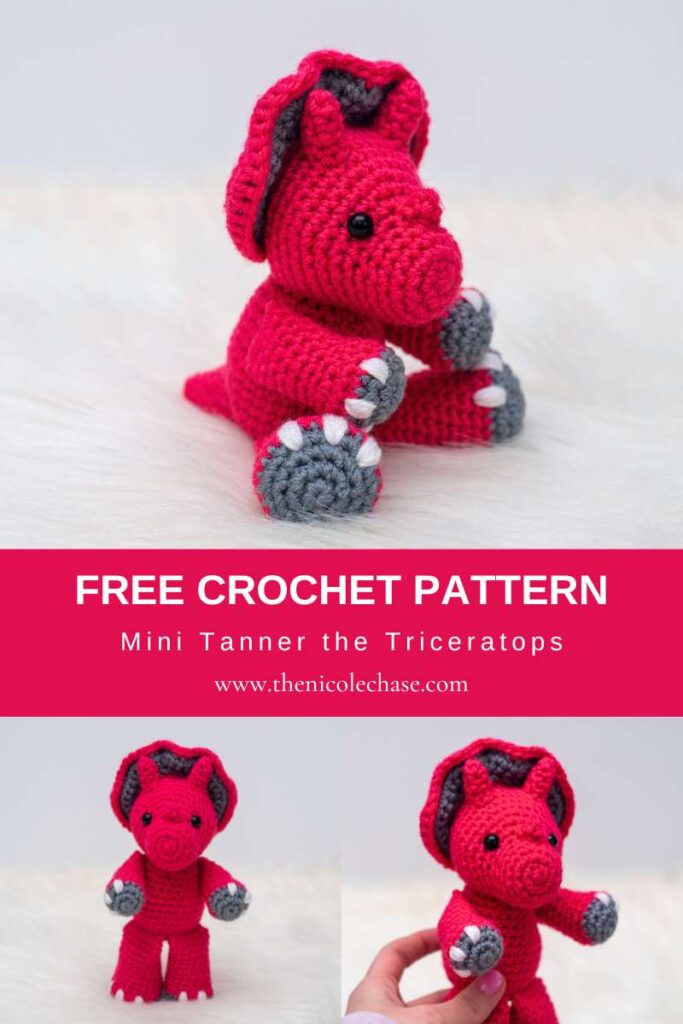

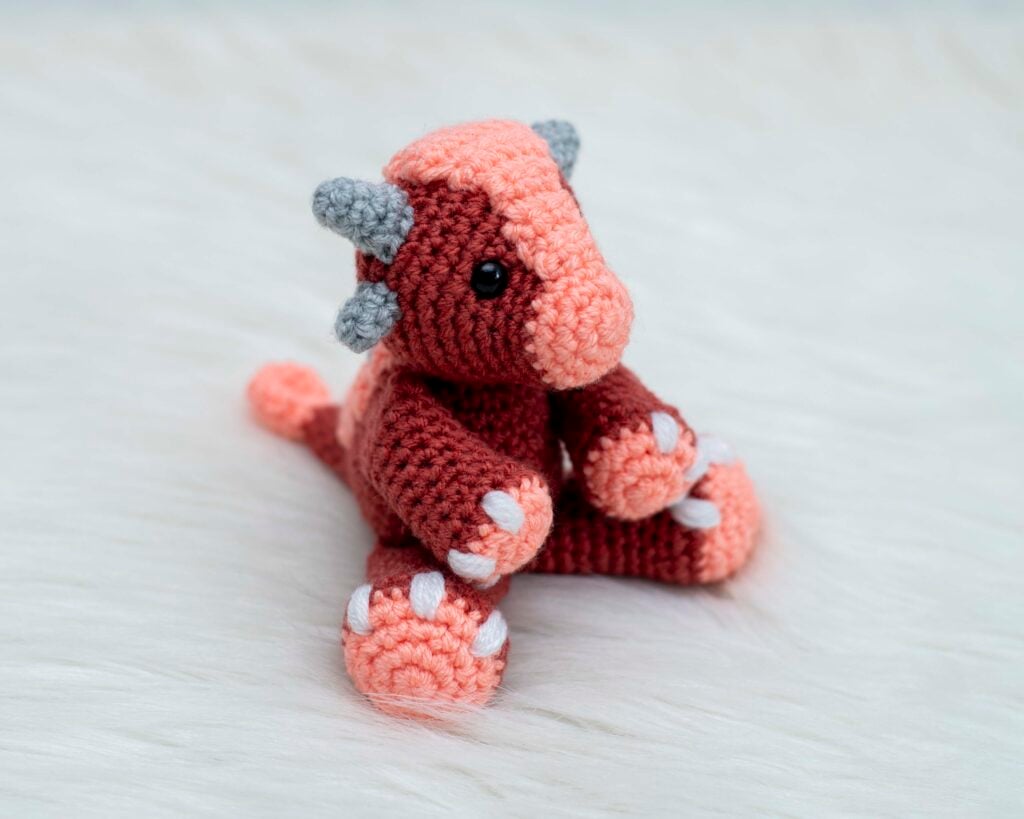
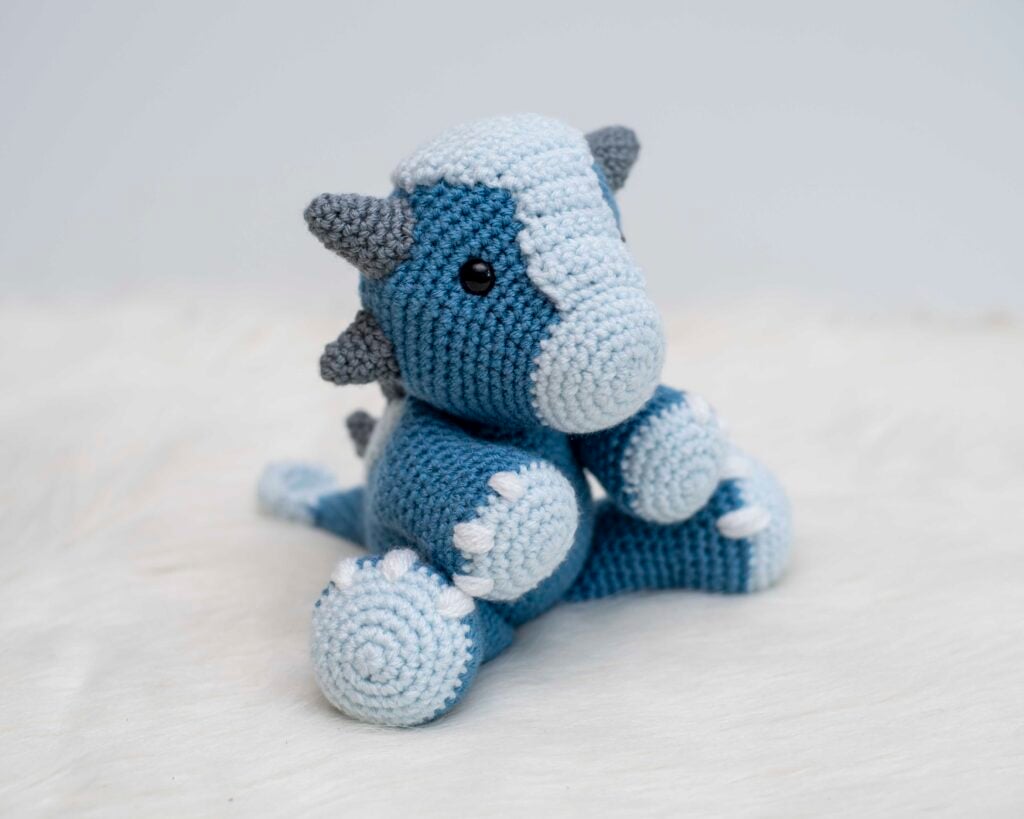




Hi Nicole.
When you use the Parfait Chunky yarn, do you size up your hook?
This pattern is so cute, I can’t wait to begin!
Hello! Yes, when I use Parfait Chunky I generally use a 5mm crochet hook. I hope you enjoy the pattern!
Hi Nicole,
I’m a bit lost on Rd 4 of stitching the two frills together. Can you clarify which four corners you’re describing that require three single crochets? What is the approximate stitch count needed to do three single crochets?
Hello! If you were to attempt to lay out the frill into as close to a rectangle as it could be, those are the 4 corners. I have a full video tutorial for this pattern which should also be able to help!
Any tips for attaching the frill? it seems to be harder than i thought.
Hi! Have you tried using pins to hold it in place while you sew? That way it doesn’t move around while you’re sewing. Hope that helps!